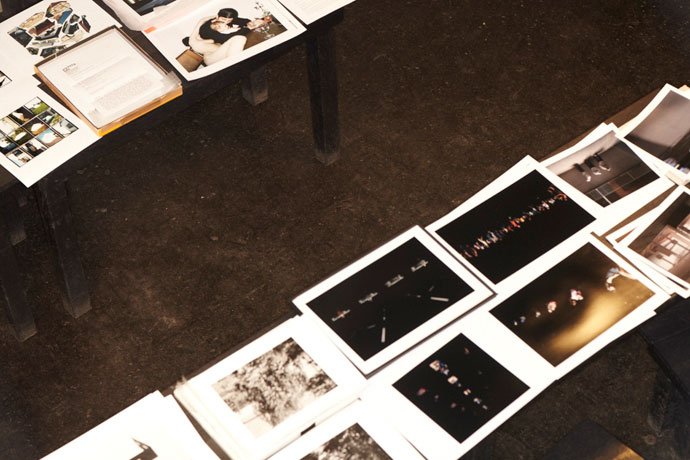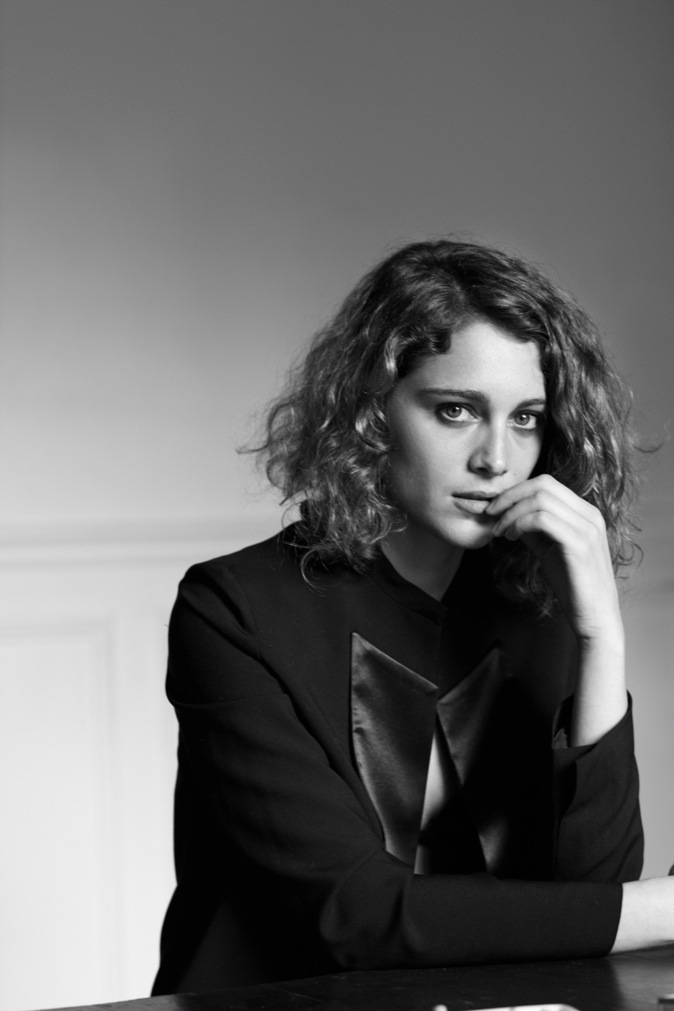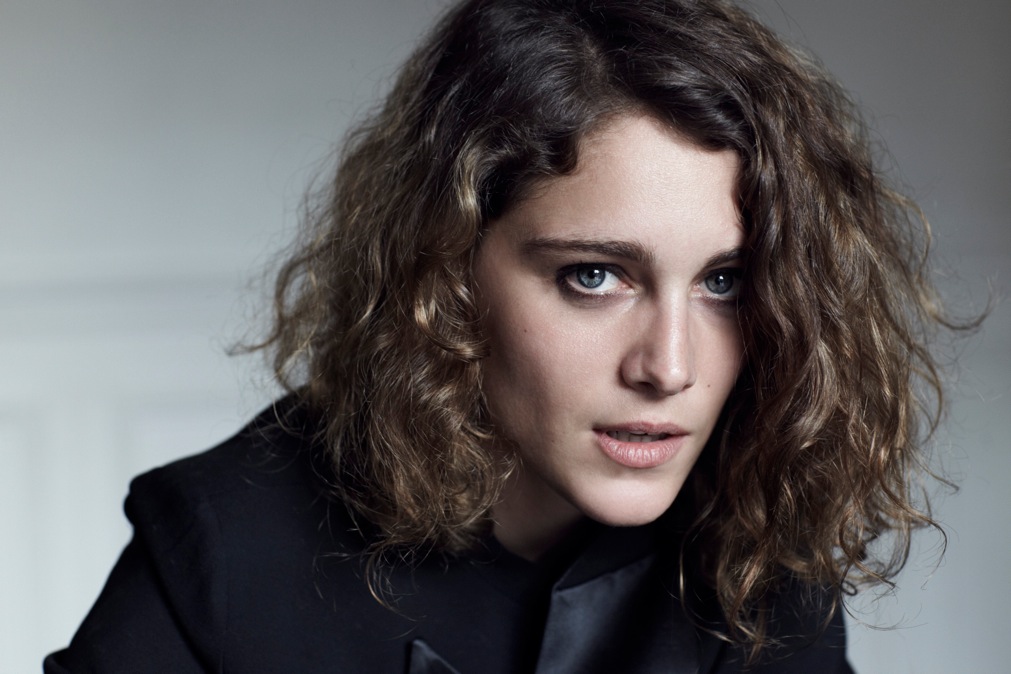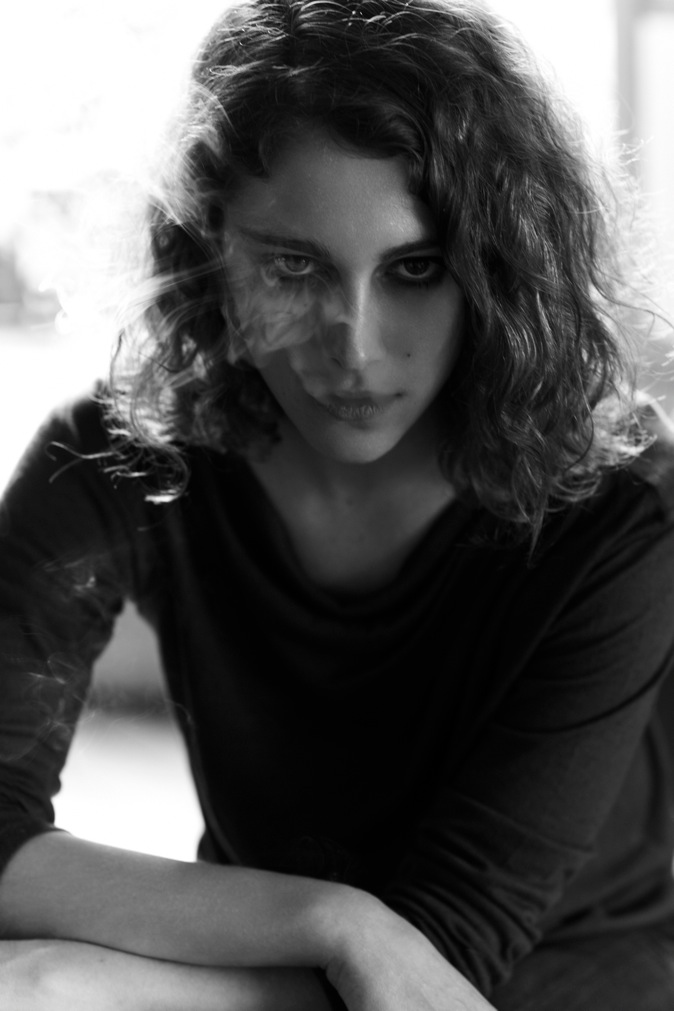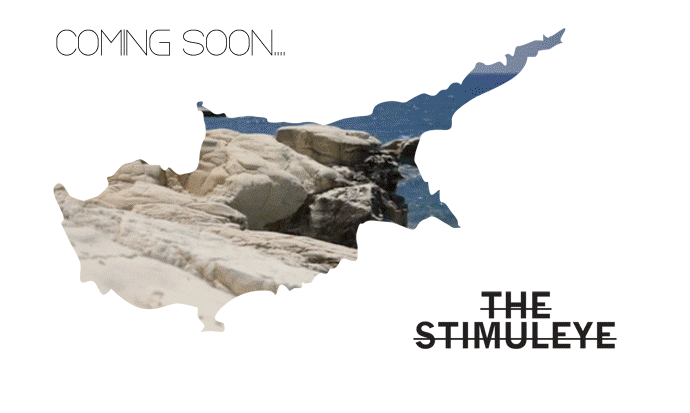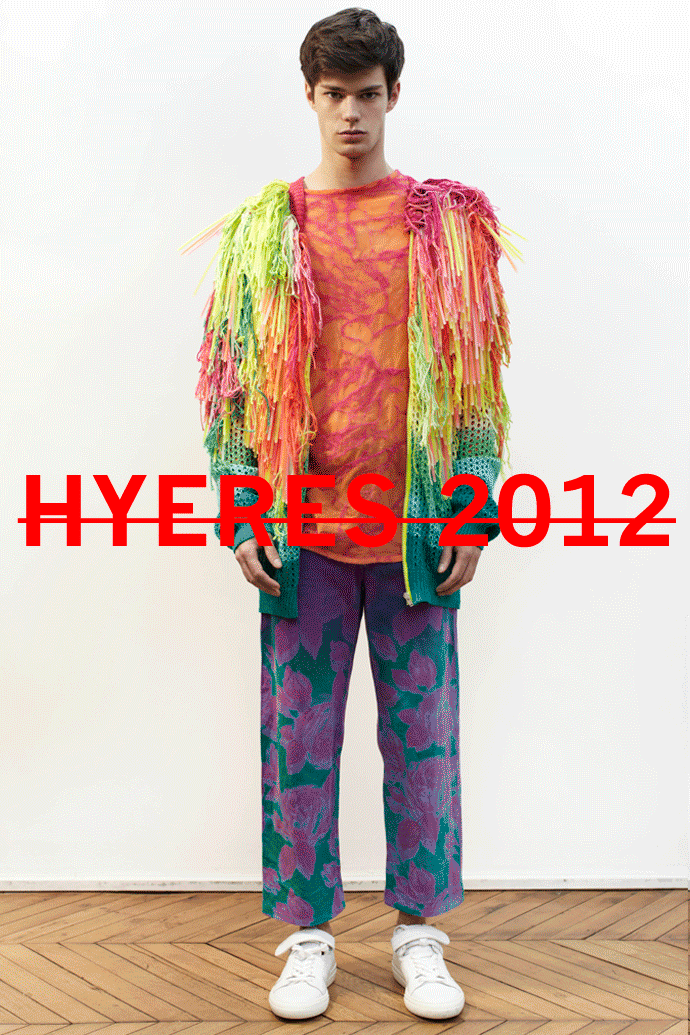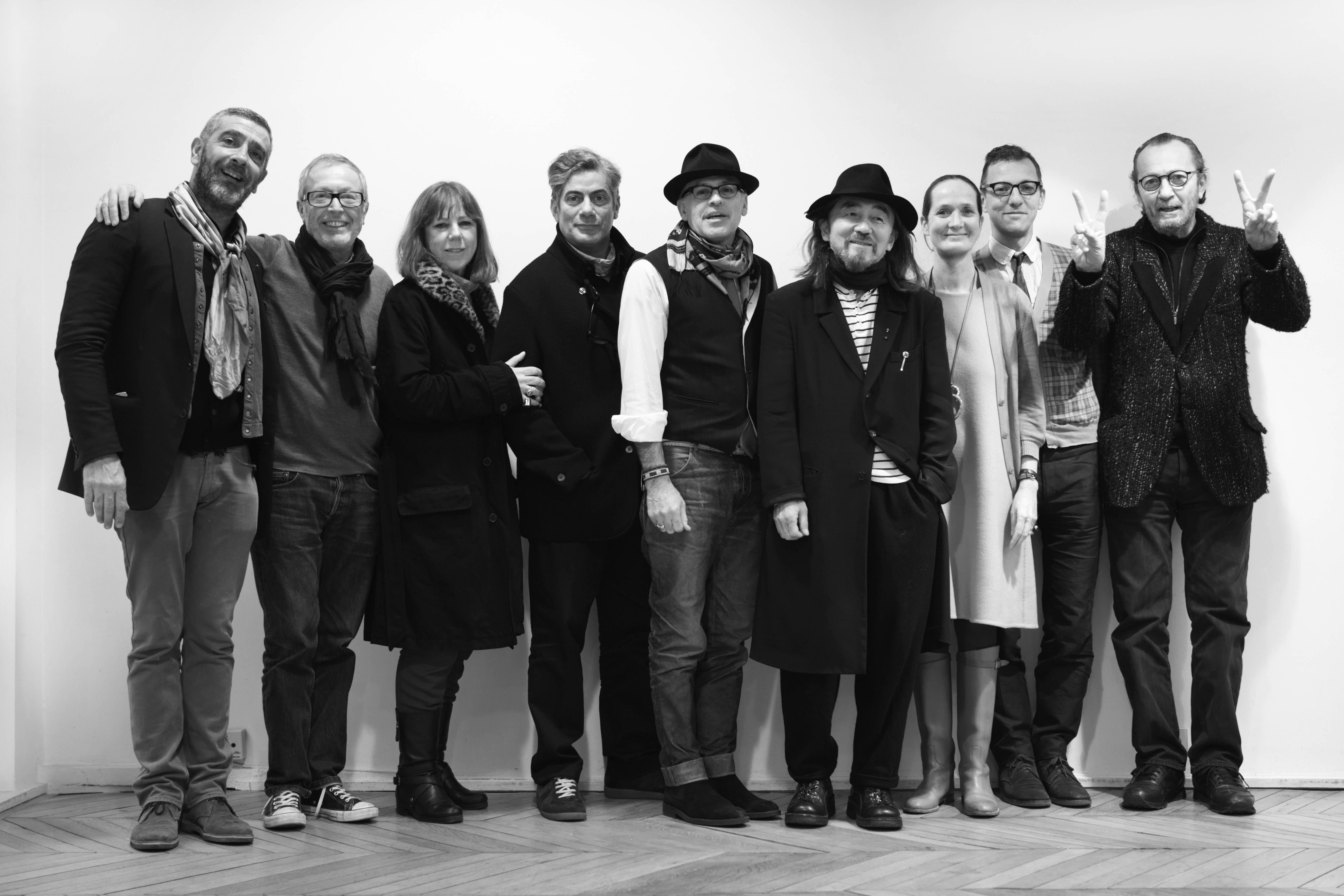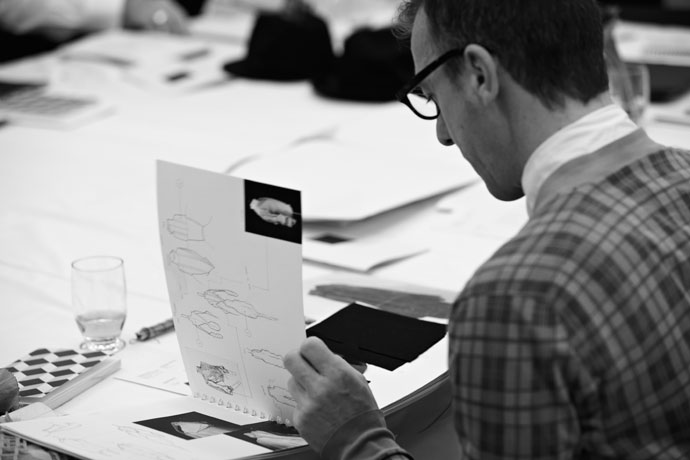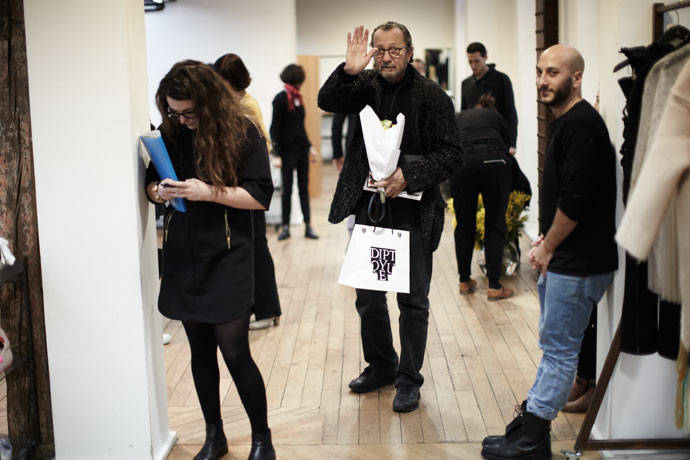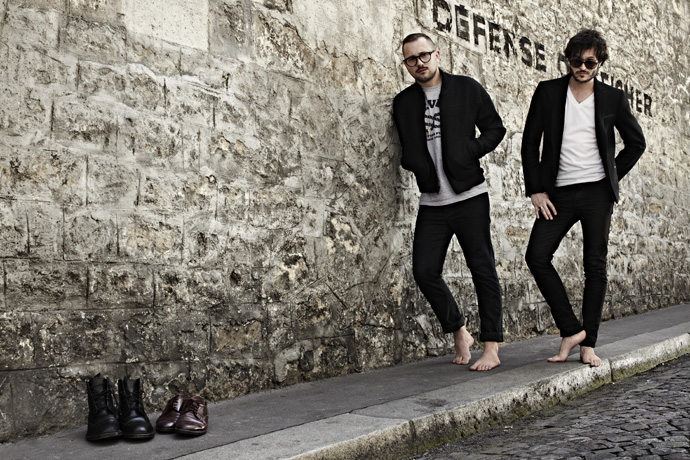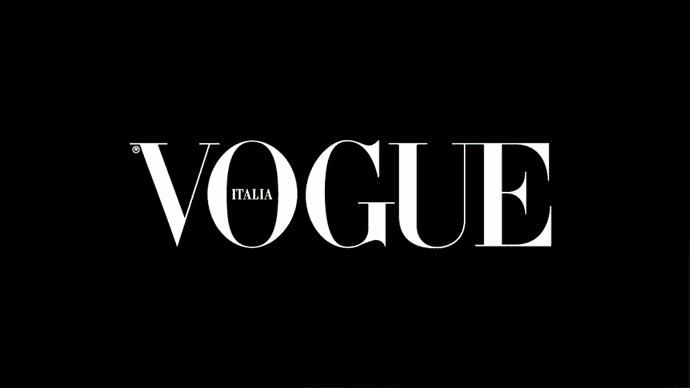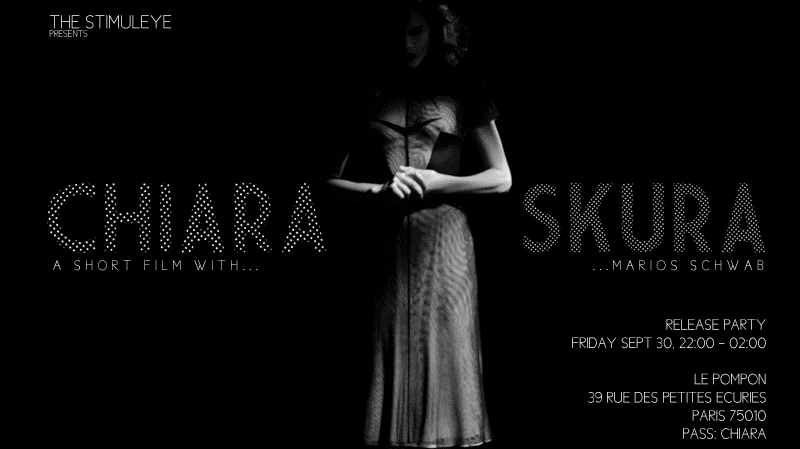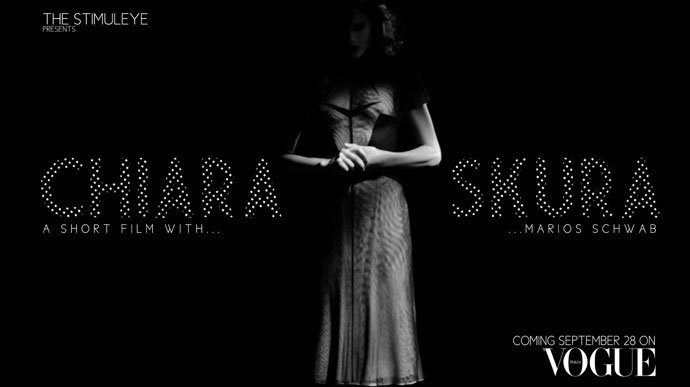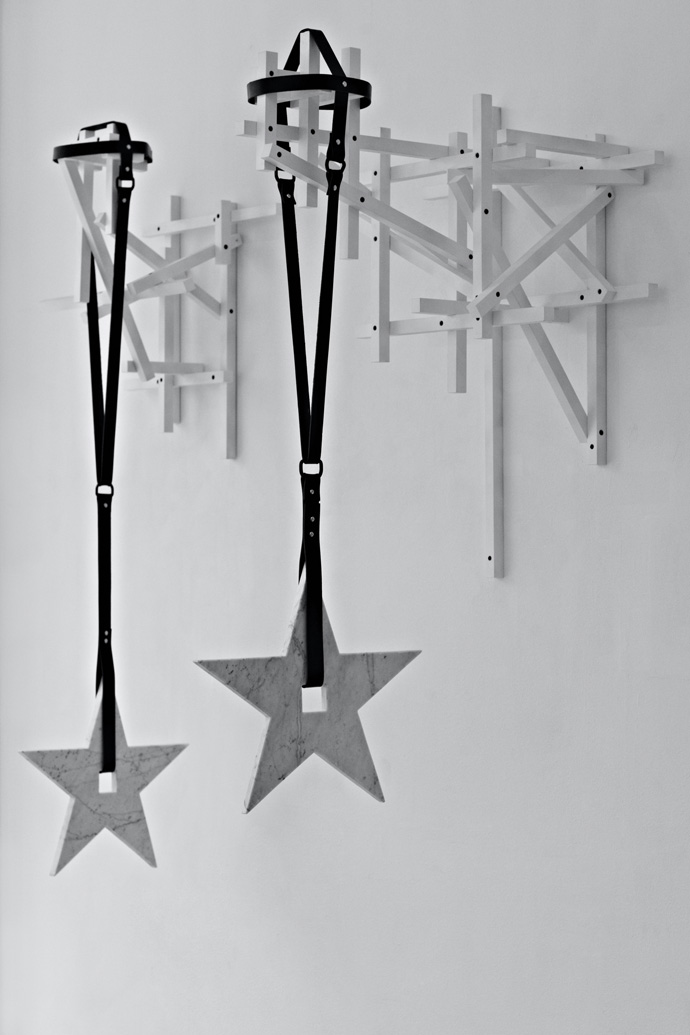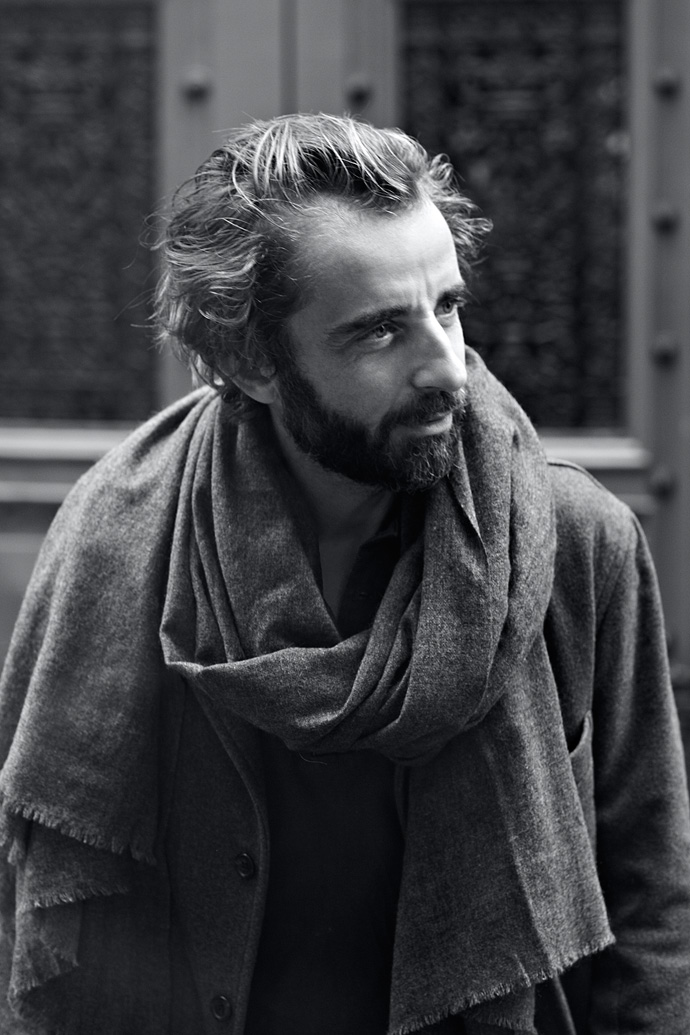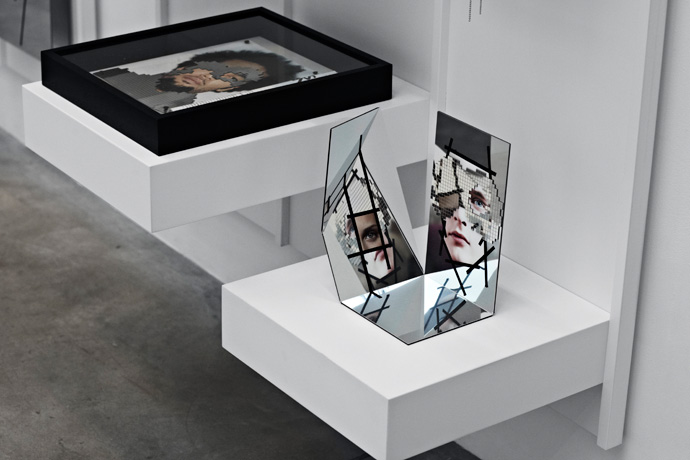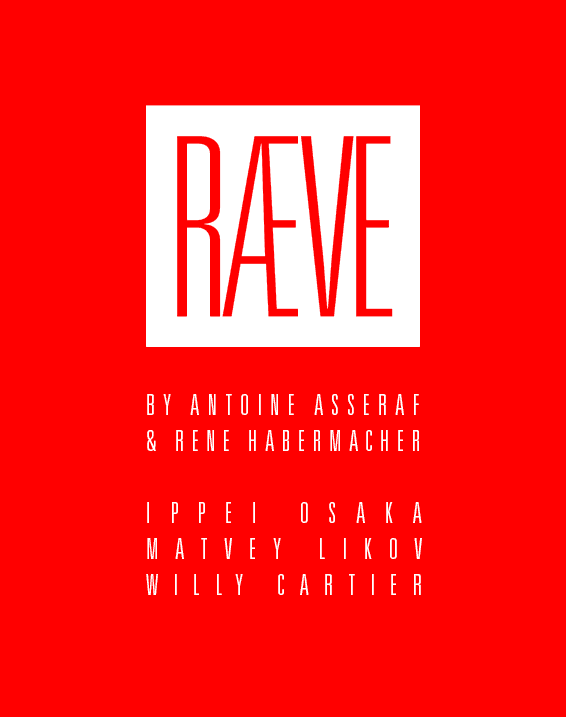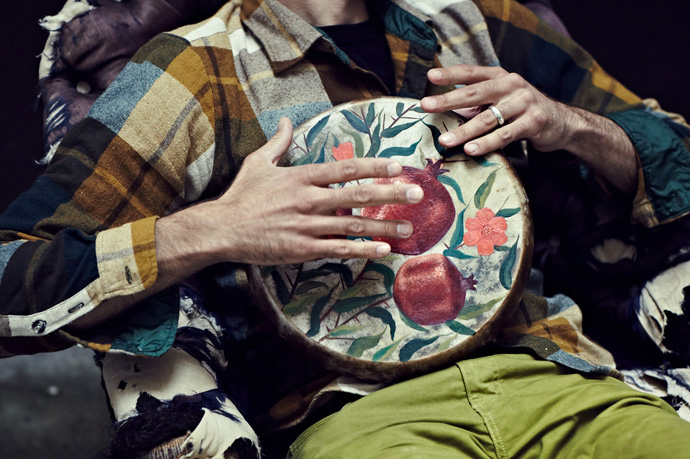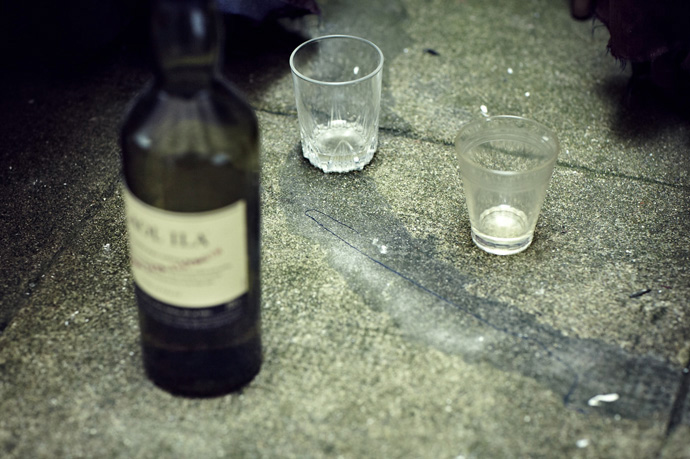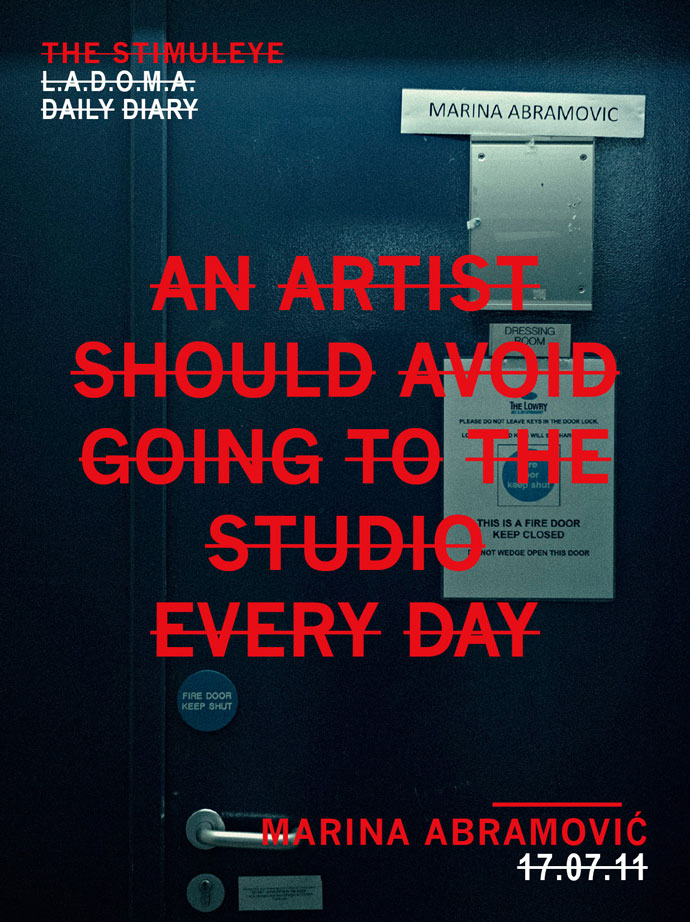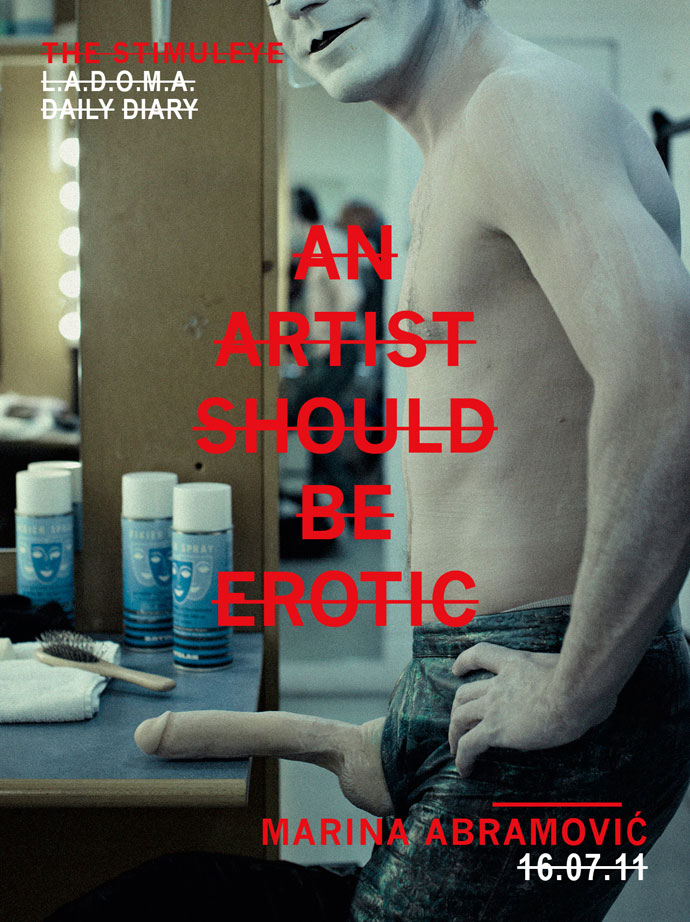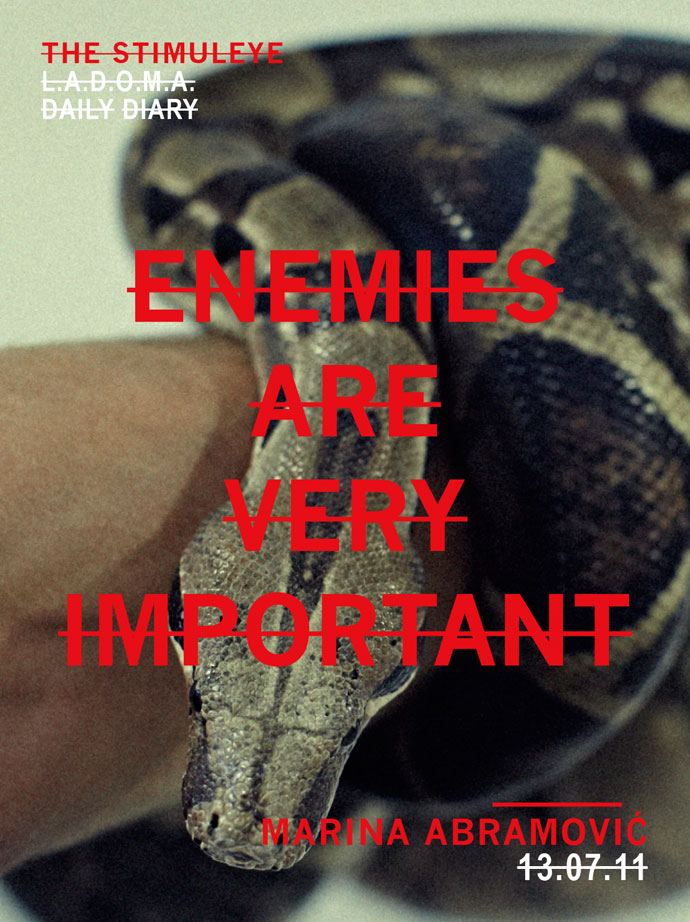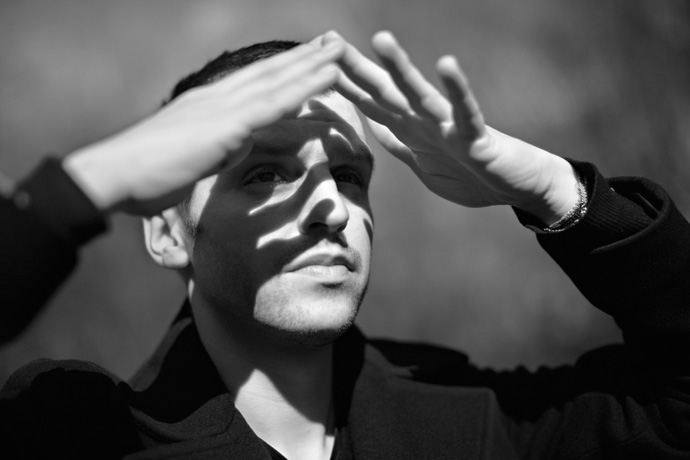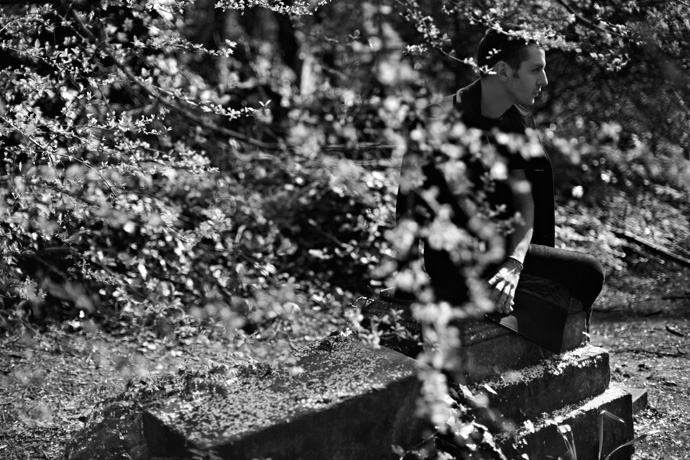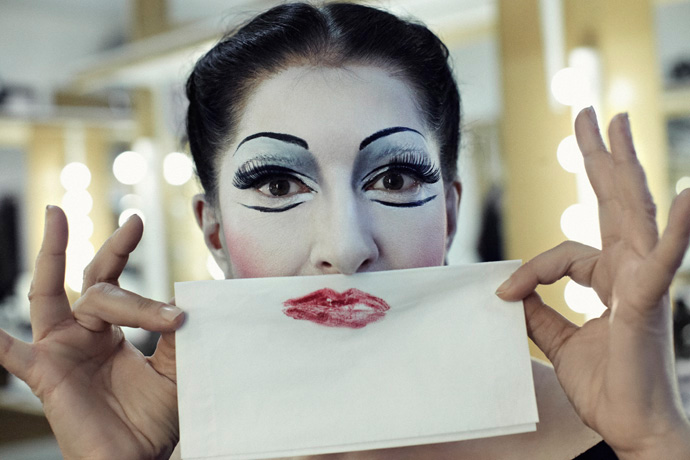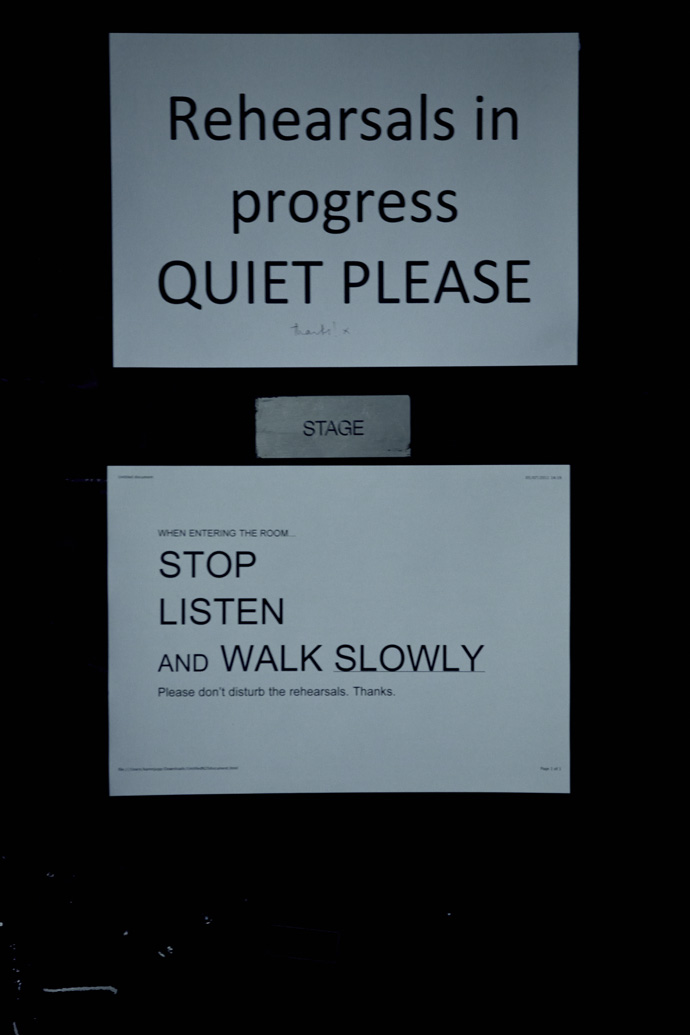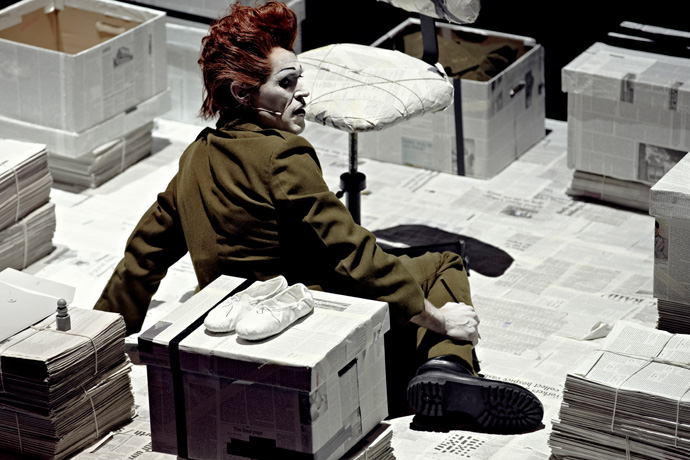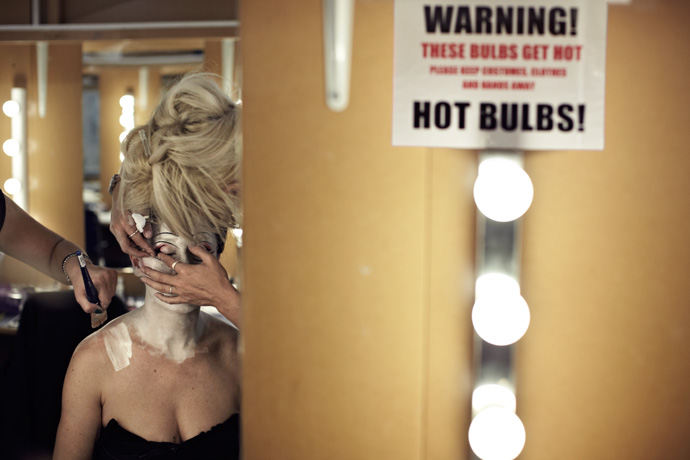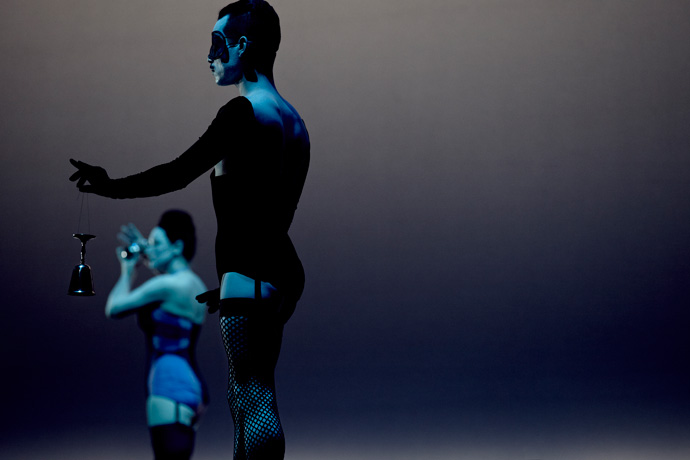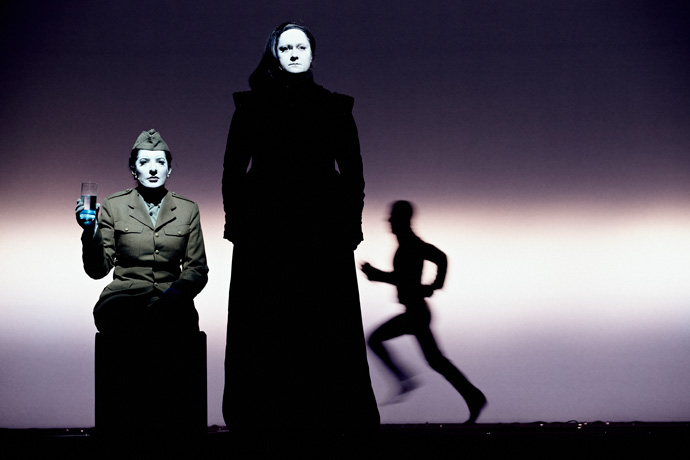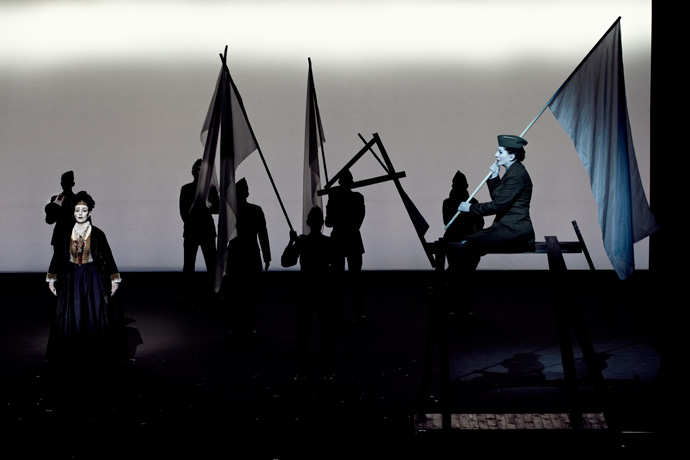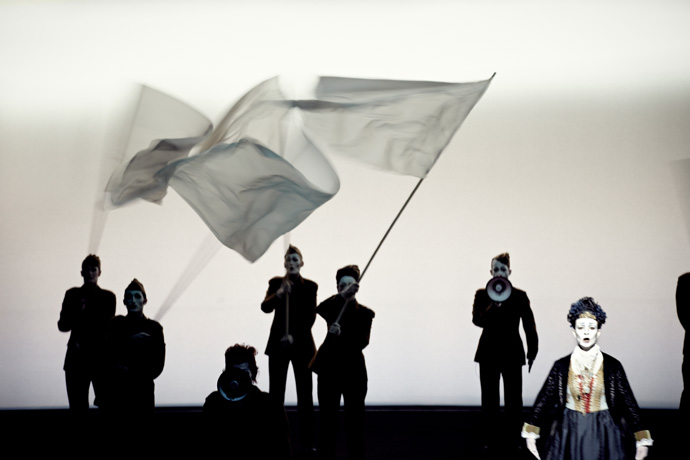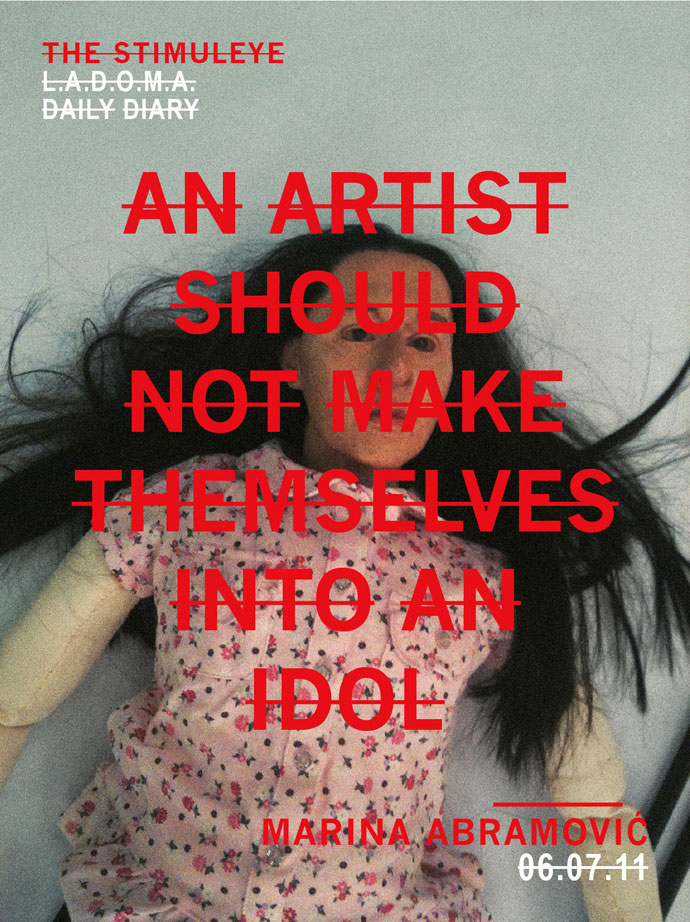-

films of the season 2: My Garden starring Kiko Mizuhara
-Part 2 of our spring fashion film series takes us to Vietnam, a land of mysterious fruits and exotic flowers.
Norwegian Wood actress, Towai Tei-singer, and model Kiko Mizuhara lets us into her garden,
for Vivienne Tam.00 -

films of the season : CHIARA SKURA
-Spring is in the air, so the time has come to see the films of the spring-summer collections which will soon hit the stores… A little wishful thinking has never hurt, has it ?
First up: Marios Schwab and his dark yet summery, very Lana Del Rey, “Chiaroscuro” collection, starring himself alongside Amy Bailey, in Antoine Asseraf & René Habermacher’s CHIARA SKURA.
-

contest: beyond the wall
-For the 27th edition of the Hyères Fashion + Photo Festival, The Stimuleye presents choreographer Lynsey Peisinger’s PILLORY, a performance/video/installation hybrid.
Submit your 30 seconds maximum video before April 1st for a chance to have it featured in the installation, which launches April 27th at the 2012 Hyères Fashion + Photo Festival, next exhibits by Yohji Yamamoto, Jasons Evans, and Inez van Laamswerde + Vinoodh Matadin.
Imagine what lies beyond the wall of the PILLORY installation.
All submitted videos must be
no more than 30 seconds long,
from one angle/point of view,
and submitted before April 1st, 2012.Fore more info and video guidelines: contest@thestimuleye.com
-

must see: guy maddin’s spiritismes
-Damned movies, cinema legends, performance, a trance…
Guy Maddin’s new project at Centre Pompidou, featuring Ariane Labed and other stars such as Mathieu Amalric, Amira Casar, Udo Kier and Charlotte Rampling, has all the right ingredients, and best of all, is open for all to see.
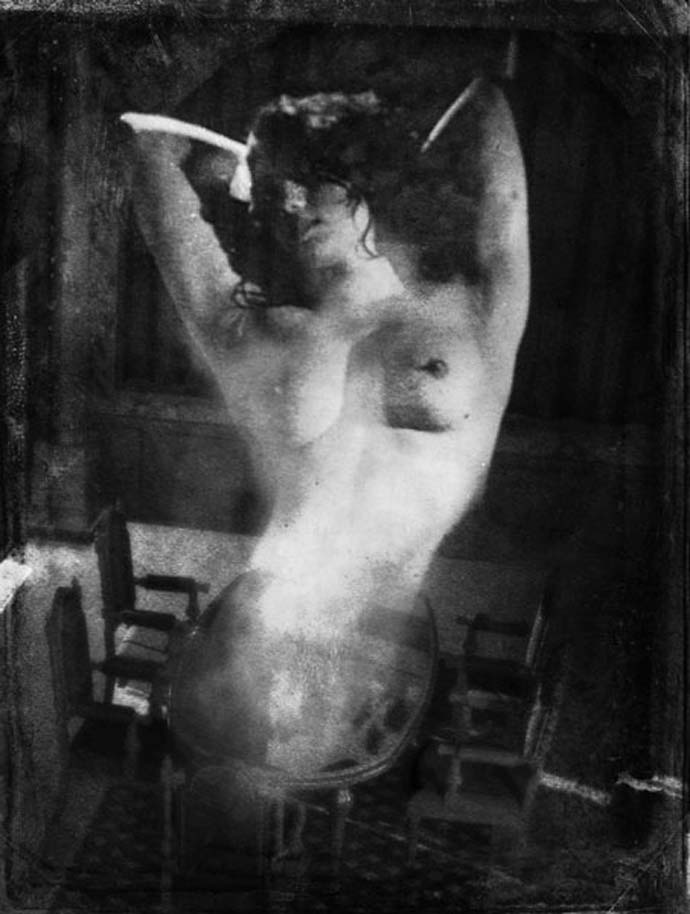 Collage by Galen Johnson for SPIRITISMES.
Collage by Galen Johnson for SPIRITISMES.Cult Canadian film-maker Guy Maddin invites anyone in Paris or with an internet connection to follow him and his actors live as they meditate and then shoot lost, unreleased or unfinished films by the likes of Hitchcock and Eric von Stroheim…
More info on the Pompidou Center website.
Follow the shoot live with 3 cameras on the Nouveau Festival / Spiritismes website.
-

HYERES 2012, the photo selection
-How do you reduce 782 applications into a curated selection of 10 photographers ?
Where is photography going today ?
Can the promise of future creation outweigh present output ?I wouldn’t want to have to answer those questions, but the Hyères photo jury had to.
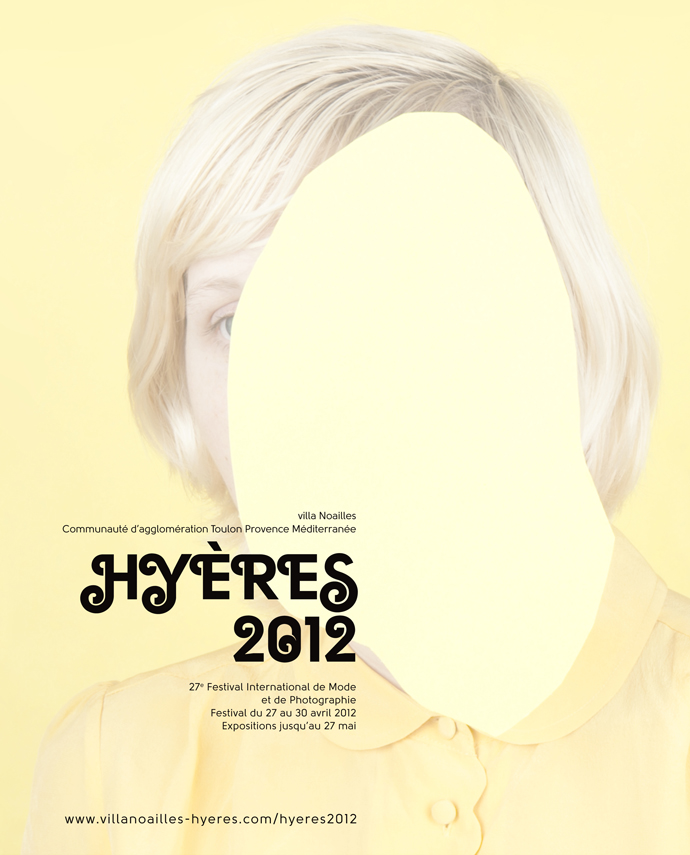 Hyères 2012 visual, featuring the work of 2011 contestant Ina Jang.
Hyères 2012 visual, featuring the work of 2011 contestant Ina Jang.Photographers, curators and critics met under the guidance of photography director Michel Mallard and his team on January 31st to chose 10 photographers whose work would be featured at the 27th edition of the Hyères Fashion + Photo Festival, a festival which revealed in the past talents such as Sølve Sundsbø, Cédric Buchet, Robbie Rodriguez, Caroll Taveras, Linus Bill and 2011’s winner Anouk Kruithoff.
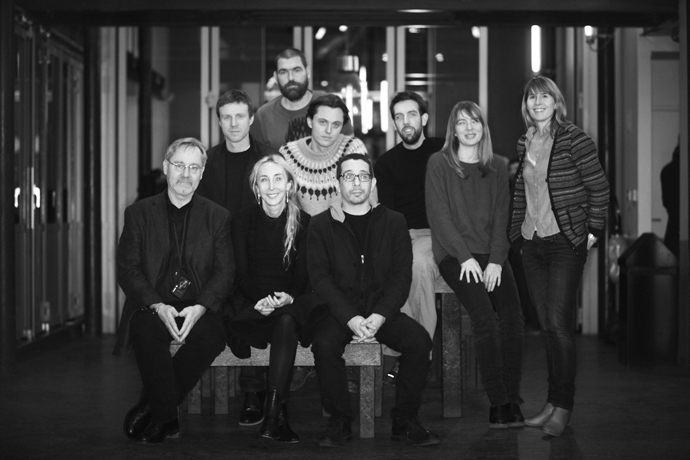 The 2012 photo jury, first row from left to right: Michael Wolf, Carla Sozzani, Michel Mallard,
Second row: James Reid, Aaron Schuman, Hans Gremmen, Raphaelle Stopin, Anne-Céline Jaeger,
Back: Jason Evans.
The 2012 photo jury, first row from left to right: Michael Wolf, Carla Sozzani, Michel Mallard,
Second row: James Reid, Aaron Schuman, Hans Gremmen, Raphaelle Stopin, Anne-Céline Jaeger,
Back: Jason Evans.So first they looked.
Then they talked.
And finally they argued.
And then they questioned their choice and started the process all over.
Until at last, they had 10 photographers, from 3 continents.Of course, come April 27th when the festival starts, these photographers will be competing for the jury’s attention, engaging in a series of one on one interviews and portfolio discussions in the Villa Noailles’ covered galleries, facing a cubist garden.
And yet the ability to spend quality time with high level professionals, to be exhibited next to the works of other 2012 exhibitions such as Inez van Laamswerde + Vinoodh Matadin and Jason Evans is a reward in itself…
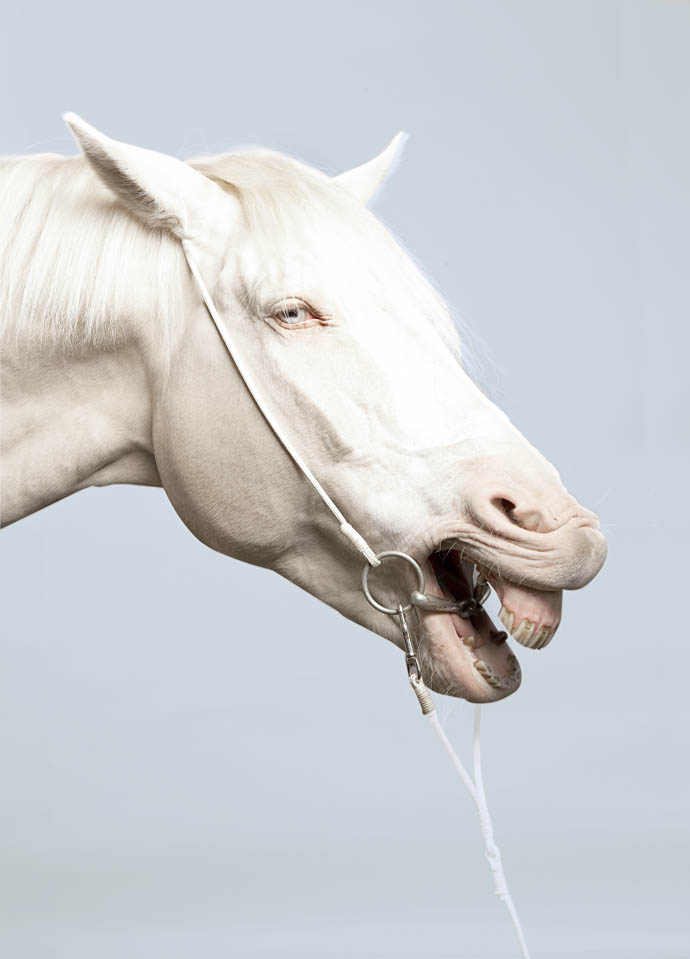 Photo by 2012 contestant Olga Cafiero.
Photo by 2012 contestant Olga Cafiero.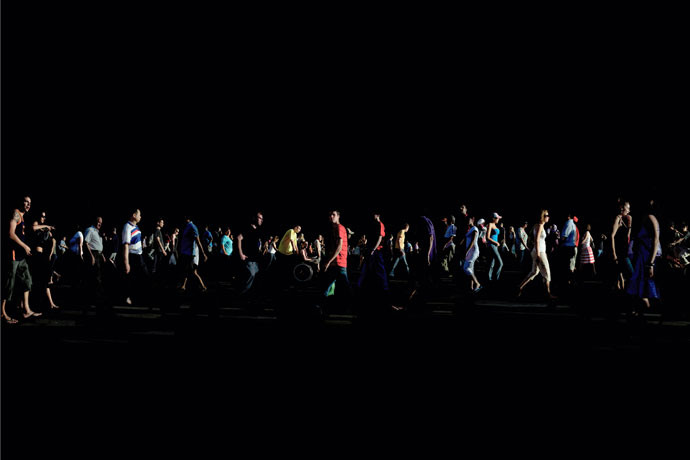 Photo by 2012 contestant Manuel Vazquez.
Photo by 2012 contestant Manuel Vazquez. Photo by 2012 contestant Brea Souders.
Photo by 2012 contestant Brea Souders. -

ariane labed
-She’s French, but she acts in Greek.
ATTENBERG was her first film, but it won her a Lion at Venice in 2010 for Best Actress,
and the admiration of Quentin Tarantino and Sofia Coppola.
She loved the shooting, but hated the fame which followed.Introducing Ariane Labed in
ARIANE
an exclusive film by Justin Anderson,
in collaboration with THE STIMULEYE and Giorgio Armani,
and original pictures by René Habermacher.ARIANE, directed by Justin Anderson. Clothes - Giorgio Armani. Furniture - Armani Casa. Commissioned by THE STIMULEYE.
Antoine Asseraf : Bonjour!
Ariane Labed: Bonjour!
Are you currently in London ?
Yes, finally! I was supposed to move to London last September, but I’ve been moving around nonstop!
Do you often go back to Greece ?
I was in Greece in November to play with my troup VASISTAS, but now I’m more between Paris and London.
When did you first come to Greece, and what was your impression of the country at the time ?
I arrived in Greece 3 years ago, for a 9-month project of my troup with the National Theater of Athens, to put on a Faust.
I was born in Greece, lived there until I was 6, and I think I left part of my childhood there.I dreamt of returning. When I met Argyro Chioti in college, a Greek theater director with whom we created the troup VASISTAS, I jumped onto the opportunity of going.
So instead of 9 months, I stayed for 3 years, meeting Athina [Rachel Tsangari] and Yorgos [Lanthimos] had something to do with hit. Beyond a purely sentimental attachment to this country, I was impressed by all the artists I met and their urgent need to create. Without expectations of getting anything in return, beyond any judgement to which they could be subjected, beyond thinking about breaking even.
If I have just left, it’s only because I need to live in a country where I feel foreign, where I lose myself in the streets. That’s what I’m doing in London. The day where I won’t lose myself anymore, I will leave again.
But I will always return to Greece.
Ariane Labed by René Habermacher.
The films of Yorgos Lanthimos and Athina Rachel Tsangari in which you starred have universal resonance, but we can nevertheless imagine that they come in a context, in reaction to precise things happening in Greek society: the influence of the Orthodox church (the impossibility of cremation), the need to break the myth of Greece as a postcard-perfect location (the desolate landscapes of Attenberg)…
As you said yourself the Greek audience doesn’t really support these films, and when reading the article in THE GUARDIAN regarding New Greek Cinema I found the comments left by the Greeks to be very virulent – do you think the films play a role in questioning Greek society ?
If Greeks have a difficulties situating themselves in films such as Dogtooth or Attenberg, it may be because they carry a truth about their country which hurts.
This young generation carries with them the failure of the previous generation, a generation who thought they offering through a notion of “progress”, and after the military dictatorship, a better life, without taking into account the contradictions of orthodox culture and the desire for revenge after several centuries of hardship when the Greek people were a strange gate to the East.
Being French, I love all these contradictions about Greece, but that is also where the complexity lies, and these are facets which the new generation denies or which the previous cannot accept.
What I also love in Greece is that it’s non-colonial, as luckily they could never afford to be colonial, but it is painful to see and hear the Greek racism against the recent wave of immigration. I think the Greeks are overwhelmed by a lot of things today, and it’s evidently linked to the government which “enjoyed” European aid for decades, including the Olympics of 2004.
Though all this is probably only the beginning of what is slowly happening all over Europe.
ATTENBERG by Rachel Athina Tsangari - Trailer. Best Actress award at 2010 Venice International festival.
The beautiful thing about this chaos is that, these artists, without means, who expect nothing from the government, find the strength to meet and trust each other enought to creat together. That’s the case for HAOS, the production company created by Athina, which led to collaborations with Yorgos Lanthimos on DOGTOOTH and ALPS, and EMBROS, a new squat which just opened and brings together theater, danse, performance, critiques, writers, etc… Greek artists have never collaborated as much as they do today.
Of course the films of Athina [Rachel Tsangrai] and Yorgos [Lanthimos] carry and will continue to be denounced by a society which closes its eyes, much like other Western socities. That may be why they are recognized abroad but considered “weird” and barely tolerated in their home country. The taboos touched upon in Attenberg – death, cremation, incestuous desire, lesbian sexuality, are topics on which one can hardly have a dialog in Greece.
But it is difficult for me to criticize Greece… Beyond the corruption of the government and the misery into which it has dragged the people, which I can intellectually denounce, there remains for me an unspeakable element, a vibration I feel only there. A chaos which I find appeasing.
Ariane Labed by René Habermacher.
How did you live this experience of the “fashion film”, between actress and model, with Justin Anderson ?
I was quite reticent at first… but once I met Justin [Anderson] and he told me the concept, with the slow motion, I became quite excited. In the end it was a beautiful experience.
What are your current projects ? Can you tell me about your play with VASISTAS ?
The big news is that I’m about to shoot a film in France. The first film in my native tongue !
It took quite a while for people to figure out I’m French. My first 2 films, ATTENBERG and ALPS, are both in Greek, so everyone thought I was Greek. It doesn’t bother me at all, but really it’s quite a different exercise to play in a foreign tongue.
Congratulations. Are the plays with VASISTAS also in Greek ?
I’ve worked with my troup for 5 years now. We are 3 women: 1 Greek, 1 Mexican and myself. We met in college at Aix-en-Provence and created a troup. We work in different languages, centering on the body, on the impossibility of communicating with words. We don’t work from existing plays but rather from an editing of texts ranging from Deleuze to advertising… I play in French most of the time, but the text is there to relate to meaninglessness… My work is rather physical.
So it’s your own creations ?
Yes. The last show was called “spectacle” [“show”]. www.vas.eu.com
This impossibility to communicate is also an important theme in Attenberg, your character is very physical but has difficulties communicating with others —did your theater experience push the role in this direction or was it already thought out this way ?
The writing of Attenberg didn’t change much…but it wasn’t written for a foreigner, so maybe inadvertently we pushed this Marina towards another manner of communicating. Certainly, with Athina we didn’t want to approach the character psychologically. There’s always a great deal of physicality in my approach.
Ariane Labed by René Habermacher.
Where does this physicality come from, is it because you’ve practiced ballet, or did you practice ballet because it was in you ?
I did 10 years of classical ballet. I stopped when I was 16 because I could no longer stand the way the body was dealt with. It’s a strange contradiction, I was and remain persuaded that ballet is a sublime and fair form of expression, but I can’t deal with the instrumentalised body. In ALPS, I play the role of a competitive gymnast, it was a superb challenge to have to return to this physical condition, and yet a real nightmare !
So you keep this tension within you, between the habits of ballet, the need to express yourself physically, and the rejection of the classical dance system….
Yes, something like that.
When we spoke for the first time by email over a year ago, I wasn’t aware that you were at the time going through a “reaction”.
Reaction?
Reaction, or crisis, ou questioning ?
Was it the reaction to cinema ? to the success of Attenberg ? or to the rigors of a gymnast’s discipline ?
Yes, it was shortly after my award in Venice… I was lost. I did not know how to deal with anything — I didn’t expect and wasn’t prepared for such a level of display. I locked myself into work (the preparation of the role in ALPS) and fled the journalists. It took me a long time to realise that it could be a gift in my life.
That’s when I decided to get an agent in Paris to continue film-making. When I made Attenberg, I didn’t think I had a place on a screen. I’d loved the shooting, but I couldn’t picture myself fitting in. This award led me to hope I could continue, and now I only dream of shooting again.
Before Attenberg, was there something you found repulsive in cinema, or was it an attachment to the physicality of theater ?
I didn’t think you could find the intensity you have in front of the public. That moment when you lose the notion of time.
And paradoxically what troubled you after Attenberg was the intensity of the public scrutiny !
Being exposed in a work of art has nothing to do with being exposed as yourself holding a world cup trophy.
I can be naked, raw, give myself completely for a scene or a film, but to expose myself as Ariane Labed in the press is something I find completely uninteresting.
ALPS by Yorgos Lanthimos - trailer. Best Screenplay at 2011 Venice International festival.
So it’s rather the status of the “star” that troubles you rather than shooting itself ?
Shooting is sublime. But I’m not sure of what the actress’ status is. I don’t think there’s a rule. It’s a crazy job, and I hope you can go about it your own way. At least that’s what I’m trying to do.
You returned to Venice for ALPS, which won the prize for Best Scenario, how was it this time ?
It was a holiday ! I took a lot of pleasure, and I was very happy for Yorgos Lanthimos and Efthimis Filipou [the writers].
Let’s quickly talk about ALPS – when does the film come out ?
In France I’m not sure, but in the UK in the Spring.
How was this second film for you ?
I was afraid. After the success of Attenberg, I put a lot of pressure on myself… I was telling myself again that maybe Tarantino was wrong, maybe I shouldn’t be on screens anymore….but it helped me to work even more. It was a small role in ALPS, but which required 3 months of intense preparation, so I tried to make the most of shooting days and give my best. It was a very different experience. Yorgos doesn’t work like Athina at all, he leaves the actors with a lot of doubt, and captures everything that slips through.
-

coming soon : monsieur chypre
-an erotic fashion epic, one year in the making….
MONSIEUR CHYPRE
A SHORT FILM WITH EROTOKRITOS
by Antoine Asseraf Asseraf & René Habermacher
with VOGUE ITALIA -

An artist should not make himself into an idol
-Marina Abramović is everywhere lately.
A marathon performance at MoMa, another retrospective in Moscow, on the cover of POP magazine, hosting a star studded event at Jeffrey Deitch’s MOCA in LA and an exhibition at The Serpentine Gallery slated for 2012, the HBO documentary “The Artist is Present” just screened at Sundance. An ever growing list of projects that is taking her across continents…
Exclusive long form of interview first published in POP magazine FW2012
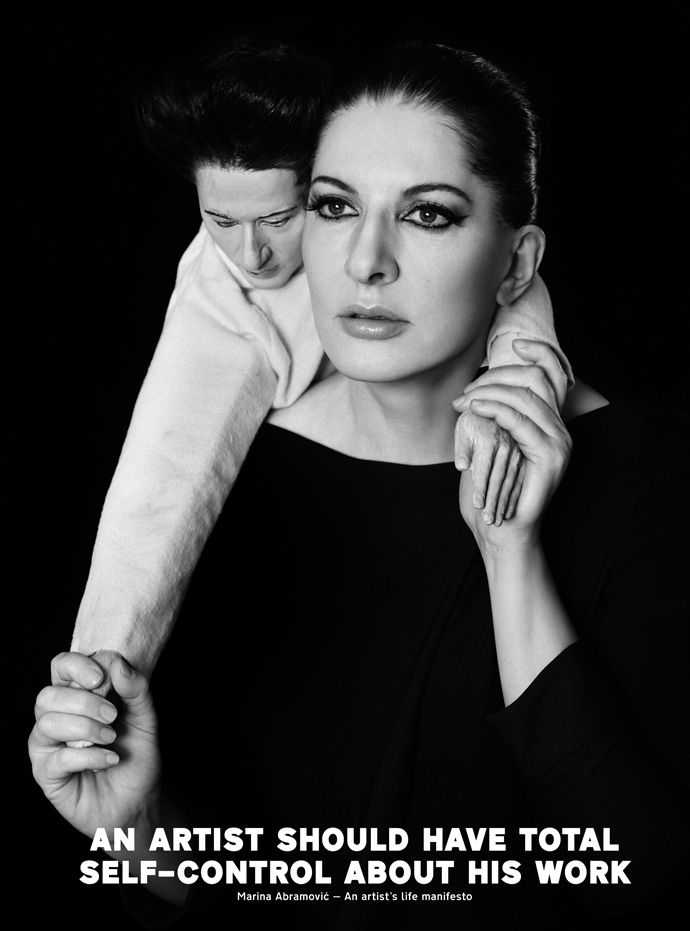 Marina Abramović with her "Mini Me". Photography by René Habermacher for POP magazine
Marina Abramović with her "Mini Me". Photography by René Habermacher for POP magazine
Marina Abramović is everywhere lately. She has emerged from what was considered an alternative section of contemporary art, Performance Art, to finally occupy an untouchable position in the Pantheon of Pop.
A marathon performance at the MoMa, another retrospective in Moscow scheduled, and an exhibition at The Serpentine Gallery slated for 2012, day and night filming of an HBO documentary and an ever growing list of projects. Marina is known for her works in which she tests and pushes her emotional,mental and physical strength, but her schedule takes its toll: Marina is exhausted.
Broad recognition has come comparably late for Abramović, who was often categorized as some sort of Exotic Serbian Vixen. Nevertheless, she has shaped a significant slice of art history like no other.
Today, less considered for her public sexual identity, and more appreciated for her timelessness and her bravery, one could unarguably call Marina “the diva of contemporary art”, were she not so grounded.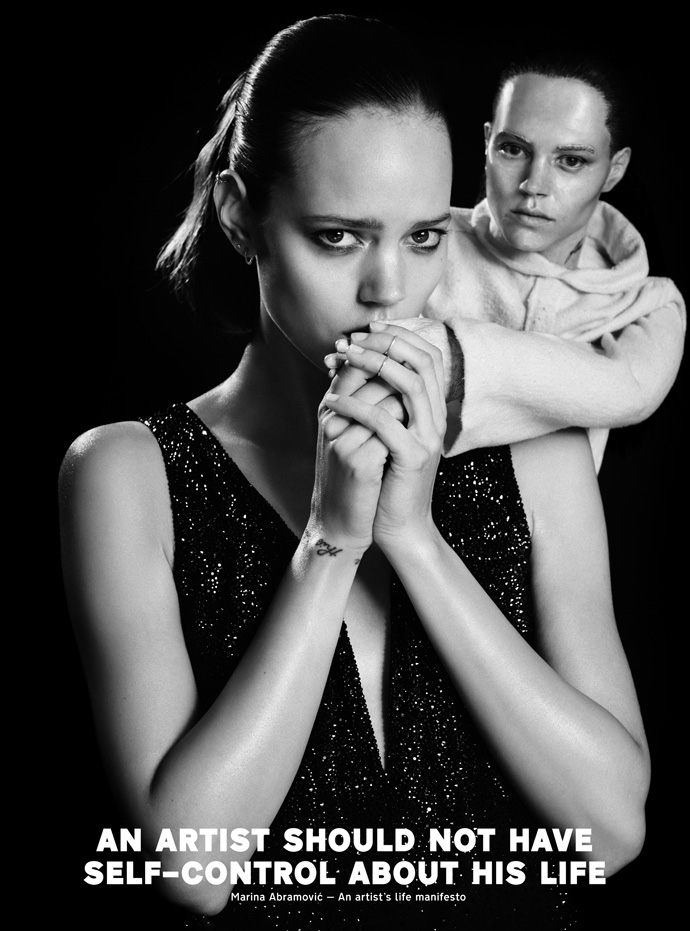 Freja Beha Erichsen with her "Mini Me". A collaboration by Marina Abramović for POP magazine
Photography by René Habermacher
Freja Beha Erichsen with her "Mini Me". A collaboration by Marina Abramović for POP magazine
Photography by René HabermacherOur conversation takes place just after Marina’s return to New York from Manchester, England where she spent six weeks collaborating with Robert Wilson on a new biography, “The Life and Death of Marina Abramović”. The play was staged with accompanied music written and conducted by Antony (of Antony and the Johnsons) and narrated by a ferocious Willem Dafoe.
The audience witnessed him meticulously rummaging through the details of her life chronologically. Marina has been clear about her lack of appreciation for theatre as a concept and this play marks a sharp departure from her concept of herself as a performance artist.She participates in what she used to essentially despise: “To be a performance artist, you have to hate theatre. Theatre is fake: there is a black box, you pay for a ticket, and you sit in the dark and see somebody playing somebody else’s life. The knife is not real, the blood is not real, and the emotions are not real. Performance is just the opposite: the knife is real, the blood is real, and the emotions are real. It’s a very different concept. It’s about true reality.”
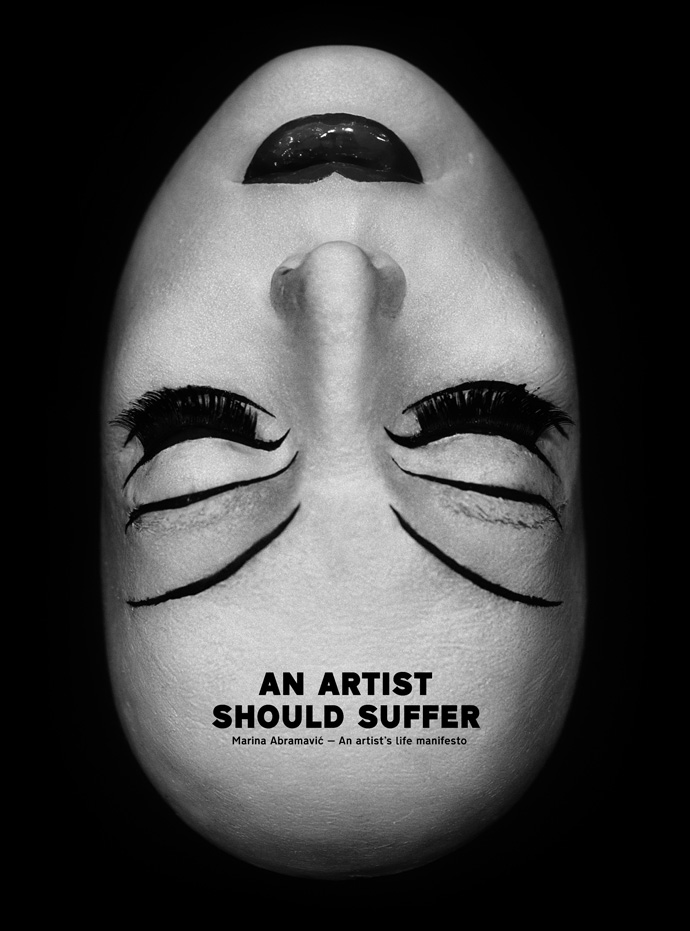 Death mask of Marina Abramović. Photography by René Habermacher
Death mask of Marina Abramović. Photography by René HabermacherRené Habermacher: With this piece you staged something that you call artificial theatre. It lacks the realness that is central to your work. How was this experience for you?
Marina Abramović: I am his material. I completely gave all the control to Bob (Robert Wilson). That is the only way to really be material for someone else, which is very interesting, because its just absolutely the opposite of what I do. This is first time that i have this really radical approach with Bob – he absolutely refused anything to do with performance. This was an amazing experience for me and very difficult, because his approach to rehearsal is like mine to performance, – but yet it’s just rehearsal! Just be there for hours and hours in order for him to fix the light. I lose my reason, I need the public, I need another kind of dialogue. This was a huge discipline not to kill him!
RH: How did this project with Bob come together? (more…)
-

HYERES, IT BEGINS
-Can fashion still dazzle us ? To prove that the answer is “yes” for its 2012 edition, the legendary Hyères Fashion & Photography Festival has invited Yohji Yamamoto to preside its fashion jury…
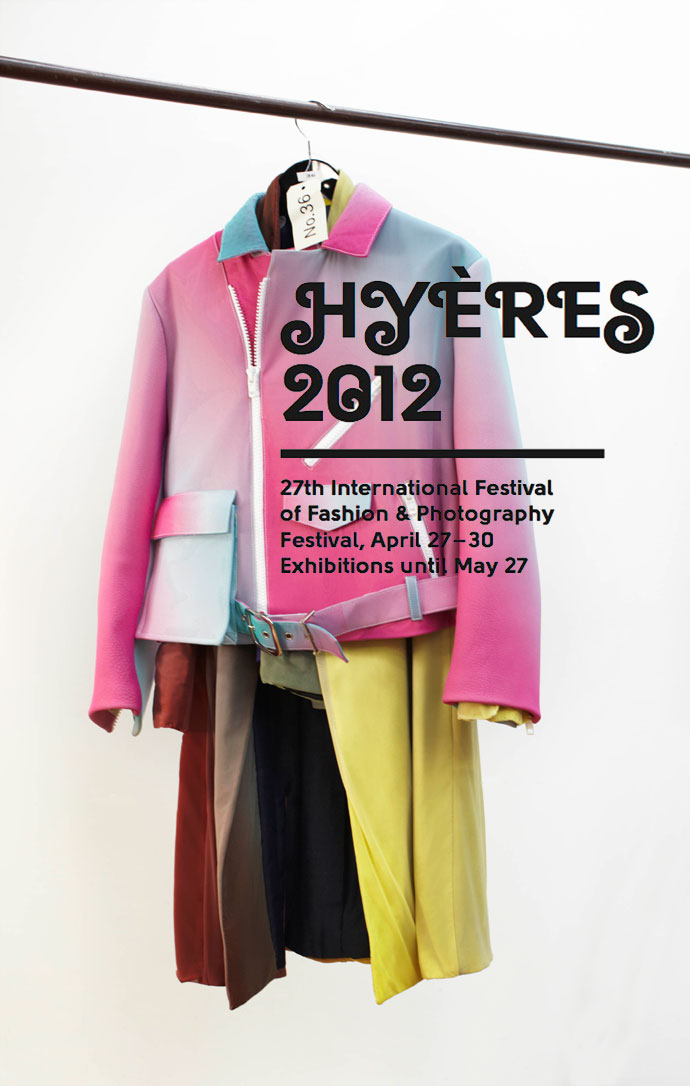
Leather Jacket by Daniel Hurlin, one of the contestants. Photo by René Habermacher.
There is problem in fashion today.
It’s a time of transition, adjusting to the internet, new markets, and the weight of conglomerates.
It’s a time of new opportunities for many.But it’s also a time where a house like Dior cannot find a replacing designer without causing a game of musical chairs – we are to understand that there are so few established designers out there, that Dior’s next womenswear designer must come from a competing house.
As if there were no young designers up to the job.
As if Galliano himself had had much experience when he started.
The problem is, today, that it’s become increasingly tough for young designers to develop their visual aesthetic independently, starting from scratch.
And if young designers can’t develop their style, be allowed to mature and establish themselves, well, there won’t be any mature designers around when Dior needs one.The submitted silhouettes of the 10 contestants. Photo by René Habermacher.
Luckily, there is Hyères.
Since 1985, the Hyères Fashion and Photography Festival, located on the Côte d’Azur in the South of France, has promoted the work of young designers by putting them in contact with the industry’s top professionals, organizing for them state-of-the-art fashion shows and drawing an audience of buyers and press from all over the world, giving them the chance to make a first impression.
Hyères has given us Viktor & Rolf, Felipe Oliveira Baptista (Lacoste), Gaspard Yurkievitch, and many others who now run the studios of the biggest houses.The Hyères 2012 Selection jury.
This Hyères (forgive the pun), Japanese designer Yohji Yamamoto has invited an all-star group to join him in the fashion jury: photographer Paolo Roversi, curator Jules Wright, Galliera fashion museum director Olivier Saillard, creative director Marc Ascoli, buyer Alan Bazarian, Hermès art director Pascale Mussard, and i-D magazine’s Terry Jones were all present to go through the dossiers of the applicants.
Jury member Olivier Saillard examining a dossier.
After hours of looking at dossiers and submitted looks, and additional hours of deliberation, the selection jury chose 4 men’s and 6 women’s looks from designers coming not only from traditional Western European countries but also from Australia, Canada, Argentina, Brazil, Finland and Estonia.
The designers now have 2 months to complete 6 more looks from their collection(and a special Chloé look) before flying in to Hyères in April and being prepped by fashion director Maïda Gregory for the jury and presentations, fashion shows and showrooms happening over the 3 days of the festival. In addition to a Grand Jury Prize (15 000 Euros by L’Oreal Professionel) and a Première Vision Prize (10 000 euros), they’ll also be competing for a new Chloé prize, with a specially designed look.
Photographer Paolo Roversi saluting us as he leaves the Yohji Yamamoto HQ. Photo by René Habermacher.
Check back with us soon for interviews of the jury members and news about the photo competition as well…
Hyères Fashion & Photography Festival
April 27-30th, 2012
Villa Noailles, Hyères, France -

new greek cinema: of WASTED YOUTH and “an old whore in need of love”
-These days we hear mostly troubling news from a country to which its citizens proudly refer to as “the birthplace of democracy”: Greece. Another spiral of economic turmoil unfolding in slow motion casts a spell upon Europe. And yet accelerated by the recent events, a very different wave reaches us from this troubled country: “The weird wave of Greek Cinema” as The Guardian’s Steve Rose titles. The Stimuleye talks to WASTED YOUTHS director Argyris Papadimitropoulos.
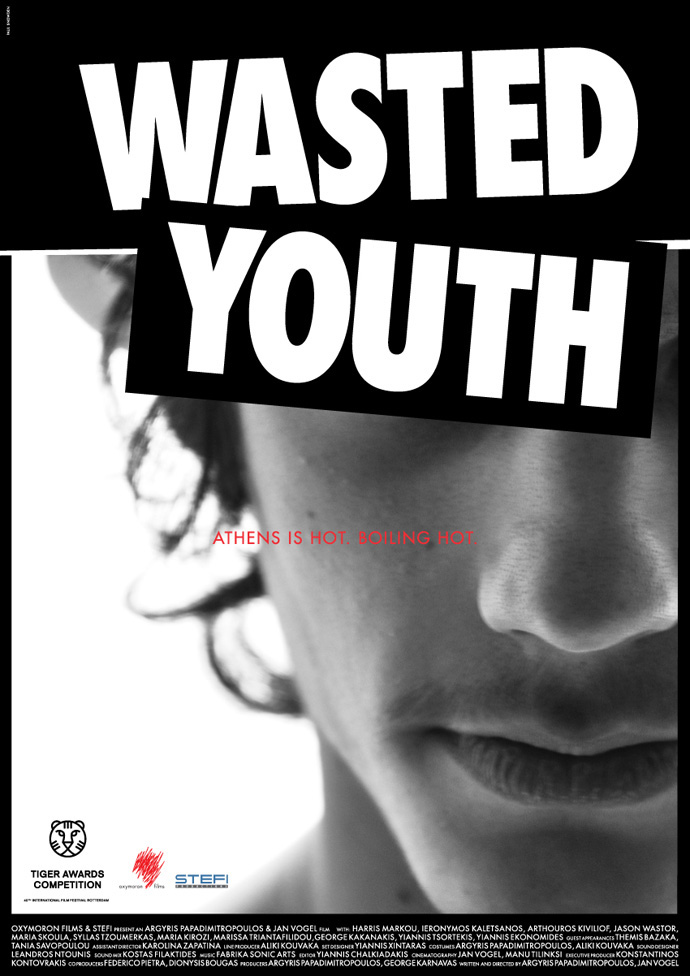 Poster for WASTED YOUTH
Poster for WASTED YOUTHIt’s the late days of summer 2011. A handful of Athenians, foreigners and expats mingle on Antiparos, a small island in the wide open of the blue Aegean. Athens is far and its troublesome agenda on a halt.
As the night falls scenting the breeze with jasmine, the open air cinema Oliaros, a local institution, announces tonight’s screening with notices on poles and walls: WASTED YOUTH, the film that earlier this year had opened Rotterdams Film Festival. The film’s director, Argyris Papadimitropoulos, hands stickers to the arriving guests: WASTED, MALAKA (wanker), YOUTH, LOVE….The film is set during a hot summer day in Athens. Much like the city itself, exhausted, confused, unable to make any progress, brimming with desperation and aggression, there is Vasilis, a middle-aged man struggling with the mounting stress to cater his family. On the other side Harry, a sixteen-year-old skater. He and his friends are amusing themselves and wasting time away. Their lives intersect in a contemporary portrait of the city of Athens and a society in crisis.
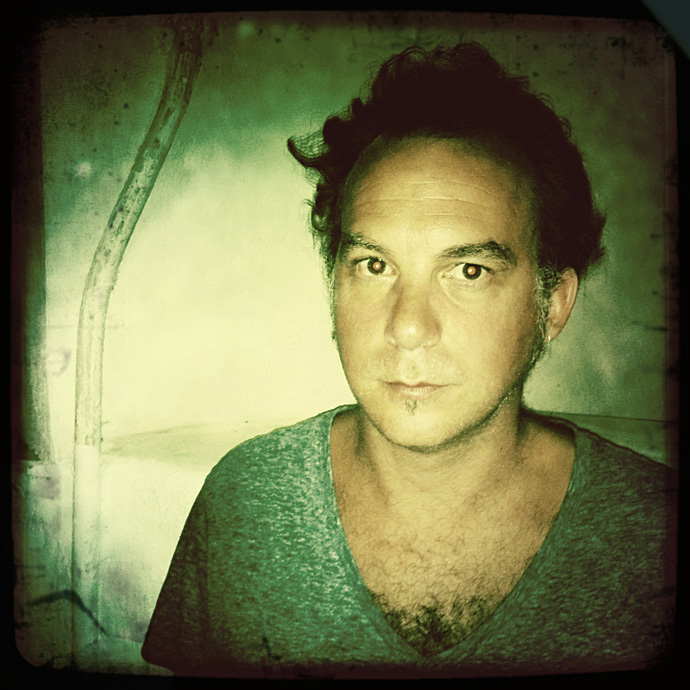
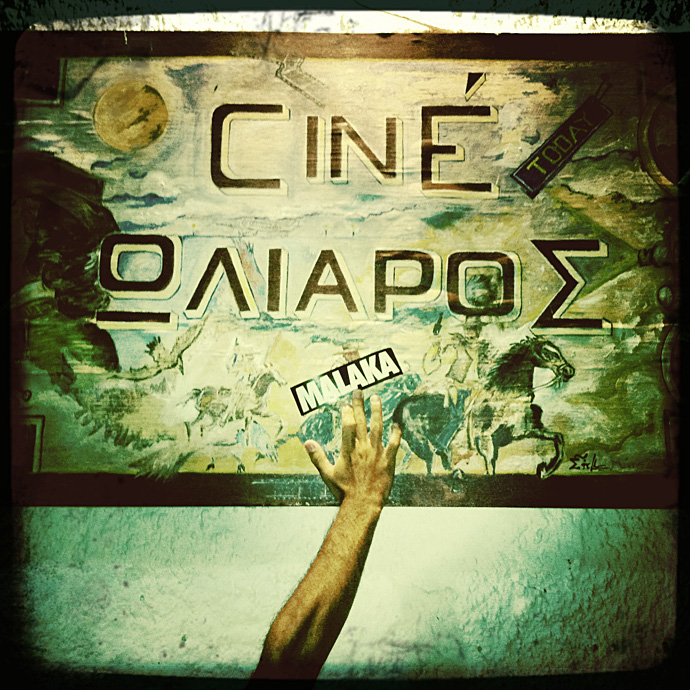 Left: director Argyris Papadimitropoulos at Antiparos and right: Poster of cinema Oliaros with MALAKA sticker
Left: director Argyris Papadimitropoulos at Antiparos and right: Poster of cinema Oliaros with MALAKA stickerRENÉ HABERMACHER: How did that screening at the open air cinema come together?
ARGYRIS PAPADIMITROPOULOS: I am a regular there so I know the guys of Oliaros cinema since… forever. They asked me to do a screening and although I was not allowed to do so by my distributors – In Greece films are supposed to have two runs since we have this open air cinema tradition still alive and very popular – I couldn’t say no. I just love this tiny cinema, and the fact that it is free for everybody to watch the films. There are Greek islands much bigger in population who do not have a cinema and that’s sad.
There’s such a huge part of me and my adolescence in WASTED YOUTH that in every screening I still feel kind of weird… weird in a good way. Since I re-lived my teenage years by shooting this film I feel so exposed. It’s strange telling unknown people so many things about myself. But that’s the magic of it, isn’t it?
WASTED YOUTH had its world premiere in Rotterdam Film Festival in January 2011 and was also honoured to be the opening film. Since then it was screened in more than 30 festivals around the world. In some of the best actually. It was a great year, I spent much of it traveling and presenting the film.
We signed with Elephant Eye Films in New York to represent WASTED YOUTH for world sales. For such a tiny budget film I can loudly say: we did great.Trailer of WASTED YOUTH
R: How was the film generally received by the international audience?
A: I’m more than happy with the comments audience and critics wrote about it.
Screen International described it as “lush, evocative and impressively shot” (laughs).By its career you can tell that the film was received excellent. The audience loved it and the few that hated it, were the ones that gave me the chance to talk, start a discussion, which back in the beginning was the main intention for the film.
I was with my friend and co-author Jan Vogel and we were saying that we need to make a film about these crazy days we are going through and that we need to do it NOW. Some films are made with a sense of urgency. We actually didn’t spent any time writing scripts or searching for funding, but found our amateur teen guys and a couple of good actors and started improvising on a few pages, something like a synopsis. WASTED YOUTH was privately funded by friends and is what you would call 100% indie.R: So it was pretty much a “hit and run”?
A: It was a hit and run urban guerilla thing but shot on film (!), not digital.
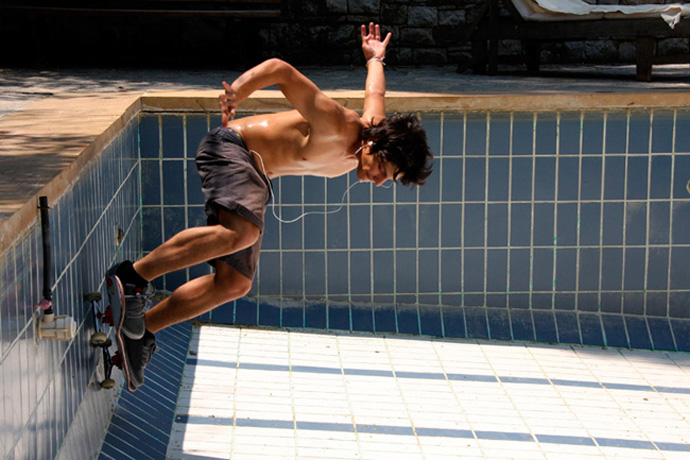 Over the edge: Still from the movie WASTED YOUTH: Harry (Harris Markou) skates in the empty pool of his parents friend.
Over the edge: Still from the movie WASTED YOUTH: Harry (Harris Markou) skates in the empty pool of his parents friend.R: I really liked the scene in the very beginning when the boy wakes up in the morning, somewhere in this modernist building…. that whole sequence to the skating in the empty pool felt really strong… like frozen time.
A: That was our intention. We wanted to go through all the different people, classes etc in the modern greek society.
So the kid wakes up in a house of a lady with what we call “old money” and starts his day under the surface of the earth.
We wanted to have our little symbolisms without making a mind-fuck film.
There a second levels, second readings etc but only for those who want to read them.
I hate the films that are so personal that you will not get them unless you are the person itself (laughs).
I love stories.
I hate smart ass films.R: In my eyes your film looked very authentic- which is quite difficult to achieve.
A: Glad to hear! That was what we wanted to do: a spontaneous film!
R: In a way it also gives a beautiful portrait of the city. How do you like Athens?
A: I love Athens. It’s the place that i was born and I know it as the back of my hand. Athens is a character itself in the film. Its chaotic , crazy and sadly neglected.
It’s the old whore that people love to hate but they love paying a visit. Athens needs a bit of love from the people that fuck her everyday.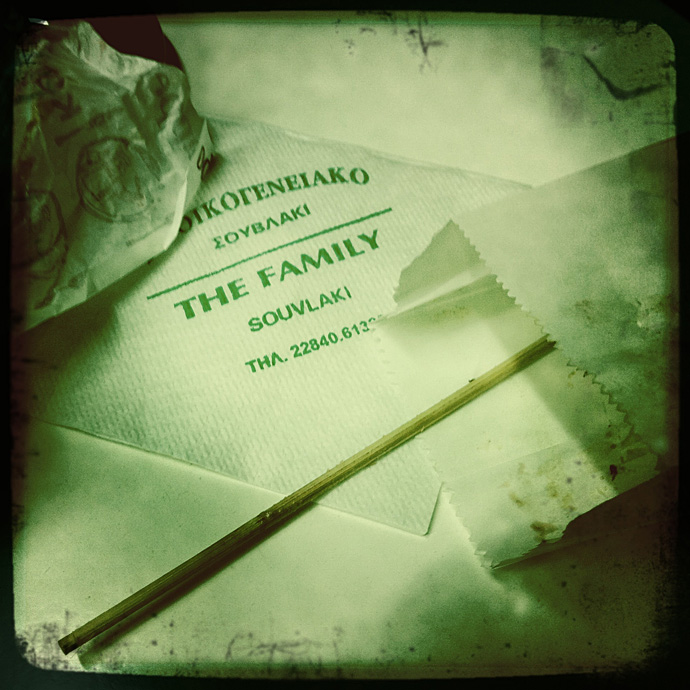
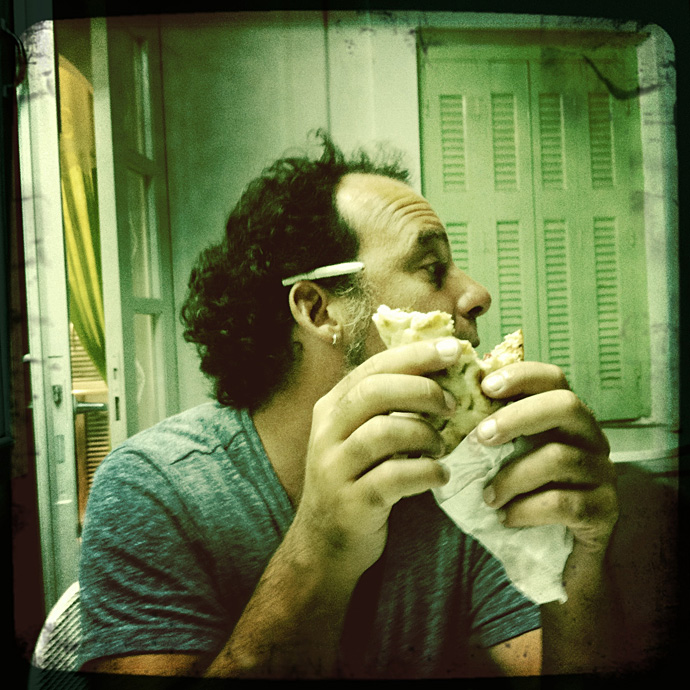 Argyris getting down with more from the spit
Argyris getting down with more from the spitSPOILER ALERT(for the affectionate reader who has not seen the film yet, please skip this part)
R: I was quite surprised at the end when the final “shot” was triggered by the other police man
A: by that I wanted to say that anybody would have done it.
I wouldn’t like the audience to leave the screening and feel sorry about a killer,
since the cops carry guns one day they will trigger them.R: Thats why you left him blank? as a character
A: True, if by blank you mean what I mean.
END SPOILER ALERT
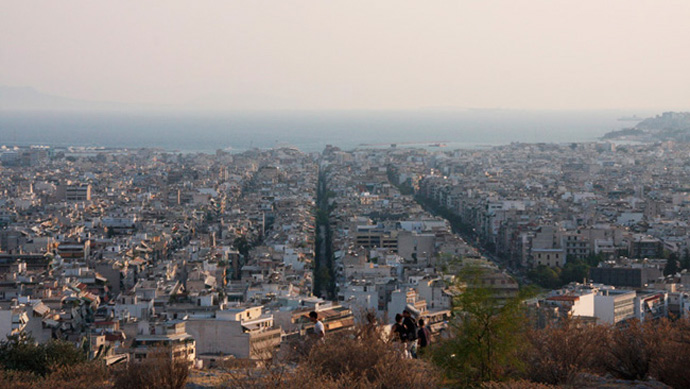 Still from WASTED YOUTH: Athens
Still from WASTED YOUTH: AthensR: The Guardian wrote an article on what they call the “weird wave of Greek cinema”…
A: the fact that the Guardian ran a huge piece on Greek films is already impressive.
A few years back they wouldn’t spend ink on this. That means that there’s something great being born here. I wouldn’t call it a wave and wouldn’t rush to give it names but you can smell something good is going on. There’s no surprise anymore when you see a Greek film in the list of a great festival.
Berlin, Rotterdam, Cannes, Locarno, Venice, Sundance, you name it.
Critisism is there and will always be, there are some people that are sceptical about whatever new is going on and others that want to kill it before it even gets born.
People are not ready for changes, you know.It seems like when societies are on the edge, edgy things come out of their arts. Remember Argentina, Romania and so on.
What was happening in Greece the last 25 years, let’s say from the early 80’s till the olympics was a fake paradise:
a fake prosperity with fake money, fake happyness, fake tits, fake, fake, fake …A fake new identity that never made it to the core of neither our souls nor our society – it collapsed in a few days.
One day they told people we are in crisis and people believed it the same day, so there were no solid foundations in this “new order” that was fakely established.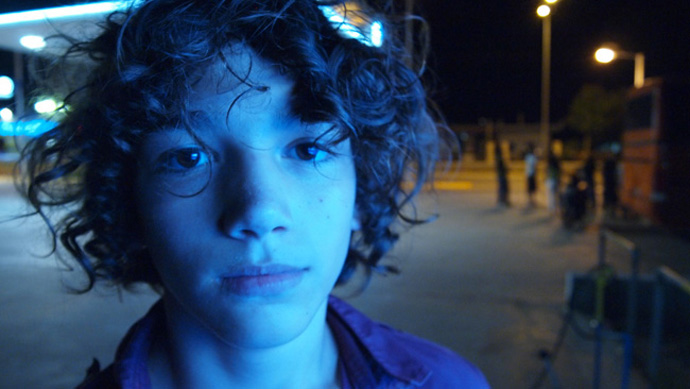 Still from WASTED YOUTH
Still from WASTED YOUTHR: To come back to one of the most interesting things about the article of the Guardian, it were the comments by fellow Greeks being often malevolent, accusing the directors of plagiarism in the case of Dogtooth, or calling the films “a product of mental health problems”.
A: hahaha! that’s great fun.
People cannot accept themselves. When somebody puts a mirror in front of them they can’t cope.
A product of “mental health problems” is the society we use to live in, so are the films as they are suppose to reflect the society.
As for the plagiarism: I would just say that there were very few people saying so, but they created a huge buzz. These people are the ones that do not like the success of someone else because they are stuck in their thing.The greatest festivals in the world are not stupid to have a work of plagiarism in their catalogue.
Also, plagiarism in art is a huge topic that it is almost impossible to discuss: almost every great artist was accused of that!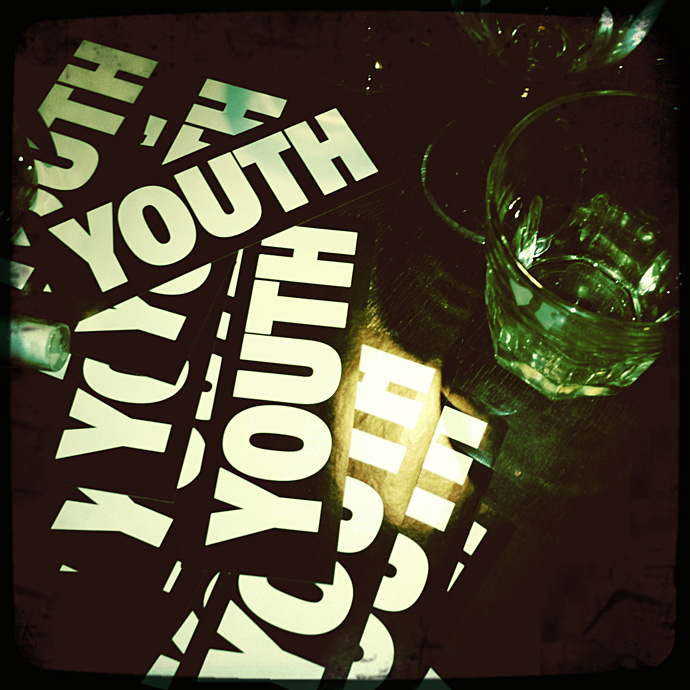
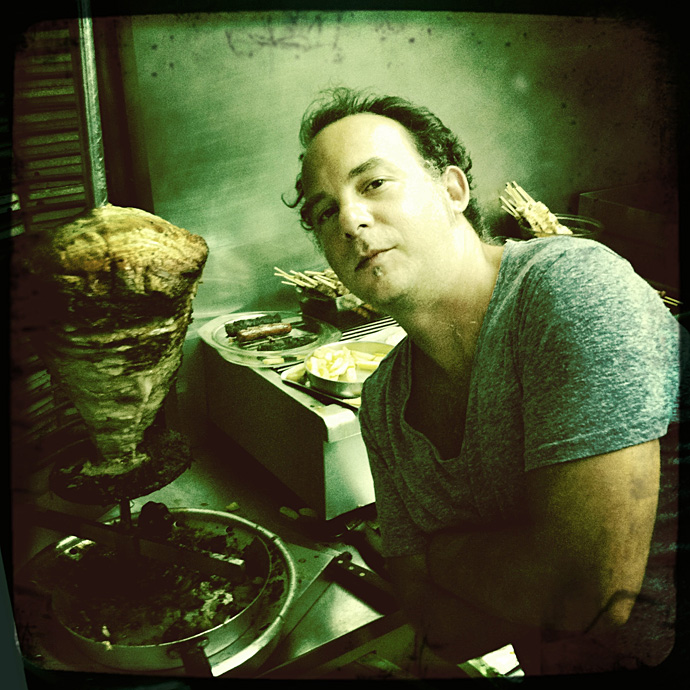 Argyris at his favorite souvlaki place in Antiparos.
Argyris at his favorite souvlaki place in Antiparos.R: I thought this was a very typical reaction. In a recent article for Vanity Fair Michael Lewis puts it like that:
Individual Greeks are delightful: funny, warm, smart, and good company. I left two dozen interviews saying to myself, “What great people!” They do not share the sentiment about one another: the hardest thing to do in Greece is to get one Greek to compliment another behind his back. No success of any kind is regarded without suspicion.A: I wouldn’t agree. If you look at the end credit of all this films that made it to the great festivals the last few years, you will realise that everybody helped on each others work. Greeks are easy target to be accused for almost anything since we have this fucked up temper. But on the other hand you can tell that there is still solidarity and support between most of my fellow greek film makers for example.
R: What are you working on next?
A: I write a couple of scripts with friends. Things are hard these days but we’ll keep trying.
I would like every film I make to be so much different from the other. I would also love to make a film abroad, although I love Athens.
Paris, London, Berlin, New York, Rio, Buenos Aires – there are stories everywhere that i would love to tell…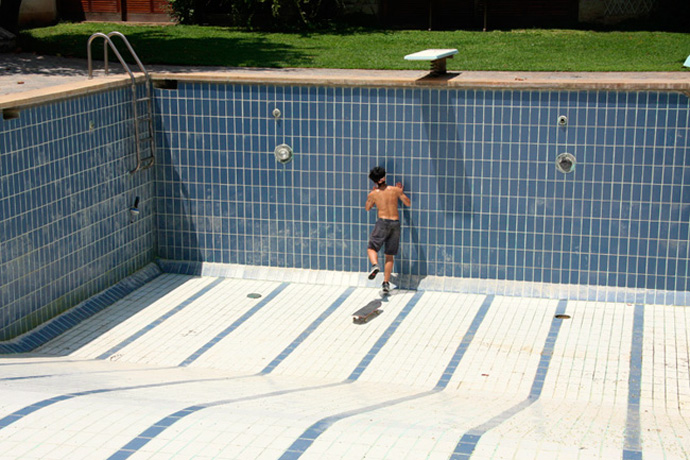 Still from the movie WASTED YOUTH: Harry (Harris Markou)
Still from the movie WASTED YOUTH: Harry (Harris Markou) -

HYÈRES is TOMORROW: RAF SIMONS
-“I do think the main thing when you start with what you want to do, is to find an audience.
And to find an audience, the main thing is to start up a dialogue with them and to find out what they want.”
Raf Simons speaks with The Stimuleye on Hyères. Contestants get ready for the next edition, register before 26th of November, and send your entry before the 5th of December!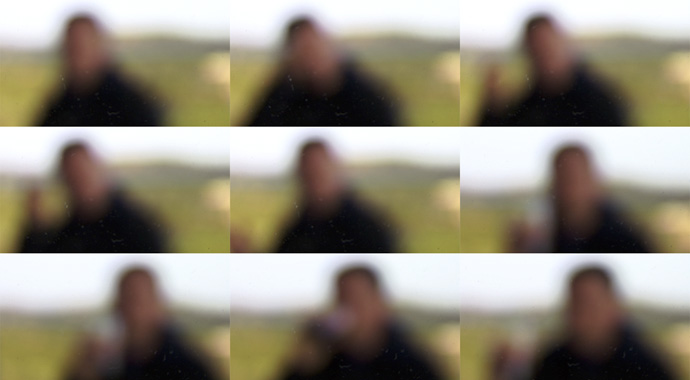 Mister Raf Simons likes it sharp but prefers his pictures in blur. Sequence by Antoine AsserafRAF SIMONS: With my exhibition at the villa, I wanted to show the form of extremity that can be the start of something and still be successful.
Mister Raf Simons likes it sharp but prefers his pictures in blur. Sequence by Antoine AsserafRAF SIMONS: With my exhibition at the villa, I wanted to show the form of extremity that can be the start of something and still be successful.To me it’s really important for the generation who enters into this context to realise what kind of platform this is. I think it’s enormous. The amount of press that is there and the staging of the garments on a super high level.
We selected 10 contestants out of 50 (of initially 800 entries), together with Christopher Kane, Michel Gaubert, Maida Boina and Jean Pierre Blanc.It was not easy. We had for each entry one single silhouette, which is complicated to judge with the dossier that is “flat” and has yet to be developed.I did see there were people who were working on their collection, from the moment they were chosen to the moment it went on stage, and there were people who did not. That showed also in the final result: the ones who had been working on, got better.
It was quite a discussion within the jury. We were not unanimous about the winner. There were mainly two, but there was clearly already a third person [Emilie Meldem] that all members of the jury found interesting to mention, so we had to decide to vote, which is also the honest way I think. when you start discussing like “yeah maybe less people like that and more like the the other, but let’s still make the winner the one that less people like”- I think that is not correct.Hyères Alive - Award Ceremonies
“Refined sensibility” – I think the winner [Léa Peckre] stood out for that at the end.
The second price [Céline Meteil] won for its purity. In relation to lots of other things the jury members thought that one was attracting because of the purity and of its honesty: to take one thing and kind of concentrate on that. One material, one process, one kind of shape. But it worked. It had something quite controlled at the same time something not too forced, not trying to be too special. Because we had quite some people who tried to be really special and it also went wrong. -

Hyères We Go Again
-Ladies and gentlemen, place your bets. Every year, the Villa Noailles art center in Hyères, France offers fashion designers and photographers the opportunity to step into the spotlight…
Photo by 2010 photo winner Yann Gross, look by 2011 fashion winner Léa Peckre.
Design duo Viktor & Rolf ? Stills photographer and Ricard award finalist Erwan Frotin ? Mugler men’s designer Romain Kremer ? Fashion photographer Sølve Sundsbø ? ANDAM 2011 prize winner Anthony Vaccarello ? Lacoste designer Felipe Oliveira Baptista ? All these people have one thing in common – their work was all launched into the spotlight through the Hyères fashion and photography festival, which is now going into its 27th edition.
As a contestant, you must register by November 26th and send your application package by December 5, 2011. Your work will then be reviewed by a jury of fashion, art and photography professionals (including in the past Azzedine Alaia, Nan Goldin, Riccardo Tisci, Peter Knap, Karl Lagerfeld, Viviane Sassen, Dries Van Noten, Tim Walker, Christian Lacroix…).
If you make it past the first rounds of selection, you’ll be given production help for your collection, flown to the Hyères, given the chance to meet and talk with the 2012 juries, and have the famous Hyères team produce a gallery show of your pictures or a fashion show of your collection, in or around the unique setting of the avant-garde Villa Noailles, once vacation home to the likes of Dali and Cocteau…
And of course, the best part: my little finger tells me this year there will be even more prizes…
In case that wasn’t enough, here’s everything you need to know about Hyères in 2 minutes 6 seconds.
Villa Noailles
2012 Contest guidelines & registration
Registration deadline: November 26th, 2011
Submission deadline: December 5th, 2011 -

the shoes
-They’ve produced Shakira, Sha-Sthil’ed, released a secret Japanese album, toured Europe, and now they’re preparing their big Paris concert, before continuing more collaborations with WoodKid, Aikiu and Philippe Katerine. Ladies and Gentlemen, take your socks off for…The Shoes.
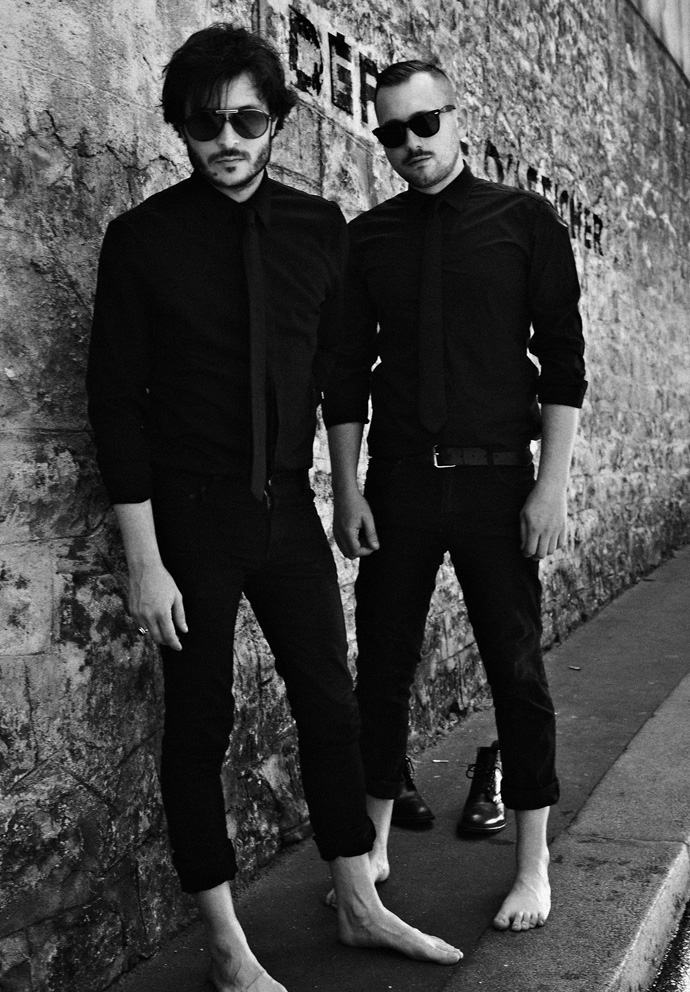 Benjamin (left) and Guillaume (right) of The Shoes, photo by René Habermacher.
Benjamin (left) and Guillaume (right) of The Shoes, photo by René Habermacher.You guys DJ’ed at the Hyères Fashion Festival, then at Versailles for the end of Couture Week, are you infiltrating fashion ?
It was a fun DJ set, a bit camping/bar mitzvah, but well mixed.
We also played in Florence for Pitti, in a beautiful place.
Are you continuing to do production for other artists?
Benjamin: It’s a part of our identity we started and really want to develop, so we try to keep it going, in between festivals, concerts and other requests that come in. We’re working on the WoodKid (Yoann Lemoine) album, a track with Philippe Katerine, very different things as long as we like the artist.
Guillaume: With Yoann it’s a bit different, as he’s also a friend.
How long has your album been out – you seem to have a lot of different videos already ?
B: The album came out in March, I think like Mylene Farmer we’re going to make a DVD with all the videos… (laughs)
G: We’ve done 4 videos already, preparing Time To Dance for the fall. In the end half of the album is going to have videos.
The Shoes ft Esser, STAY THE SAME. Directed by Daniel Wolfe.
Is Cliché one of the tracks for which you’ll make a video ?
G: a lot of people have asked, it’s a track that chicks like a lot because it’s the only feminine voice on the record, but it’s not in the plans right now, we think Time To Dance will work.
B: We’ve seen people go crazy on that track even though it hasn’t been played much. It has an old-school, Underworld-style crescendo that lasts 2 minutes.
I’ve seen you at the Nouveau Casino the first time around…do you manage to get some of the singers from the tracks to come sing from time to time ?
G: that was really at the beginning! We have Ben Esser who comes quite often, Anita from Cocknbullkid came at Nouveau Casino. But of course the audience likes to put a face on the song.
It’s a bit unusual to have the lyrics pre-recorded with live instruments, usually it’s the other way around — live lyrics with instruments playback. Especially because you guys really are hardcore on the instruments, while the voice seems to come from nowhere…
B: that was the main criticism aimed at us at the beginning, and we hadn’t solved it when you saw us.
G: we were a bit shy, now we sing it ourself, it’s not perfect but it works more with energy instead. Now we’re starting to more or less control the singing.
The Shoes performing WASTIN' TIME with Esser at Hyères 2011, with Stage of the Art.
Do you sing it entirely live now or do you mix with the recorded lyrics by the singer ?
B: you’re getting into our trade secrets… we mix the voices actually.
G: we don’t try to hide it. it was a problem at first, but now we’ve worked it out – though of course when someone like Esser comes along it’s great, it gives it more of a band feeling and we can concentrate on instruments.So how did you choose the singers and bands with which you collaborated ?
G: it happened by itself.
B: we were spending time in the UK, we met lots of people, making friends. It started with Primary One, we did the music for the track People Moving, he came to the studio in Rheims and we realized we could never have this kind of result with our own voices, so it became our first featuring. Then we contacted the people we had met with some demos, sometimes with lyrics sung in “yogurt”. No real name dropping.
G: none of the featurings are very famous people, it’s rather people who are at a similar stage of their career… since then we see a lot more Cocknbullkid and Esser.Singing in French, is that something you’d consider ? I imagine the collaboration with Katerine is in French ?
B: for The Shoes, no, but for other artists we do it.G: Benjamin does it more than me, but it’s not something for The Shoes yet.
The Shoes performing STAY THE SAME with Esser at Hyères 2011, with Stage of the Art.
What’s the current program, festivals ?
G: [this summer it was] festivals, the WoodKid album.
I’ve also produced the album of this artist called The Aikiu, which is a complete transfiguration of the initial project.
Is that the first real album by The Aikiu ? It seems it’s a project that has been on the verge of happening for a long time, I remember hearing a single at least 5 or 6 years ago…
G: They’ve had EP’s only so far, they asked us to come work on the album, we arrived and blew the whole thing upside down. We broke everything and started from scratch. I think Alex has a great voice, and that there’s great things to do with his voice — but that’s complete now and we’re working on WoodKid.
And working on WoodKid’s album brings some extraordinary conditions, we get to use unusual instruments. Yoann also puts a lot of constraints on us too, he knows what he doesn’t want, which pushes us to do things in different ways.
I was also very happy to discover that you (Guillaume) were behind Gucci Vump and the track SHA SHTIL which was THE track of the summer last year… Is that something you’ll continue or are you focussing exclusively on The Shoes ?
G: I’m focussing more on The Shoes, but Gucci Vump is a funny project, a bit shapeless, Louis (Brodinski) and I run into each other from time to time, we get commissions for remixes from time to time — like WoodKid’s Iron. It’s a dilettante project.
Gucci Vump – Sha! Shtil! by quepasooo
So after the festivals you guys are focussing on your own tour ?
G: Yes we have over 30 dates in the fall, the climax will be November 9th at La Cigale in Paris. We also hope to return to Japan.
You’ve already played in Japan ?
G: The album did really well over there, Japan’s the first country to sign us besides GUM, and they didn’t want to wait so long for the album, so we released an album just for Japan, with B-sides. People try to get their hands on that album, which is a bit of a collectors’ item, with demos and beta versions of tracks which later appear on CRACK MY BONES.
But we’re very focussed on our La Cigale date – with almost all the guests from the album, extra band members…
We usually have 2 percussionists, but we’ll probably go back to 4 – visually it’s beautiful and in terms of sound it doesn’t hurt. When you have 4 guys doing a sort of choreography, it gives something unusual.
The Shoes, photo by René Habermacher.
The last thing which stimulated you…
G: a DJ from a rap group called 1995, a French group, which made an amazing mixtape for the summer.
B: for me, it was the Solidays concert of Ebony Bones – I usually don’t listen to her music, but in concert it was impressive. It’s really made for a festival.
G: from time to time, you get groups that you don’t necessarily like that make a strong impression on you live, they transfigure their music. But you also get the opposite…
I had that with Gonzales. 10 years ago I liked his stuff, I went to see him live, and I hated it so much, I couldn’t listen to the music again for several years. And still now I like the music but I can’t stand his videos or his imagery in general.
G: it was really important for us to delegate the image to Pierre (LeNy), even if we have our ideas regarding what we like visually.
So far you haven’t appeared in any of your videos….but you’re not hiding either ?
G: You often see beautiful videos that fail as soon as the singer appears, the acting required from the singer brings the whole thing down. We want our films to be little bits of cinema – we’re not going to add anything to that feeling.
THE SHOES
Special concert at LA CIGALE
November 9th 2011
Opening act: ESSERPhoto credits:
STYLING: Michael Philouze
GROOMING: Tanya K @ B-AGENCY
PHOTO ASSISTANT: Fabien Campoverde
with special thanks to Pierre Le Ny & G.U.M.Film credits:
Filmed by Jason Last & René Habermacher
Edited by Antoine Asseraf
Production Assistant Lynsey Peisinger
a THE STIMULEYE production -

CHIARA SKURA, watch and party !
-The Stimuleye is proud to announce the release of the latest film of the Vogue.it – A Short Film With series, CHIARA SKURA, a collaboration with Marios Schwab featuring his hot Spring Summer 2012 collection.
Watch it here.
Come celebrate the release of CHIARA SKURA with Marios Schwab and friends,
Friday October 30th, 10pm – 2am
at Le Pompon,
39 rue des Petites Écuries, 75010 Paris
Metro: Bonne Nouvelle
Password: CHIARAFILM CREDITS:
-

Guy Bérubé and his Petite Mort
-It has been one year now since I moved to Ottawa, Canada. During the past year I’ve come across a few people who are always trying to make the city exciting. Guy Bérubé, a good friend now, is one of them. He owns a gallery – La Petite Mort, a place where taxidermy meets with iconic furniture pieces and fundraising art sales for several charities (including Guy’s own).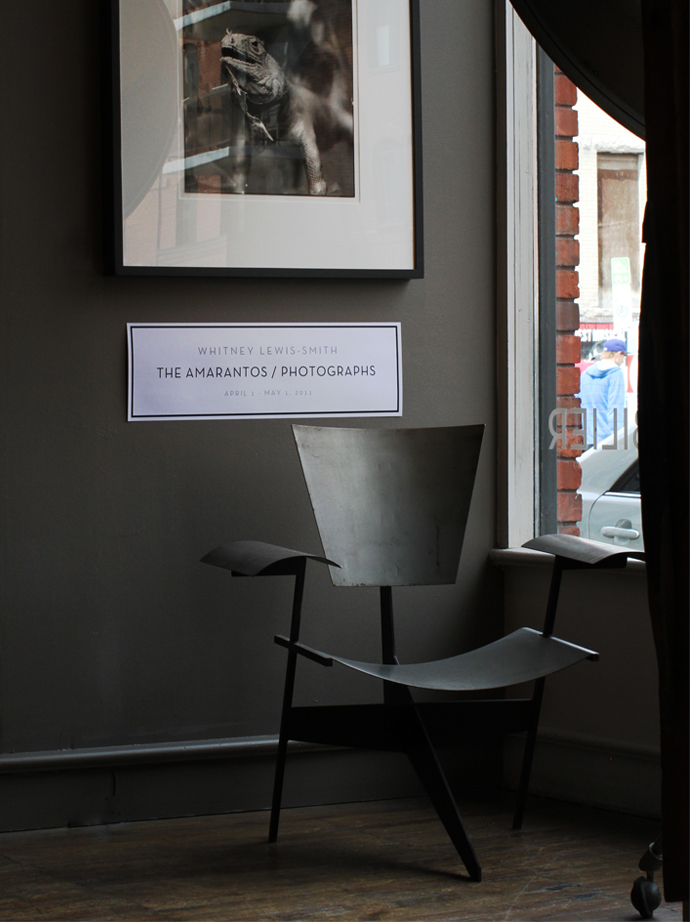 Lizard photo: Whitney Lewis-Smith.Far from presenting “Hockey art” or Canadian landscapes, in Guy’s gallery you will find work ranging from portraits of the city’s crack addicts by photographer Tony Fouhse, to poems on pieces of cardboard by Crazzy Dave of the Ottawa homeless community.With the look and fame of a bad boy, I can only say that Guy is doing a great job for the art community in Canada: making art available and affordable to whoever is interested.
Lizard photo: Whitney Lewis-Smith.Far from presenting “Hockey art” or Canadian landscapes, in Guy’s gallery you will find work ranging from portraits of the city’s crack addicts by photographer Tony Fouhse, to poems on pieces of cardboard by Crazzy Dave of the Ottawa homeless community.With the look and fame of a bad boy, I can only say that Guy is doing a great job for the art community in Canada: making art available and affordable to whoever is interested. Legs with severed head (Guy's head, btw) Peter Shmelzer.What was the last thing that stimulated you?It happened here in Ottawa, it happened to be a lesbian wedding performance by former American prostitute and porn star turned performance artist, Annie Sprinkle, and her partner, hosted by SAWGallery. It was very interesting for me to see. They are already married, but they do an annual wedding with a theme, and this time here in Ottawa it was marriage to nature, and marrying snow. They are eco-sexual; they have sexual feelings about nature (laughs). I hadn’t seen Annie Sprinkle in over 25 years, and I had met her before at a performance in NY where she had a live orgasm on stage.So, it happened next door to my gallery at St. Brigid’s (a deconsecrated Church), and a lot of people came, and they saw the look and the aesthetics of a wedding. Everybody wearing white, everything was beautifully decorated, the light was coming through the stained glass… but then the performance started. They rode a pile of snow, exposing themselves by lifting their wedding dresses, and then inserted icicles up their vaginas, as they recited their wedding vows.That seems a bit unusual for the city…I’m seeing change, slowly but surely, over the 10 years that I have been here. I know that I’ve had some credit for some of the change. I’m seeing a difference in the art that is featured in galleries, even the Municipal galleries are showing things from my artists. It is something positive; Ottawa is a city where there is a possibility of starting from scratch, even though you’ve seen it in other places. Ottawa is a funny little town, very voyeuristic; it’s like the dude at the orgy who complains about the bad drapes and doesn’t jump into the fun.What would be a good example of this change coming from your gallery and artists?
Legs with severed head (Guy's head, btw) Peter Shmelzer.What was the last thing that stimulated you?It happened here in Ottawa, it happened to be a lesbian wedding performance by former American prostitute and porn star turned performance artist, Annie Sprinkle, and her partner, hosted by SAWGallery. It was very interesting for me to see. They are already married, but they do an annual wedding with a theme, and this time here in Ottawa it was marriage to nature, and marrying snow. They are eco-sexual; they have sexual feelings about nature (laughs). I hadn’t seen Annie Sprinkle in over 25 years, and I had met her before at a performance in NY where she had a live orgasm on stage.So, it happened next door to my gallery at St. Brigid’s (a deconsecrated Church), and a lot of people came, and they saw the look and the aesthetics of a wedding. Everybody wearing white, everything was beautifully decorated, the light was coming through the stained glass… but then the performance started. They rode a pile of snow, exposing themselves by lifting their wedding dresses, and then inserted icicles up their vaginas, as they recited their wedding vows.That seems a bit unusual for the city…I’m seeing change, slowly but surely, over the 10 years that I have been here. I know that I’ve had some credit for some of the change. I’m seeing a difference in the art that is featured in galleries, even the Municipal galleries are showing things from my artists. It is something positive; Ottawa is a city where there is a possibility of starting from scratch, even though you’ve seen it in other places. Ottawa is a funny little town, very voyeuristic; it’s like the dude at the orgy who complains about the bad drapes and doesn’t jump into the fun.What would be a good example of this change coming from your gallery and artists?
The USER series by Tony Fouhse is a perfect example of what my gallery does, something of which I’m very proud. It was featured in New York Times, Japan Newsweek… people got it, but it was very difficult at the beginning; lots of people in the neighbourhood, politicians, people were very against the work. Men wrestling: Matthew Dayler / Photo of man laughing: Tony Fouhse.
Men wrestling: Matthew Dayler / Photo of man laughing: Tony Fouhse.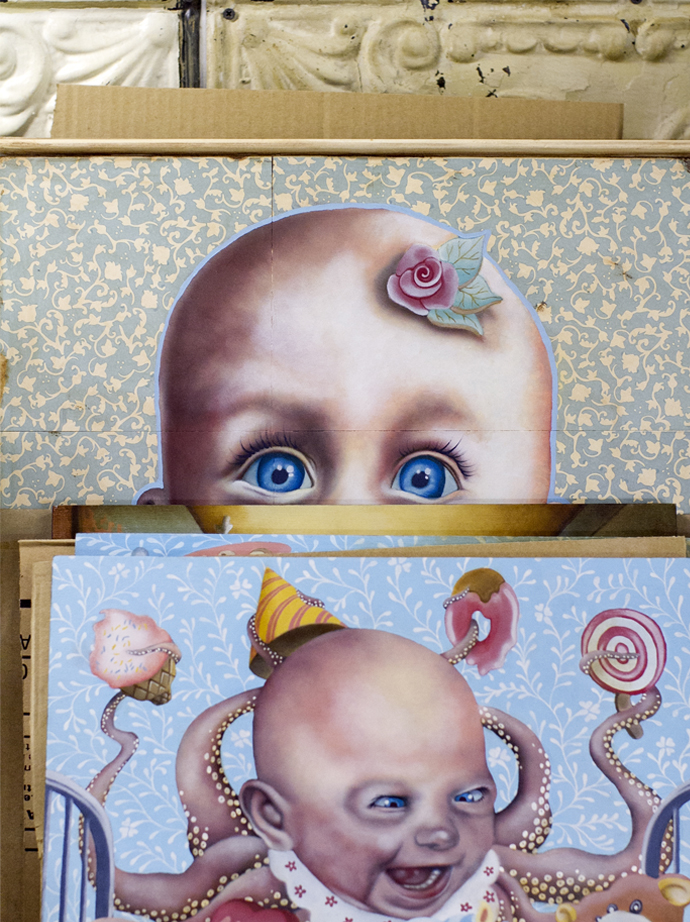 Creepy baby head: Robert Farmer.What’s the deal with the stuffed animals?Before I had the gallery I had the fake tortoiseshell lamp, which I bought in Paris, and then I bought, not knowing why, the baboon. I think I felt sorry for him, it was on the floor of a junk store and people were grossed out by it, so I paid $20. And so, when I got the gallery, a friend of mine asked me if I was going to bring the “creepy animals”. Then people just started bringing their stuffed animals to me, and it became a depository, kind of like an orphanage. You can bring your stuffed animal, but it needs to have a good valid story, like all the other animals there. I’m not online desperately looking for an owl! I don’t buy them.
Creepy baby head: Robert Farmer.What’s the deal with the stuffed animals?Before I had the gallery I had the fake tortoiseshell lamp, which I bought in Paris, and then I bought, not knowing why, the baboon. I think I felt sorry for him, it was on the floor of a junk store and people were grossed out by it, so I paid $20. And so, when I got the gallery, a friend of mine asked me if I was going to bring the “creepy animals”. Then people just started bringing their stuffed animals to me, and it became a depository, kind of like an orphanage. You can bring your stuffed animal, but it needs to have a good valid story, like all the other animals there. I’m not online desperately looking for an owl! I don’t buy them.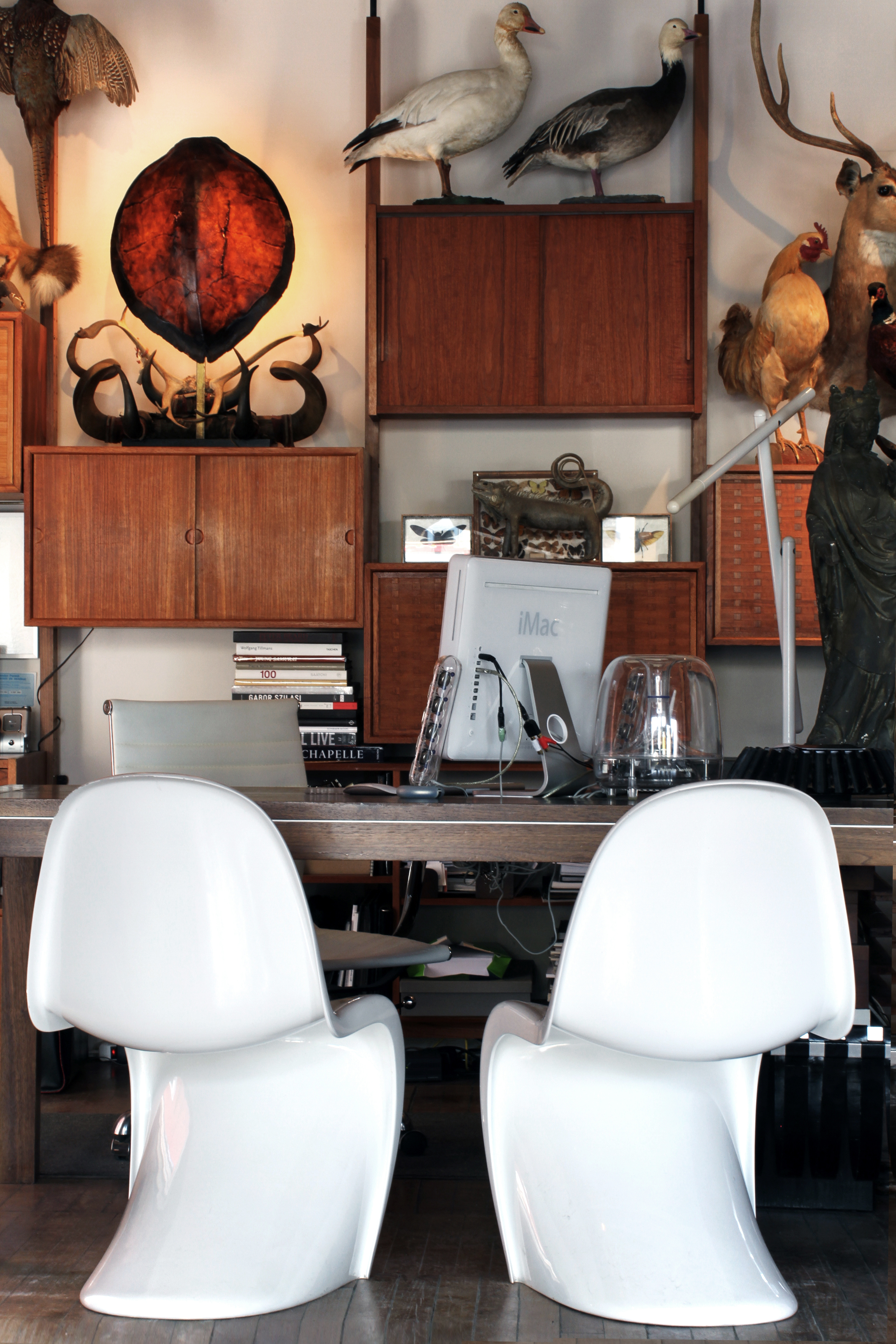
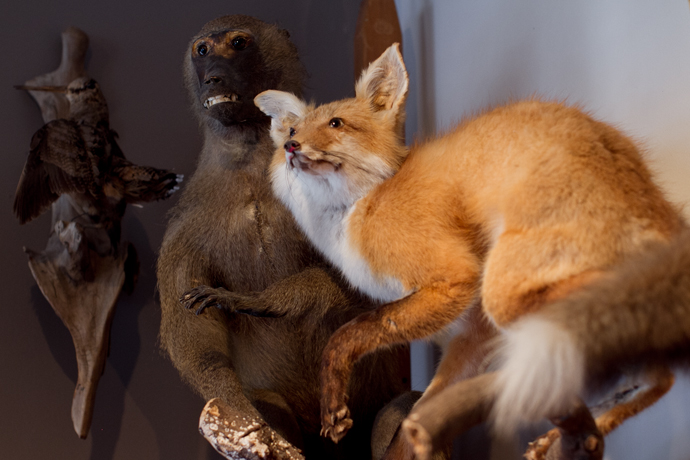 Guy's taxidermy collection.You must have some good stories…A woman once told me she wanted to give me a bison’s head, and I have always loved the look of them.So, we had a long conversation, and in the end she told me, “well, it hasn’t been taxidermied yet, it’s just the severed head” (laughs…) it was frozen!!!Make sure to check out La Petite MortSLAVA MOGUTIN & BRIAN KENNY
Guy's taxidermy collection.You must have some good stories…A woman once told me she wanted to give me a bison’s head, and I have always loved the look of them.So, we had a long conversation, and in the end she told me, “well, it hasn’t been taxidermied yet, it’s just the severed head” (laughs…) it was frozen!!!Make sure to check out La Petite MortSLAVA MOGUTIN & BRIAN KENNY
September 2 – October 2, 2011
INTERPENETRATION
Photographs & Drawings www.lapetitemortgallery.com -

coming soon – CHIARA SKURA
-Hot on the heels of Marios Schwab’s breakthrough SS12 collection “chiaroscuro”, The Stimuleye is proud to announce “CHIARA SKURA – A Short Film With Marios Schwab” for Vogue Italia, coming September 28th…
Directed by Antoine Asseraf & René Habermacher
Starring Amy BaileyMarios Schwab
Style.com show pictures and review
Vogue.it – A Short Film With -

marc turlan: STAR NOTORIOUS
-First, he covered them up with a resin mask, then he cut their eyes out, with a scalpel and after with a laser. This is not Dexter, this is artist Marc Turlan, who always finds new ways of torturing magazines.With his latest solo show EXO STAR he is taking an artistic leap, opening this saturday at Galerie Anne de Villepoix in Paris.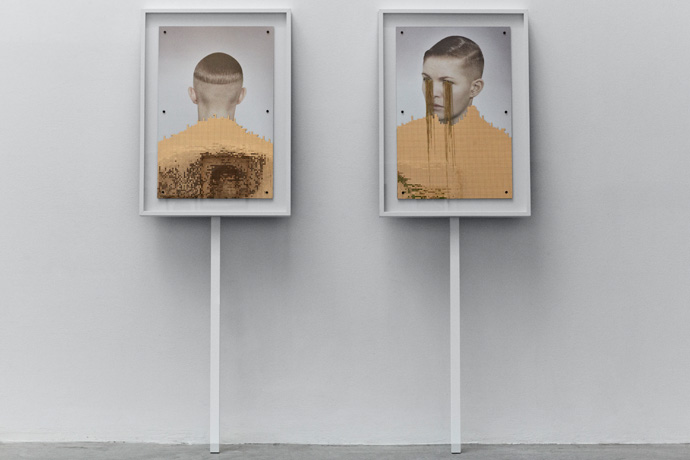 Marc Turlan: protest board 1 and 2, a collaboration with british photographer Timur Celikdag.
Courtesy gal Anne de VillepoixThe new sculptures of Marc Turlan conclude a logical extension of his appropriative work with the pages of glossy magazines:“The base of all i do is collage. The technique for my sculpture is the same way, it’s like 3 dimensional collages.”Right in the first room, the program for the exhibit gets clear: a gym workbench, weight bars in a stack, and 6 sheets of mirror, each with a word inscription of mirror mosaic, that serve as the commandments for this show: WORK – NOTORIETY – SINCERITY – POWER – LOVE
Marc Turlan: protest board 1 and 2, a collaboration with british photographer Timur Celikdag.
Courtesy gal Anne de VillepoixThe new sculptures of Marc Turlan conclude a logical extension of his appropriative work with the pages of glossy magazines:“The base of all i do is collage. The technique for my sculpture is the same way, it’s like 3 dimensional collages.”Right in the first room, the program for the exhibit gets clear: a gym workbench, weight bars in a stack, and 6 sheets of mirror, each with a word inscription of mirror mosaic, that serve as the commandments for this show: WORK – NOTORIETY – SINCERITY – POWER – LOVE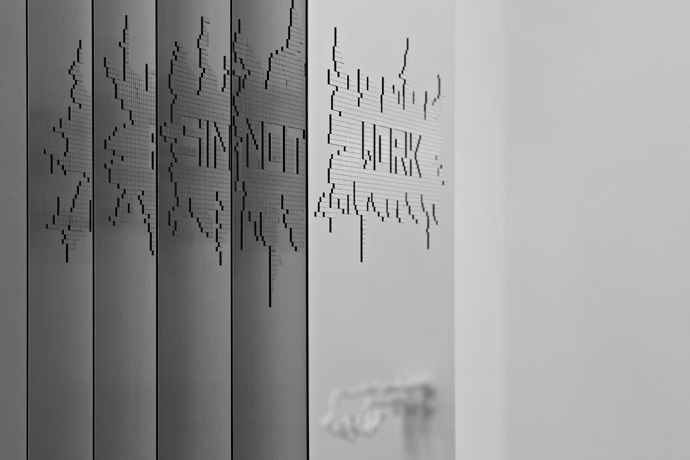 Marc Turlan: Statement Carpets. Courtesy gal Anne de Villepoix“It’s about the body. it’s erotic. Its a fetish to have in your mind to transform your body, to make a new image of yourself” he explains, next to two sculptures that look like snaffle headpieces with star shaped marble weights hanging from its leather thongs. It is inspired by gym gear to work your trapezius muscle. The materials surrounding us – leather, marble, mirror, wood. Marc Turlans recurrent structural elements are evident: eroticism, vanity, fetishism and notoriety.
Marc Turlan: Statement Carpets. Courtesy gal Anne de Villepoix“It’s about the body. it’s erotic. Its a fetish to have in your mind to transform your body, to make a new image of yourself” he explains, next to two sculptures that look like snaffle headpieces with star shaped marble weights hanging from its leather thongs. It is inspired by gym gear to work your trapezius muscle. The materials surrounding us – leather, marble, mirror, wood. Marc Turlans recurrent structural elements are evident: eroticism, vanity, fetishism and notoriety.Left: Marc Turlan's "Star Rack", and right: the artist himself
And there is of course, the star: “The star is the representation of the absolute, its a simple symbol for everyone. This desire, or fantasy to be recognised, to be famous, to arrive at this point… I use the star in marble.”In Marc Turlans “gym” you actually work out with the star as a marble weight, stemming the symbol of the desired recognition and thus transform yourself through and towards that idea.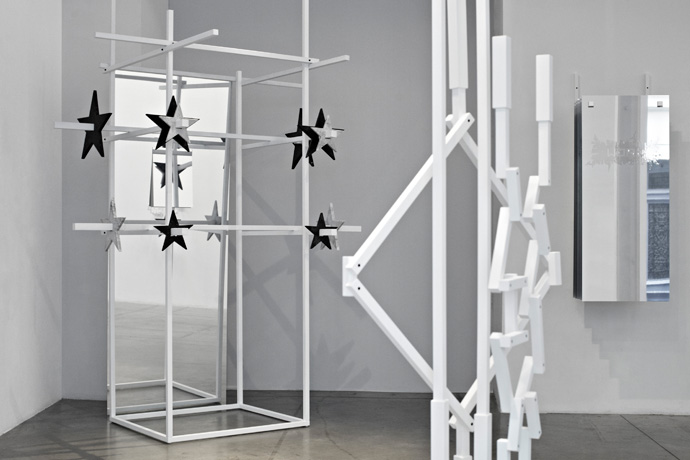 The first room of EXO STAR with "Home Star-Gym". Courtesy Gallery Anne de VillepoixThe second room is pitch black and only lit by pulsating light bulbs on a cluster of stars, an array of audio sculptures speak to the visitor with each a “collage sonore” (sound collage). Corresponding to the acoustic rework of a writers text hangs a framed object, containing a book of the same author with a mirror mosaic highlighting a sentence.“I keep a sentence very different to the audio collage. It is a proposition, an open invitation. I don’t work in an interactive way. I am interested in the object. It becomes a sculpture” he explains.
The first room of EXO STAR with "Home Star-Gym". Courtesy Gallery Anne de VillepoixThe second room is pitch black and only lit by pulsating light bulbs on a cluster of stars, an array of audio sculptures speak to the visitor with each a “collage sonore” (sound collage). Corresponding to the acoustic rework of a writers text hangs a framed object, containing a book of the same author with a mirror mosaic highlighting a sentence.“I keep a sentence very different to the audio collage. It is a proposition, an open invitation. I don’t work in an interactive way. I am interested in the object. It becomes a sculpture” he explains.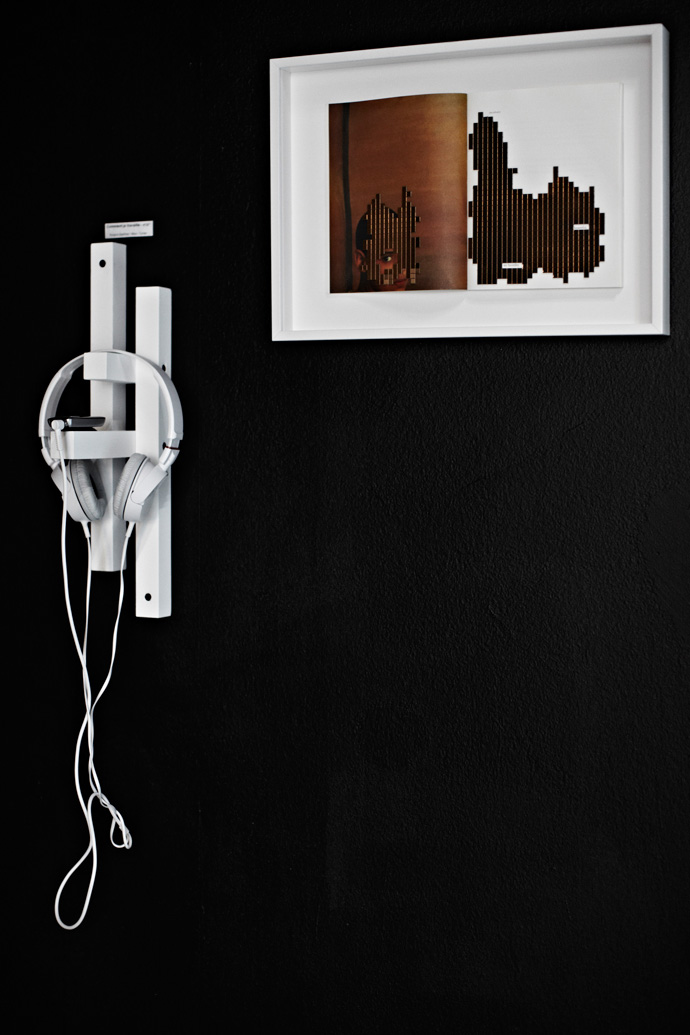
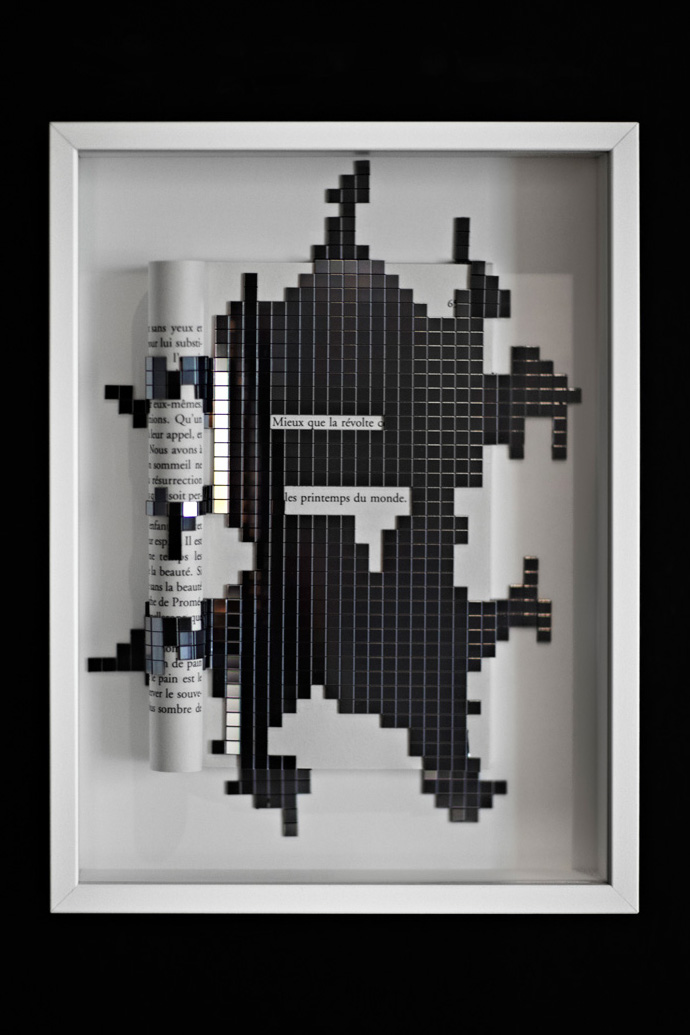 The collage sonore / sound collage installation in room 2. Courtesy Gallery Anne de VillepoixNear the pass to the next room the only book that depicts an image and with this marks the transition to the last complex of works. It’s all about stars and fashion magazines. But now the presentation enhances the fact that the magazines departed from being just the source of material. They become objects themselves, so does the frame and the fixture. It becomes altogether an installation: A cabinet of seven blocks present the works on shelves, hung, or in frames that at times can be turned and reveal a mirror. Mirrors everywhere. “Beyond, beyond, beyond the mirror”, as Patti Smith proclaims earlier in one of the audio collages.
The collage sonore / sound collage installation in room 2. Courtesy Gallery Anne de VillepoixNear the pass to the next room the only book that depicts an image and with this marks the transition to the last complex of works. It’s all about stars and fashion magazines. But now the presentation enhances the fact that the magazines departed from being just the source of material. They become objects themselves, so does the frame and the fixture. It becomes altogether an installation: A cabinet of seven blocks present the works on shelves, hung, or in frames that at times can be turned and reveal a mirror. Mirrors everywhere. “Beyond, beyond, beyond the mirror”, as Patti Smith proclaims earlier in one of the audio collages.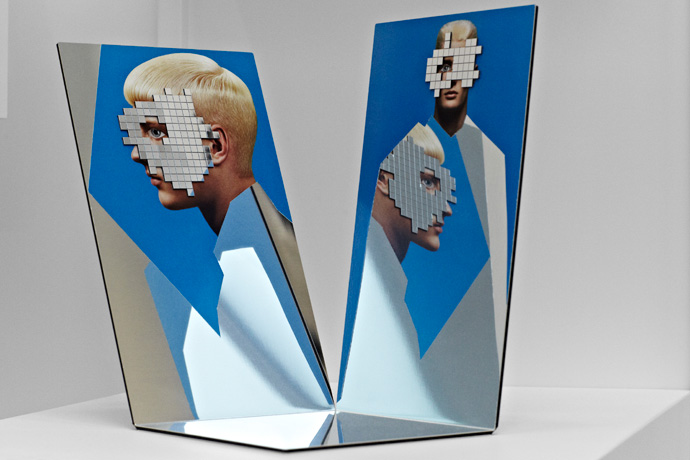 Object in room 3 at Gallery Anne de VillepoixMarc Turlan: EXO STARopening Saturday 10th, running to October 15th 2011at Galerie Anne de Villepoix, rue de Montmorency, 75003 Paris
Object in room 3 at Gallery Anne de VillepoixMarc Turlan: EXO STARopening Saturday 10th, running to October 15th 2011at Galerie Anne de Villepoix, rue de Montmorency, 75003 Paris -

not lost : ræve
-Once upon a time, we made a fashion film shoot with some of the best men’s designs around.
Givenchy, Raf Simons, Ann Demeulemeester, Rick Owens, Gareth Pugh, Comme des Garçons…we had it all. We also had a great concept (think butoh meets inception), a fantastic cast (Ippei is an amazing butoh performer, while Matvey and Willy, both top men’s models, would film Woodkid’s IRON video a few days later), great hair and great make-up, everything great.
RAEVE stroke-inducing poster by Clément Roncier.
Only problem was, we never really found the time to edit it.
Until now.
So without further ado, ræve.
RAEVE
by Antoine Asseraf & René Habermacherstarring Ippei Hosuka + Willy Cartier @ Success Paris + Matvey Lykov@ Success Paris
styling Jean-Luc Française / photo assistant Laurent Dubain / styling assistant Tiphaine Menon / hair Tanya Koch @ B Agency /make-up Akiko Sakamoto / studio Le Petit Oiseau Va Sortir
editing Axelle Zecevic / Clément Roncier / postproduction Clément Roncier / music Oedo Sukeroku “Shunrai” + John Cage “Sonata V” / special thanks Jean-Marc Locatelli
-

THE BERG SANS NIPPLE
-‘Build With Erosion’, doesn’t pertain to any set form or principle. It’s a challenge: a deeply experimental and infectious third album from The Berg Sans Nipple, combining devastating melodies and a mind bending rhythm section informed by disciplines as diverse as gamelan, dancehall and DC Hardcore. THE BERG SANS NIPPLE is Lori Sean Berg and Shane Aspegren.
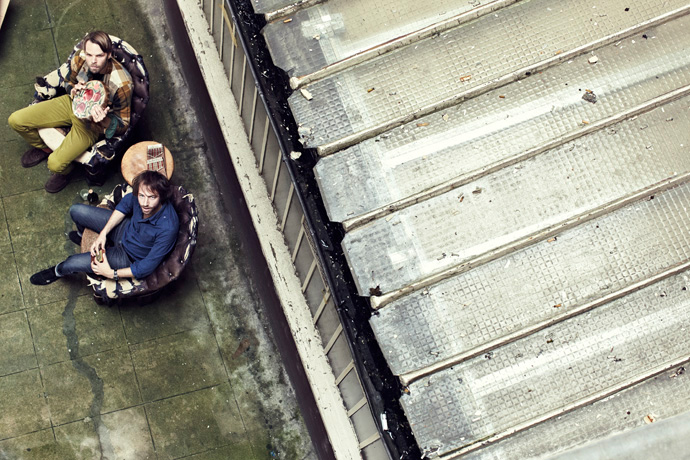 Lori Sean Berg and Shane Aspegren jamming on a cloudy day in Paris. Photo by René Habermacher
Lori Sean Berg and Shane Aspegren jamming on a cloudy day in Paris. Photo by René HabermacherWhat was the last thing that inspired you?
S: That’s a hard one to answer. As time goes on, it’s a lot harder to be really be blown away by things. We just did the project with Le Musee Du Quai Branly in Paris and had the chance to dig through their audio archive. This was really refreshing to work on to discover new sounds from around the world. Also, Lori and I saw the Anish Kapoor installation at Le Grand Palais together and that was really amazing. It was something that you needed to spend some time inside to appreciate the full effect. I suppose we like things without immediate gratification.
Can you remember a particular inspiration for your latest album BUILD WITH EROSION?
S: The record was created over such a long period of time that there were so many things that were poured into it. In the end, the theme of erosion was really important.
L: We use a lot of eroded musical equipment. I’m not sure how to say it? We love dust!
S: In a way it’s always been a theme of the band… using instruments that are on their way out, or loving the sounds that came from pedals with dying batteries…
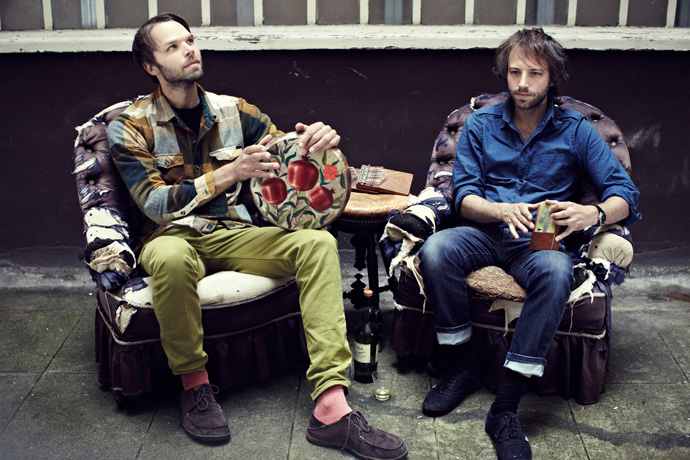 THE BERG SANS NIPPLE in action. Photo by René Habermacher
THE BERG SANS NIPPLE in action. Photo by René HabermacherIs the concept of “erosion of instruments” something that interests you conceptually or is it the frailty of sounds created?
S: I guess it’s both of those things. There’s always been a balance of harshness and beautiful sounds in there. Also, lyrically, it all ties in together, but that’s all there for people to digest as they’d like.
L: I love instruments on their last legs. I want to give them a second life
Tell us a little more about why you work with concepts. In advance of the album release, you set up a site for BUILD WITH EROSION incorporating the surrealist concept of the exquisite corpse. You used this concept again for the promotional video for Change the Shape. Why?
The Berg Sans Nipple – Change The Shape from Clapping Music on Vimeo.
S: A band that I was part of back in the late 90’s used to make exquisite corpses in the van on tour and, at that time, I was really into the Surrealists. I’ve always wanted to do a project like that and it worked really well with the “Change the Shape” theme. It also gives a different energy to a project when you can get a bunch of other artists involved.
L: Although “Build with erosion” is not a “conceptual” album…
S: Maybe not conceptual in the sense of advance planning but, in the end, it developed into a unified concept. Things become what they are and it all makes sense together.
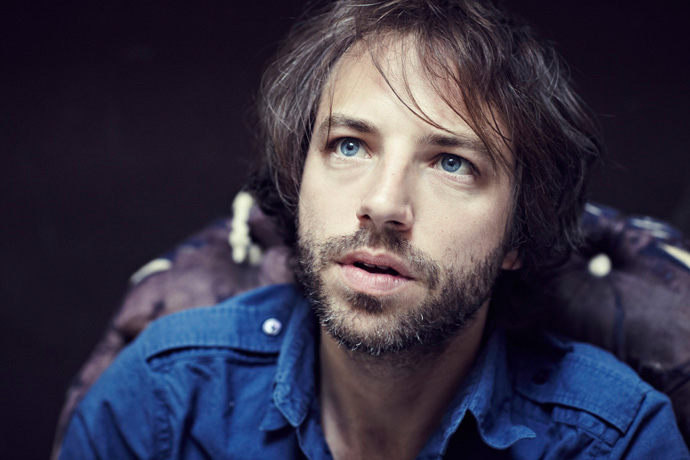 Lori Sean Berg of THE BERG SANS NIPPLE
Lori Sean Berg of THE BERG SANS NIPPLEOne of my favourite tracks on the album is DEAD DINOSAURS RULE THE EARTH. How did that track develop?
Dead Dinosaurs Rule The Earth – The Berg Sans Nipple by blackmaps
L: From Zari!
S: Of course, the title came from my daughter and I jotted it down in a notebook. We had a bass line and drumbeat in a tape full of improvs that we had done together and I thought that the title was perfect for the bass line. As always, it went through a lot of transformation to get to the end of that track, but it all stemmed from a child’s mouth and an improv.
L: An old old idea. Probably recorded from my minidisc.
S: Yep, that wasn’t one that we created from opposite sides of the world. Apart from the lyrics, it was worked on in an old fashion style, when we were together. I think even all of the kalimba lines were from that minidisc!
Lori, you live in France and Shane, you live in Nebraska. Do you work together while living apart by exchanging ideas or do you tend to do most of the work in the concentrated periods when you are actually together?
L: We really need to be together for “the moment “. But maybe we could do a conceptual album through skype next time?
S: It’s really combination of the two. The best stuff comes out in the concentrated periods of being together though. The brooding and frustration comes at the other points, but then gets weeded out when we meet up again.
L: That sounds agonizing. But when were together we have a lot of fun, we play pinball and drink wine and champagne.
S: visit caves…
L: and meet cavemen…
S: Cro-mags from the perigord noir!
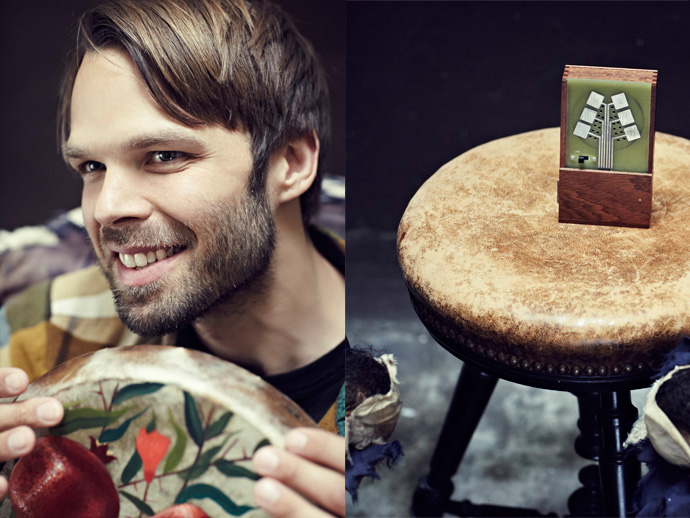 Shane Aspegren has a fable for unusual soundtools..
Shane Aspegren has a fable for unusual soundtools..The Berg Sans Nipple is known for its amazing live shows. How do the two of you go out there and recreate the complexities of your sound?
S: We started as a live band. In fact the first few shows we did, we never repeated any of the music that we made, but were really just writing a set of music to perform live. Now thing are a lot more complicated in that we’re writing in the studio and then trying to figure out how to transform that into a two person live setting. I love both sides, but it’s become more challenging as things have evolved.
L: It’s always a “casse-tête chinois” when we play shows! I think it would be much easier for us to simply work in the studio. But it’s important for us to play live music… to be connected with people.
S: We’ve always tried to make a connection between each other, even through sampling each other live and setting up face-to-face. I think that was our first goal in playing with each other. So the idea was the inception of the band. And hopefully that’s how we connect with our crowd.
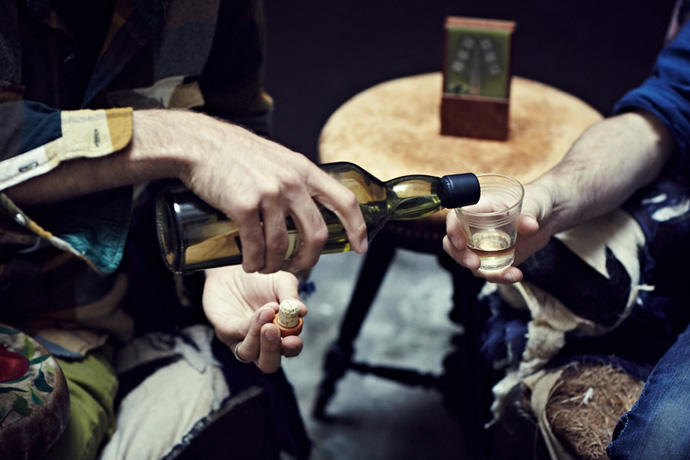 ...and malt brew
...and malt brewYou both work outside the band, including work in film and photography. Do you have any favourite photographers or visual artists?
S: I have a hard time pinpointing favourites of anything. I was really into Robert Frank and Duane Michaels and photographers like that when I first started taking photos, but there’s a lot to love about so many things. I like colour a lot more now. But speaking of visual artists, we’re really lucky to have been working with Cody Hudson and Stephen Eichhorn (who were responsible for the artwork for “Build with Erosion”).
If THE BERG SANS NIPPLE could work with anyone who would it be?
L: Johnny Cash.
S: That’s interesting. I feel like it’s always the thing that’s the most exotic that interests both of us, which is maybe why the trans-atlantic game works for us. I’d probably say that scoring something with Ennio Morricone or maybe even moreso, Bernard Herrmann. It wouldn’t necessarily be a film though… maybe something in a public setting. Or we could score Johnny Cash’s life.
In what direction do you see THE BERG SANS NIPPLE developing into in the future?
L: Pinball sound design. That is the future for me!
S: If Lori is going to go off on his own to get lost in pinball world, then I guess that it’s, the end! We’re trying not to focus too much on the future but to work on the present as much as possible. We’re starting to do a lot more film work together and that’s what we’re really interested in. I don’t see us ever stopping making music together, but we’re also ready for another step into other things. We’ve got another project in the works as well… a new record with a different concept that won’t necessarily be the BSN, but will still be in the same spirit.
-

the end of summer hypernation
-The Stimuleye is back from summer hyper-hybernation.
After a galloping transatlantic spiral of frenzy, we lay exhausted for days on various shores around the globe. Meanwhile, not entirely lazy, some of the Stimuleyes danced away in Watermill or invented a bookclub of a new, performative kind, shuffling readings of MANHUNT, STILETTO and Jackie Collins’ masterpiece THE STUD into a new, exciting bootleg. But more about that later.
During this hot days another Stimuleye project rushed through printers rotation: a collaboration with Marina Abramović featuring Freja Beha Erichsen photographed by René Habermacher for POP magazine.

 Freja Beha Erichsen and Marina Abramović, both posing with Marinas "mini-me" and wearing GIORGIO ARMANI
Photography by René Habermacher
Freja Beha Erichsen and Marina Abramović, both posing with Marinas "mini-me" and wearing GIORGIO ARMANI
Photography by René HabermacherThe Fall Issue will feature 2 covers with Marina and Freja and an inside story with exclusive interview, plus a limited edition hardback showing Marina’s death mask. Some of our fellow readers might recognise another co-star: yes, it’s Daisy the Boa which we met in Manchester, in an attempt to strangle the alter ego of Marina, her “mini-me”.
Coming soon to the newstands, the new POP is investigating this time THE REDEFINITION OF THE LADY. As Ashley Heath, its publisher puts it:
“POP has been exploring the notion of a very particular kind of modern fashionable woman. But it’s shifting all the time in such an interesting way. There’s a very liberated, new-world perspective to it and I think Marina Abramovic taps into that. She’s a figure who will only continue to grow in influence I believe. You hesitate to use the word ‘icon’ these days, but Marina and Freja are both resonant female role models at a time when lowest common denominator so often rules the day”
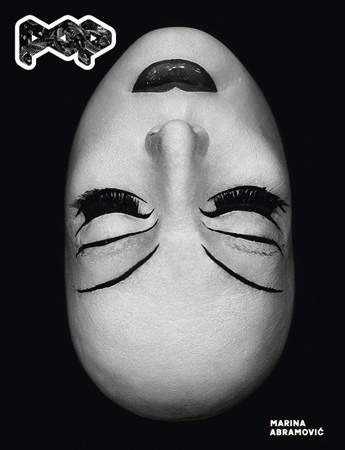
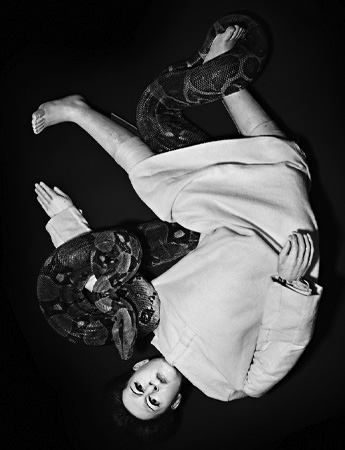 POP's Special edition Hardcover with Marina Abramović's death mask and "mini-me" wrestling with Daisy.
Photography by René Habermacher
POP's Special edition Hardcover with Marina Abramović's death mask and "mini-me" wrestling with Daisy.
Photography by René HabermacherMARINA CREDITS: Styling Isabelle Kountoure , Hair by Chi Wong at Julian Watson Agency using Shu Uemura Art of Hair, Make-up Yannis Siskos at Effex using Giorgio Armani Cosmetics, Photography Assistance Jonathan Flanders & Hannan Jones, Digital Remastering The Stimuleye, Snake Wrangler David Steward for Creature Feature, Production Lynsey Peisinger for The Stimuleye
FREJA CREDITS: Styling Isabelle Kountoure, Hair Peter Gray at The Collective using Shu Uemura Art of Hair, Make up Romy Soleimani at Management Artists, Manicure Tracelee Percival at Vue using Priti NYC, Model Freja Beha Erichsen at IMG New York, Casting Angus Munro at AM Casting, Streeters NY, Photography Assistance Cesar Rebollar, Fashion Assistance Jodie Latham, Stephanie Waknine, Rebecca Sammon & Michaela Dosamantes, Digital Technician Dilek Islidak, Digital Remastering The Stimuleye, Set Design Anne Koch at CLM NY, Production John Engstrom at Scheimpflüg Digital, Shot at Eagles Nest Daylight Studios NYC
-

editor MASANOBU SUGATSUKE : An edit of an edit
-Masanobu Sugatsuke is one of the most influential editors, publisher of magazines such as COMPOSITE, INVITATION or METRO MIN in his native Japan, and of books with Mark Borthwick, Elizabeth Peyton or Jeff Burton. Masa considers himself not exactly a trendy person, yet is always on a forward trail, much ahead of his time.
THE STIMULEYE talked with Masa on the outlook of publishing and the editors future role, but also his recent book EDITORIAL PARADISE in which he is looking on his past editorial work. A reflection in a radical manner, rarely dared by others of his guild.
An edit of an edit, a compilation of compilations?
He’d been advised by a fellow columnist that “When an editor enters the spotlight, he automatically announces that it is time for him to go” he was told, as well as “an expression reaches a deadlock the moment it becomes self-referential”.“But wait a minute,” he writes in his foreword, “Godard and Truffaut initiated the Nouvelle Vague with their filmic reflections on film; contemporary art has developed as a form of “Art reviewing art”, and Rei Kawakubo and Martin Margiela keep proposing dresses that inspire the wearers to think about dressing. Could it be that there exists a whole different level that self-expression can only reach after going through the painful stage of self-reference?”
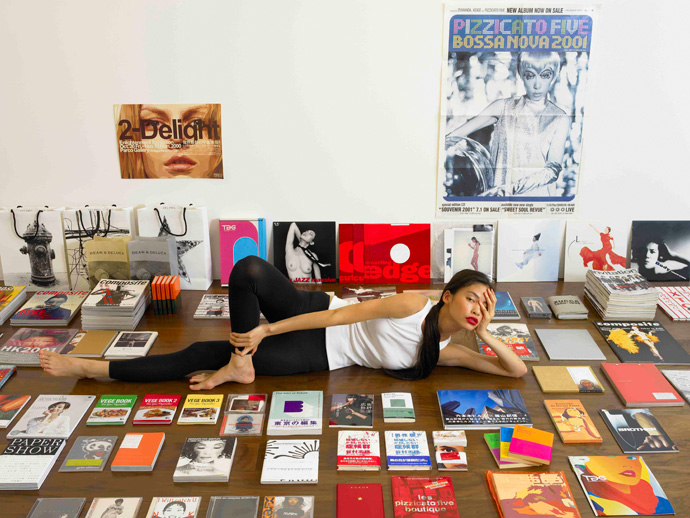 Works of Masanobu Sugatsuke laid out for EDITORIAL PARADISE.
Works of Masanobu Sugatsuke laid out for EDITORIAL PARADISE.When i visited you at you last time in Tokyo at your office – we had not seen each other for quite a long time.
Meanwhile you had halted “Composite” , and published your book “Editorial Paradise” revisiting your inventive editorial work of the last 25 years. Interestingly, this reflection coincided with a turning point, a time where the role of the editor is challenged through mechanics introduced by new media. To me it almost felt like a “katharsis” (精製) – in this context. Not only a personal one…
Talking about my book “Editorial Paradise”, I think that a retrospective book of a living editor sounds strange for everybody, even for me!
But to edit and launch it, it made me consider a lot about the role of editors and definition of editing nowadays.
I believe the role and definition of editors and editing has been drastically changing these days, because of the growing role of new media. But a few editors have been trying to define their new roles and public meaning.“katharsis” you mentioned is quite a suitable word to describe my time editing this title. Editing this retrospective is like confession for me. But confessing what?
I can tell you about it clearly now, I didn’t know the meaning of editing until that time.For this book you told me you’ve decided to include everything from the volumes that you’ve done, which is somehow “anti-editing” – was that part of making you realise the meaning of editing? What is your conclusion?
I’ve always aimed to expand the definition of editing. Through the editing process of this editorial retrospective, I recognized that the changing state of editing my thinking simple-minded.
So, what I came across through this process, – it was fun but hard for me to think deeply about editing all the time all day long and I felt like being ouroboros – is that editing is not about media.
I think editing is a way of thinking. It’s not like making film, designing a website. It’s a purely abstract idea to make something concrete.My definition of editing is quite simple.
1: Drawing up a project,
2: Recruiting a team of collaborators,
3: Creating something,They are the three basic conditions of editing, I think. If someone does something with these three conditions, whatever it is, I’d like to say “that’s editing”.
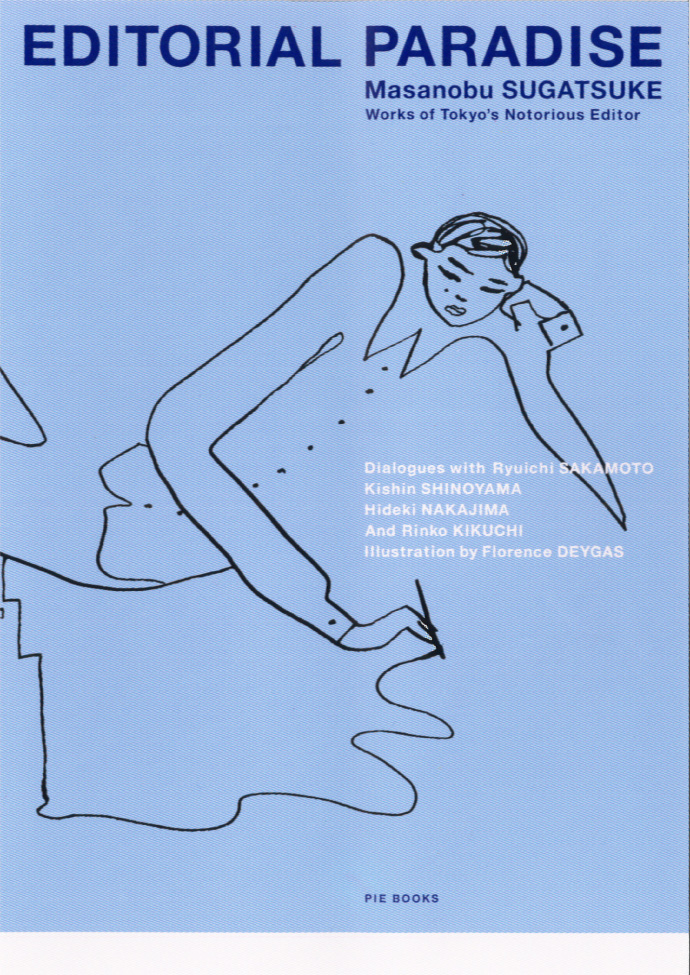
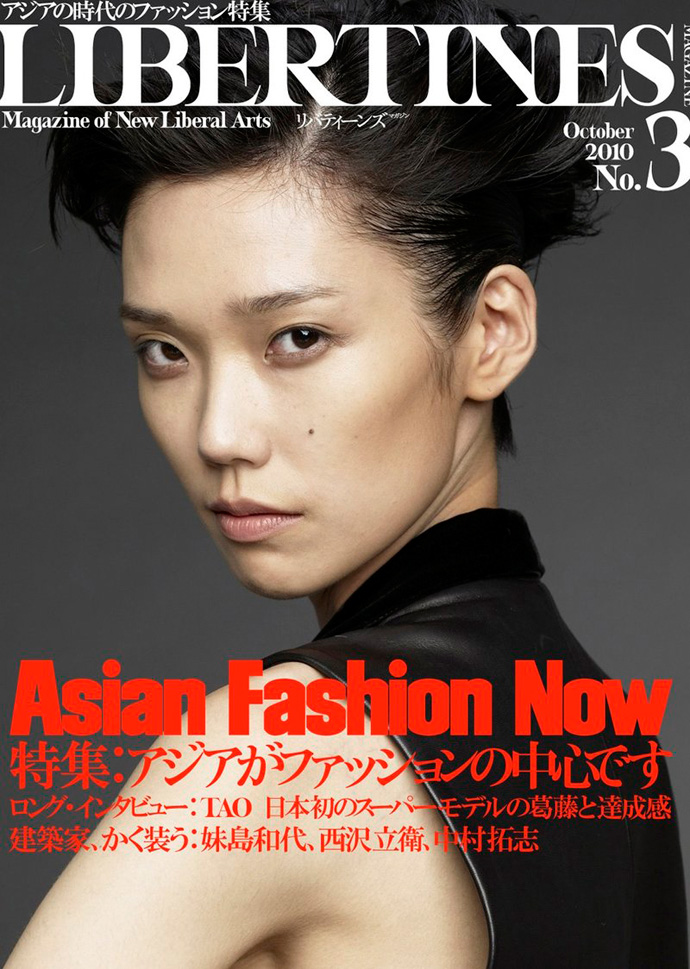 Sleeve of EDITORIAL PARADISE with an illustration of Masanobu Sugatsuke by Florence Deygas and a recent LIBERTINES cover
Sleeve of EDITORIAL PARADISE with an illustration of Masanobu Sugatsuke by Florence Deygas and a recent LIBERTINES coverIt’s something rare in this profession to put a focus on the act of editing itself, especially one’s own and in such a radical way as with your latest book.
As you can see, editors have been defined as interpreting someone to someone else, or something to something else. That means “Don’t express your own voice through your works. You are an in-between guy!”.
That’s 50% right. But there are so many high-profile advertising creative people all over the world. They are not behind the media at all nowadays.I believe editors are mainly present in-between and behind media, but sometimes they are beyond media, i.e, Anna Wintour, who is Cabinet Minister of the Ministry of Cool, Terry Jones, Everlasting Evangelist of Street Style and Olivier Zahm, the second Gainsbourg.
I believe we, creative people, have to label ourselves. In other words, we have to “transform life into creation”.
Because, in this 21st Century, our creative lives are almost viewed and leaked by web and twitter.
It’s been getting hard for creative people to avoid being watched or criticized by ordinary people now.Iconic editors from the past seem in this context like vanguards of another time to come:
Diane Vreeland (American Vogue) or, on another side of the spectrum, Hugh Heffner (Playboy), both transcended their editorial vision with their personal lives.Today’s ever more fragmented stream of information requests perhaps a stronger necessity of structure through the personal standpoint…
How do you think the element of today’s over-exposure is influencing the role of the editor?
Over-exposure is big phenomena in our world, not just for editors. Modern people are fame-addicted.
On the other hand, we can show our way of living as an art piece. Lady Gaga’s case is the most excessive one, and Haruki Murakami’s case is the most stoic.
But both are most successful presentations of life as art piece today.As I said, our creative lives are mostly viewed, watched by the media and each action are “timeline”d.
So if you can’t avoid it, you have to be determined to show your life as whole art piece, as if Andy Warhol presented us.
So, Warhol said “Everyone will be famous for 15 minutes” in the 60’s.
But now everybody became Andy Warhol, just like taking photo everyday, quoting somebody’s ideas and images and commenting as one phrase philosopher on twitter or blogs.Our creative works are slices of our creative lives. People nowadays have a tendency to prefer the real lives of creative people to their work.
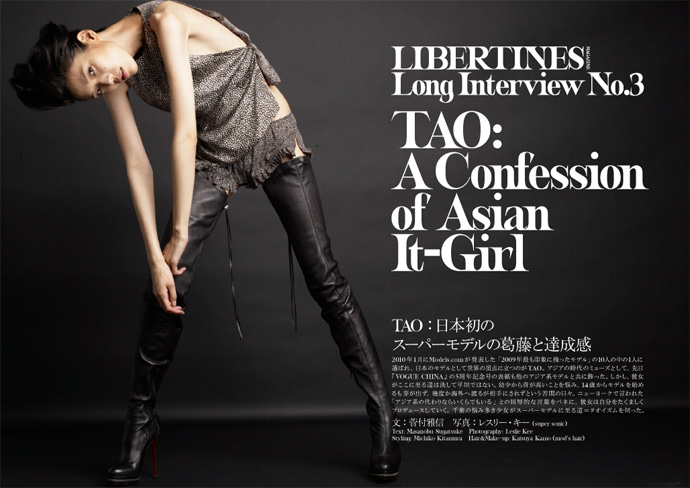 Spread of "AISIAN FASHION NOW" from a recent issue of LIBERTINES. Photo by Leslie Kee
Spread of "AISIAN FASHION NOW" from a recent issue of LIBERTINES. Photo by Leslie KeeIn these times, the stream of facebook statuses, tweets and re-tweets, tumblr and so on form a new way of consuming information.
You recently mentioned Paper.li to me – which seems like an attempt to “master” this stream almost a form of an “automatic generating editor”….Yes, “Paper.li” is a kind of semi-auto-updated personal web magazine. On the web, if you curate something, you can be an cool editor. Therefore “first hand” is getting more important for media and creative people. Audiences can’t get interviews of celebrities and take their photo first hand.
So, “first hand” sources and high profile people are the last sanctuary of professional media and creative people.
But if they are lazy to maintain “first hand” capability, audiences will rob it.The internet is certainly a big accelerator of this “theft”!
What we’re missing out besides “first hand” is the synthesis of information and its digestive analysis.
I am wondering how do you expect the print media to react to this and how you see its perspectives in the long run, in balance with the digital publishing?I expect that print media will live with digital media in symbiosis. I believe print media will survive, as opera and theatre play do.
But not mainstream in the media.
There are two kind of information, flow and stock.
Internet is a best media of flow information. Print media is a best of stock information.
For creative people, beautiful books must be great tangible assets.
In this 21st Century, tangibility and physical experience can be more important because internet cannot provide them.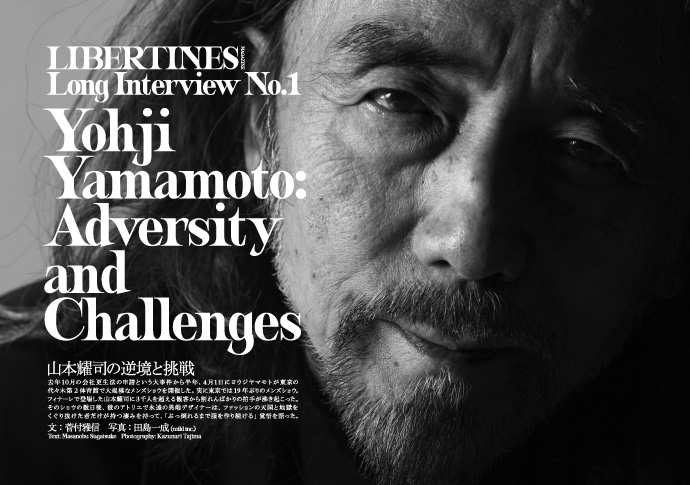 Opener of the Yohji Yamamoto Interview of LIBERTINES
Opener of the Yohji Yamamoto Interview of LIBERTINESYou have recently halted publishing your most recent print magazine “libertines”-
what was your experience with this? Were the reasons related to the shift in publishing that we’re talking about?Talking about the end of “Libertines” magazine, I think I was a little bit too optimistic about the advertising climate and today’s readers. It was my fault.
Advertising for magazine has been drastically decreasing. I knew it. But I had estimated that I could have get a certain amount of it when I started “Libertines”.
But I couldn’t. It was worst time to start a new magazine in Tokyo with a professional level of budget.Plus, I thought we could get a number of readers similar to what we had before. So, for the first issue of “Libertines”, we had a special feature about twitter culture.
We had exclusive report about twitter headquarters in San Francisco in it.
As you can imagine, we got big buzz on twitter and web when it came out.
BUT this buzz were not enough to sell magazine.It is a similar situation for musicians and the web. If some musicians get big buzz on twitter and facebook, but their record sales are not related with buzz unfortunately these days.
It happens in magazine world.I think “buying magazines” has become an old habit, or habit for people over 30’s.
If you aim to produce youth culture-medias and package contents, there are few actual youth consumers who buy them naturally.On the other hand, I’ve been directing another magazine “Metro Min.” for two years as creative director, it is quite successful because it’s a monthly free lifestyle magazine which is published by a major publisher.
So, it is hard to sell magazine to the FREE generation. I’ve been struggling with this issue.
I don’t have a clear solution for it. But I’m not pessimistic about the future of magazines. I think publishers and editors have to organize a new kind of structure to make profit not only to produce print medias.I believe there are great examples in the movie industry. The movie industry is not just about movie theatre nowadays as you know. It is an environment with movies.
I think that’s the hint for editors.

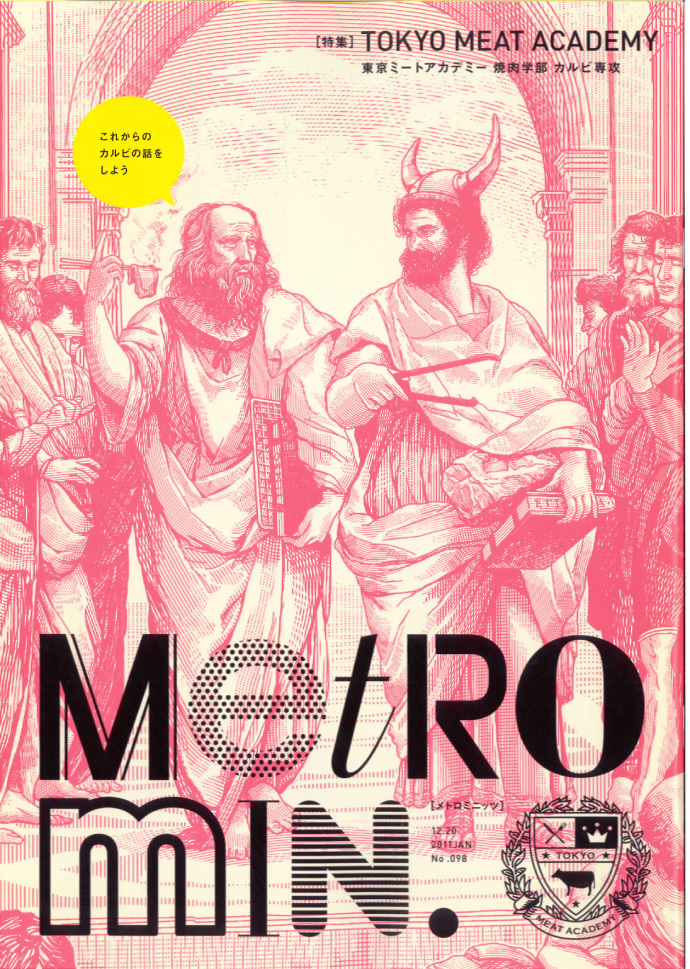 Covers of METRO MIN, the most recent publication of Masanobu Sugatsuke
Covers of METRO MIN, the most recent publication of Masanobu SugatsukeWhere do you see the future?
I’ve been thinking about the fate of both print media and new media all the time as I mentioned in our previous conversations.
And as you see, nobody knows. But there is one certain thing that I can say, that is if you love something, you’d like to own and touch it.
Same as your lover. That’s the human nature which will not change forever.People nowadays talk mainly figures and speed of modern media. But media are not only produced by them. Of course, these specs are important.
But images, sympathies, affections and favoritism are very important elements of media.
If these elements are all included in one media, then it will be a loved media no matter if it’s in the form of digital or print.I believe that creative people have to concentrate on how to produce a loved media to audiences. I think that’s the priority.
The last thing stimulated that stimulated you?
So many things and it is hard to answer to choose one particular thing.
Here is the list what I was stimulated after 3.11, the Great Earthquake in Japan.# Cindy Lauper concert in Tokyo on March 17th, just 6 days after Earthquake.
Cindy is a quite brave artist who did Japan tour in such a catastrophic situation and she commented during each break between songs to encourage audience in Japan.
She sang her masterpiece “True Colors” in encore with mix of John Lennon’s “Power to the people” and almost the whole audience, including me, wept.# Takashi Homma photo exhibition at Tokyo Opera City Gallery in April
Homma’s biggest exhibition in Tokyo which shows his conceptual landscape in Japan and Los Angels which was collaborated with Mike Mills.# Jane Birkin Charity live at Shibuya Club Quattro, April 6th
Jane Birkin is not just an actress or singer. She is a role model of modern women.# Anti-Nuclear Demonstration in Koenji, Tokyo, April 10th
Most biggest and joyful anti-nuke action in Japanese history. So many musicians joined it and I participated in it. People have the power!# Saburo Teshigawara dance performance at Kawasaki City art center, May 6th
It is a final answer to the question “How can movement of human body be radical and beautiful”. Teshigawara does European Tour this Autumn. Must-See!# Henry Darger exhibition at Laforet Museum Harajuku, Tokyo, May
Legendary outsider artist’s big retrospective. So innocent and scary.# Yohji Yamamoto’s 30th anniversary party of his brand at Y.Y boutique in Tokyo, June 1st
Yamamoto is a last samurai of cutting edgy couturier. Congratulation!
-

Life and Death of Marina Abramovic – vii
-“An artist should avoid going to the studio every day”
STUDIO
Last night was the last performance in Manchester.Everyone in the cast and crew will soon be returning to their “normal” life, wherever it may be around the globe, to their city, their apartment, their studio.
Over the last week, seven exhausting nights, the play is ending.
It has been seen by Viktor & Rolf, Riccardo Tisci, the director of the MoMA and many others.But fear not, it will return, soon, somewhere else around the globe.
-

life and death of marina abramovic – vi
-Marina's 6th commandment. Photo by René Habermacher.
DICK
This is not a dick.
It’s a strap-on.
It’s strapped on a man, Andy.In the play, Andy masturbates while wearing a mask of Marina, as she flirts with him.
Tonight is the last night to see this, as it is the last night the play is performed in Manchester.
-

LIFE AND DEATH OF MARINA ABRAMOVIC – V
-“An artist should stay for long periods of time at exploding volcanoes”

Marina's fifth commandment. Photo by René Habermacher.
THE WIG
This is the wig of Willem Dafoe when it’s not on Willem Dafoe.
It’s in the make up room.In the play, Willem appears as a demonic, cartoonish narrator, meticulously going through Marina’s life chronologically, year after year.
-

LIFE AND DEATH OF MARINA ABRAMOVIC – IV
-“Enemies are very important”
Marina's fourth commandment. Photo by René Habermacher.
THE SNAKE
After an energetic premiere, the play keeps running until the 16th.One of the cast we havent yet introduced is Daisy, the boa constrictor.
Like bruno’s predecessor was stiffy, Daisy replaced the rolled-up blanket used for rehearsals.She naps in her well temperated box towards the minutes of spotlight.
It was difficult to find a hotel for her, says David the “snake-man”, so many houses had refused them shelter…Daisy and David. Photo by René Habermacher.
-

MARIOS SCHWAB
-MARIOS SCHWAB TALKS TO FILEP MOTWARY
PHOTOGRAPHS BY RENE HABERMACHER
Marios Schwab is known for his unique interpretations of natural forms and his ability to dress the female body in a way that he only knows.
While the world of fashion turns its attention to ephemeral trends, we decide to interview Marios and hear him analyze the Schwab philosophy, his position at Halston and the analysis of his very first Resort Collection, one day before its revealed to the public and press.
His collections are based around reflecting the inner structure of a garment on the outside, a theory that helped to define him as one of London’s most exciting designers – a position he continues to hold.
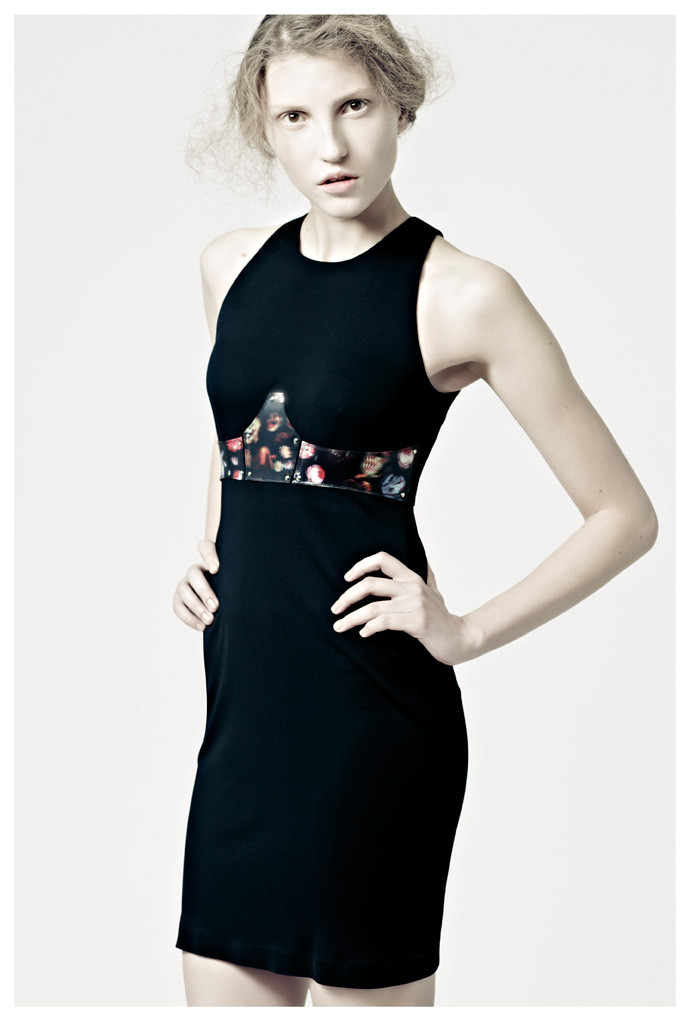 Marios Schwab resort collection 2012. Photography by René Habermacher
Marios Schwab resort collection 2012. Photography by René HabermacherA distinction and Best Student Award graduate of Esmod, Marios moved to London in 2003, where he completed an MA in Womenswear Fashion at Central Saint Martins, studying under the guidance of the formidable Louise Wilson.
Two years later 2005 saw him launch his own label, showing for two seasons with Fashion East before making his on schedule debut at London Fashion Week for SS 2007
Since the Spring of 2009, he was appointed as the creative director of HALSTON in New York.
Schwab’s designs are sold all over the world, in shops ranging from Dover Street Market, Harvey Nichols and Browns in London, to Maria Luisa in Paris and Barneys in New York.
Photographer Rene Habermacher met with him in London for the creation of the pre-collection’s look book
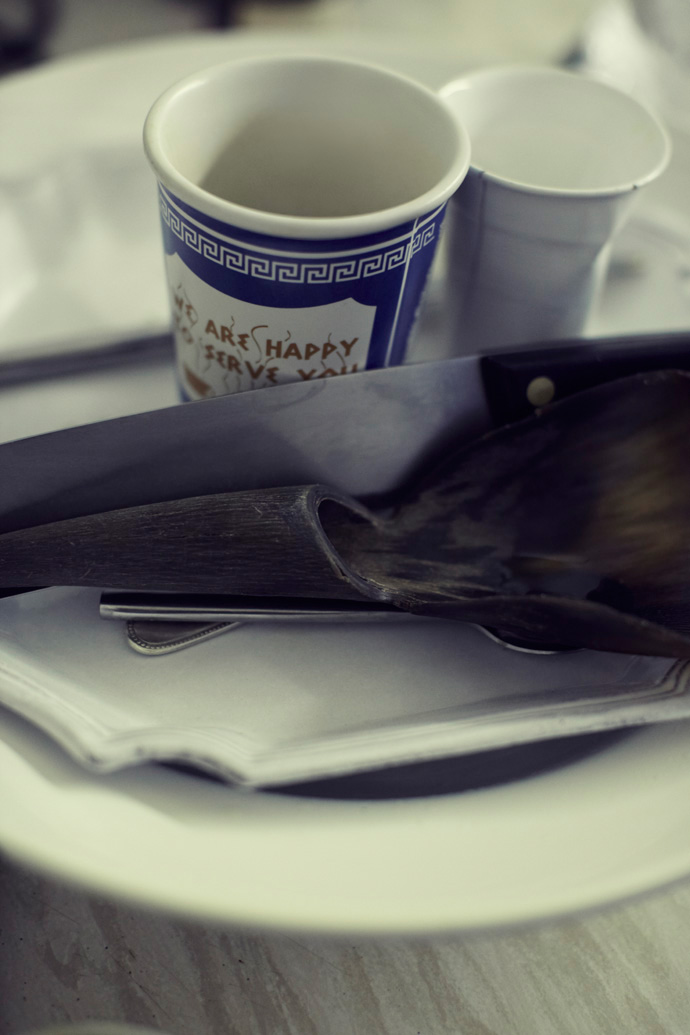
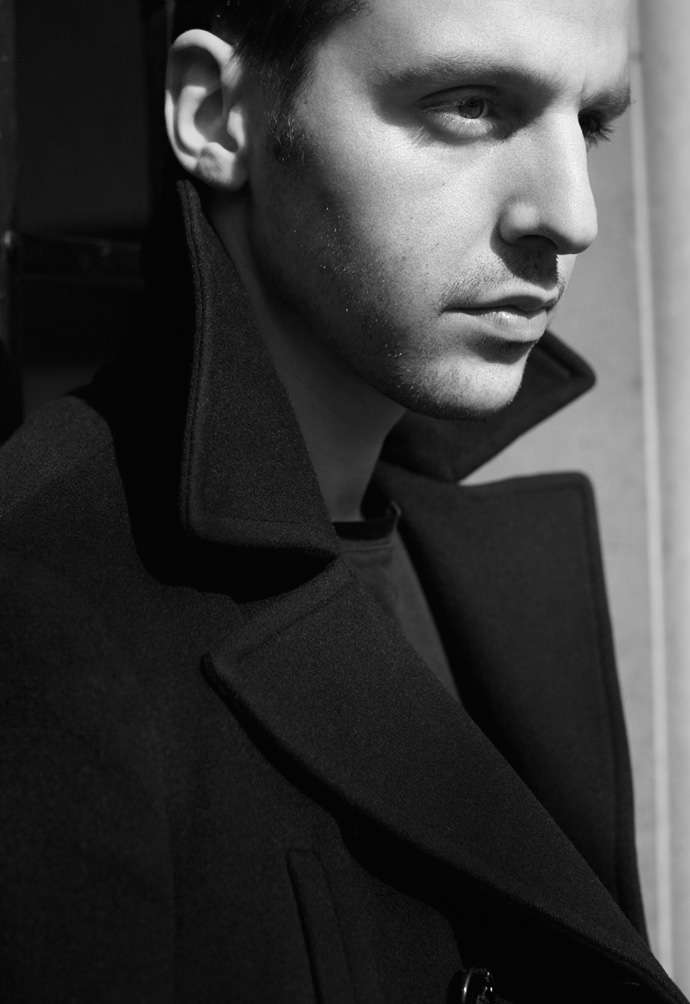 Marios Schwab and his Greek coffee set at his studio. Photography by René Habermacher
Marios Schwab and his Greek coffee set at his studio. Photography by René HabermacherHow are you today Marios, what have you been up-to since this morning?
Pretty much like I came from Paris and immediately started working on the main line…It’s a non-stop situation right now because I just did my first resort collection which was in a way an experiment in terms of getting in right with timings and deadlines, a completely new experience for me. Also we are producing this collection elsewhere outside the UK.
You just photographed your first pre-colection for Summer 2012 yesterday with Rene Habermacher?
We started shooting on Friday; he came over to London and shot the collection in my Studio.
What is your pre-collection about?
I went to Vienna for a weekend where I visited Kunsthalle and saw these amazing series of Vanitas paintings from Dutch painters. For me they always have this feeling of seduction and mysticism that I really like and the hide-reveal again which I am so obsessed about. I wanted to create a print that kind of works color but still within a black background…
It all started with creating the print with artist Tom Galland, who is a friend living near by and with whom we work on numerous collections together. The outlines pretty much echo shapes that have a classic sort of detailing from Maris Schwab, torn down so it becomes easy to wear and accessible for the younger girl that wants to buy, but not necessarily can afford. It’s about clothes for someone who doesn’t want to wear something that is too tailored.
How did you decide to add a pre-collection in your work? Was it after popular demand? What it the aim of a pre-collection anyway?
Yes first comes the “demand” as you said because the main line concentrates on tailored pieces, cocktail pieces mainly, and has the element of fabrics that are more sculpted. There was an easy-wear-feeling missing. You know, easy things that make more sense in a resort collection rather in a mainline. Fabrics like jersey, which is great to wear, in a good quality and good price. Its something that was requested from the top floor but also the feeling of having to return back to something that is a little bit younger was very very important to me.
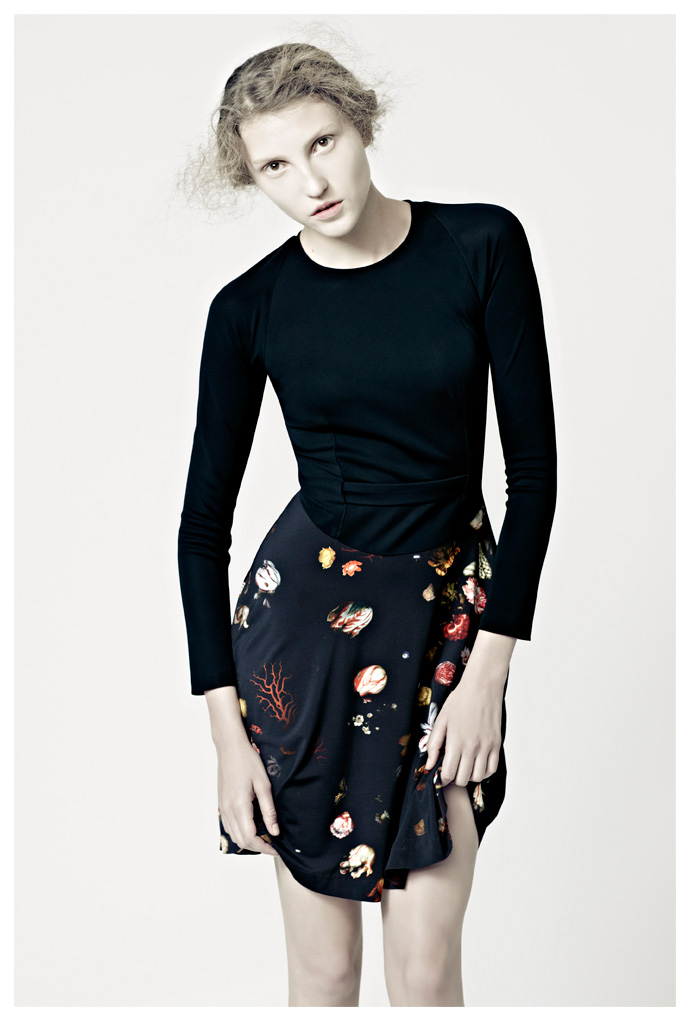
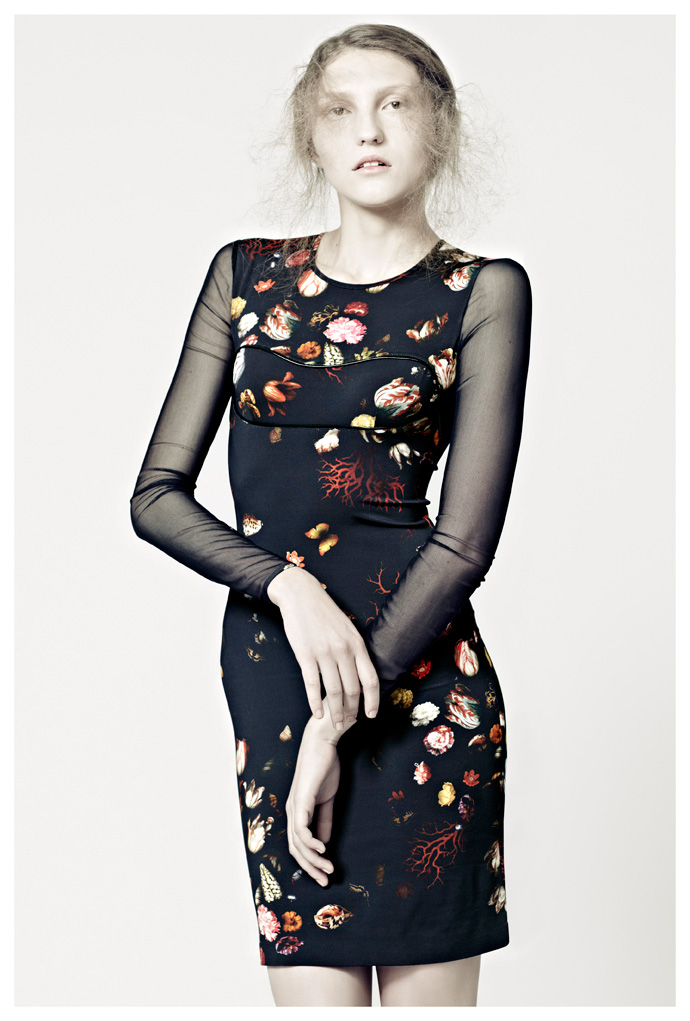 Marios Schwab resort collection 2012. Photography by René Habermacher
Marios Schwab resort collection 2012. Photography by René HabermacherHow is this collection pricewise?
Well it starts from 200 GBP and reaches s 750 GBP. That was the main point, to put very interesting detailing from the DNA of Marios Schwab-keeping the outline and fit on a friendly price. It is quite an interesting thing to do I guess because when you start a collection with this thought pros-mind-set becomes automatically an interesting project. I was concentrating on dresses that you can put on daytime and also in a club or to go travelling with and I think this is something I would like to concentrate on at this point and turn it as the signature of the resort
Marios, it often seems that you manifest an idea way ahead of its time, even two seasons before others pick your ideas later. How do you work, develop these ideas and where you withdraw your inspirations?
Well it’s a lengthen process because I always like to bring in the surroundings of my own life, or what I hear in any sense politics, stories, everyday life, as its an emotional story developed into garments. I don’t know how to explain it really. It usually starts with materials and then it develops into proportion and sectioning of the body in a certain way.
Last season how it started for example, was after a documentary I watched about ancient Greece and the oracle temples. There was this amazing building- I don’t remember where it is now-but it was saying that “nothing in excess.” And it kinda gave me the idea that basically its very much about what we are right now: overloaded with information but also we want so much out of everyday life, some can afford it, some cannot. For me, the process of it was to take this theme and create something that is beautiful with craftsmanship.
So I started reading essays about craftsmanship, then I came across the work of Adolf Loos, an architect from Austria who worked on finding the meaning of decoration and its meaning in society.
To cut the story short the collection was based on minimized craftsmanship and how it becomes an over precious part of each garment. So really framing the details on specific parts of the body that becomes precious at the same time.
I like to place things where they don’t belong from time to time. Broking was one element but also the status of symbols like a pearl necklace and how it can be re-translated in a modern way. Within this season, the Vanitas paintings for me meant life, beauty but at the same time possessions and darkness. It’s so beautiful and it reminded me of Victorian wallpapers, bursts of flowers with a dark background. All these harmless detailing in the collection like elastics that wrap around the body and create the draping reminded me of my earlier works since Spring Summer is very much about the inside outside, how you can retranslate draping without looking like a retro reference, you add a utilitarian element to it but then it’s a little bit more modern.
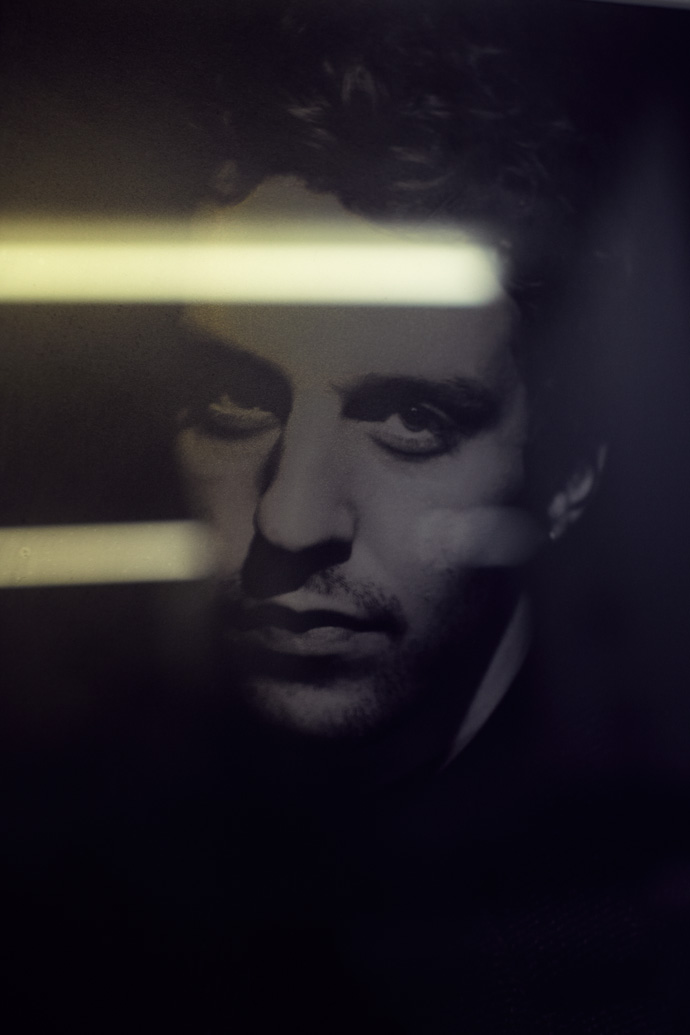
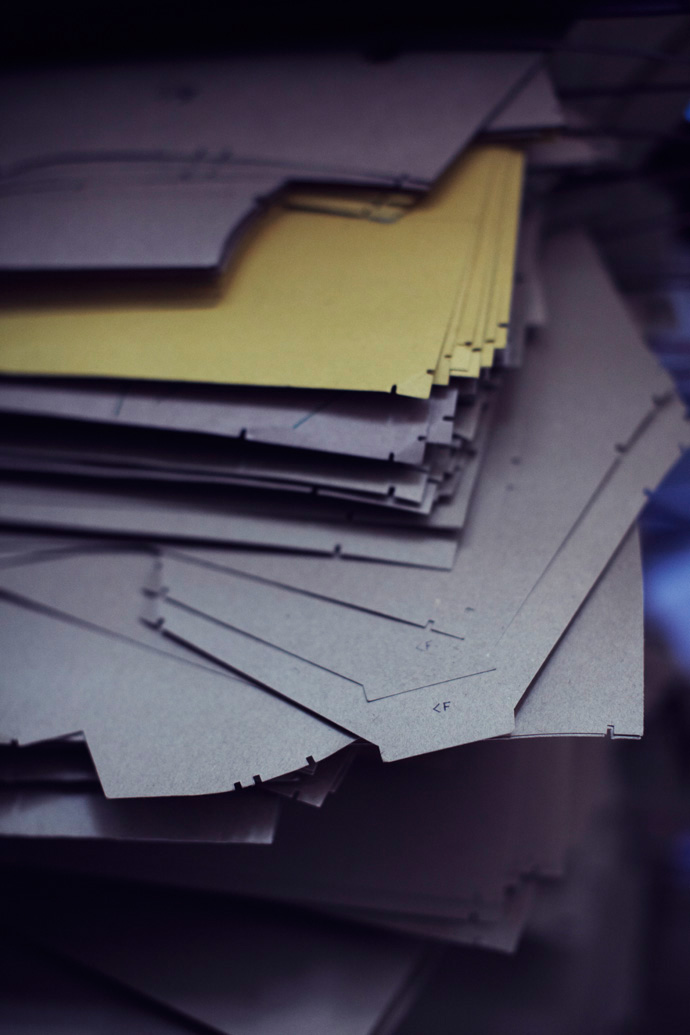 Vintage print of Marios portrait by Paolo Roversi, and Patterns at the studio. Photography by René Habermacher
Vintage print of Marios portrait by Paolo Roversi, and Patterns at the studio. Photography by René HabermacherIn the last five minutes you used the word “craftsmanship” for more than five times. How important is craftsmanship in your work?
It’s the most important thing for me. The way I learned the trade was going to Austria at the age of 15, surrounded by manic women, teachers that knew everything about traditional techniques, probably not very used these days unless of course you work for a couture house. It became my obsession and also something I am very much fond of. I like the humbleness of a craftsman and the sound of craft. I feel so comfortable sitting next to a person that is s specialized and so focused into his work. There is certain romanticism in it that I always go back to. I like sitting in a studio surrounded by the fabrics I just got from the manufacturer and then turn them upside down doing things I didn’t even suspect. I get a kick out of it, not to buy something that is finished but apply something to it.
I guess that can be said about women or the girls that inspire me. It’s a woman with personality- I don’t like women with no character. I don’t see a woman only as a body to dress. I see her as a strong persona that has a little bit more that just attitude. For me, women should be running the world at this point.
I like women who are intellectuals and private at the same time …I make a subtle story each time for them that does not overload their personality, enhances their personality.
While having a closer look at your past collections, I noticed that you continue to focus on the women’s body structure, emphasising on the waist and shoulders. Though now, your work has become more confident and much more strict than before…Do you agree, how do you see your work through the years?
Basically the starting point of a collection is always a naked body –in that I draw around the bodylines that are very much continued over the years I have been working. Whenever I dress a body I like to reveal what I also hide under a garment. From an architectural and proportional point of view it’s the most interesting part for me. What you cover you can reveal in a very sophisticated way on the surface of the fabric but also the cut.
There was certain toughness in your winter 2011-2012 collection with the use of leather and all…
The winter collection indeed had a feeling of toughness and that’s a classic element I guess in Marios Schwab that contains this femininity within something that is the good girl and the bad girl together. There is the prettiness and a sexual element within something that is sometimes quite strong and tuff. And I like to mix leather in a sense that you take the lady completely away from clothes. I don’t like ladies. I like to have a non-pretentious woman and I think that when you look closely to the garments you can see that they are not pretentious and that’s very much about the aspect of Schwab. My dresses need to be appreciated close by and I like that they don’t scream aloud but at the same time with a closer look you learn to appreciate them, their line and the detailing.
Taking elements that are very lady like and gentlemanly, for instance the broking and the pro necklaces kind of annoy me when I see them on women cause they are just too preppy.
I use them in a way that they become almost irrelevant of their status, hidden behind seams or they grow out of a seam either the are attached in a different way and become a utility, not just decoration. This is something I like doing also, using decoration at the same time in a functional way.
Remember the metal piece from an earlier collection of mine? The point wasn’t to create something shiny with a reflection in order to simply impress the guests of the show.
I thought of it as a garment that gives you this extra support when you dress up and feel you are wearing “something”. Psychologically, in some dresses this is missing, also in fashion these days. People used to take time to prepare themselves, so I tried to modernize this vintage routine within this shiny dress.
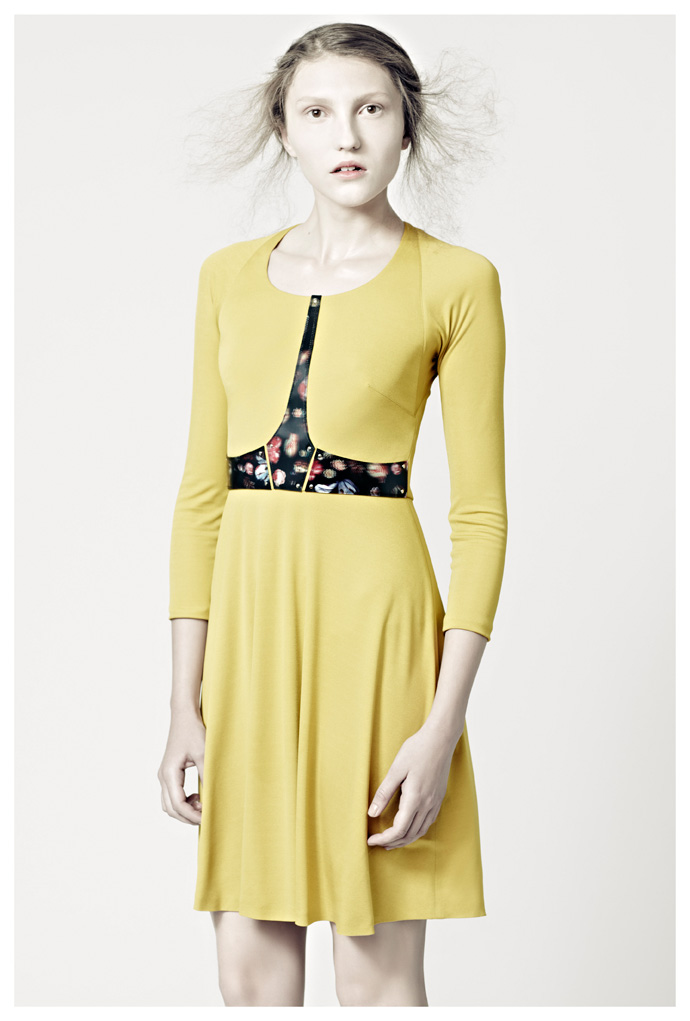
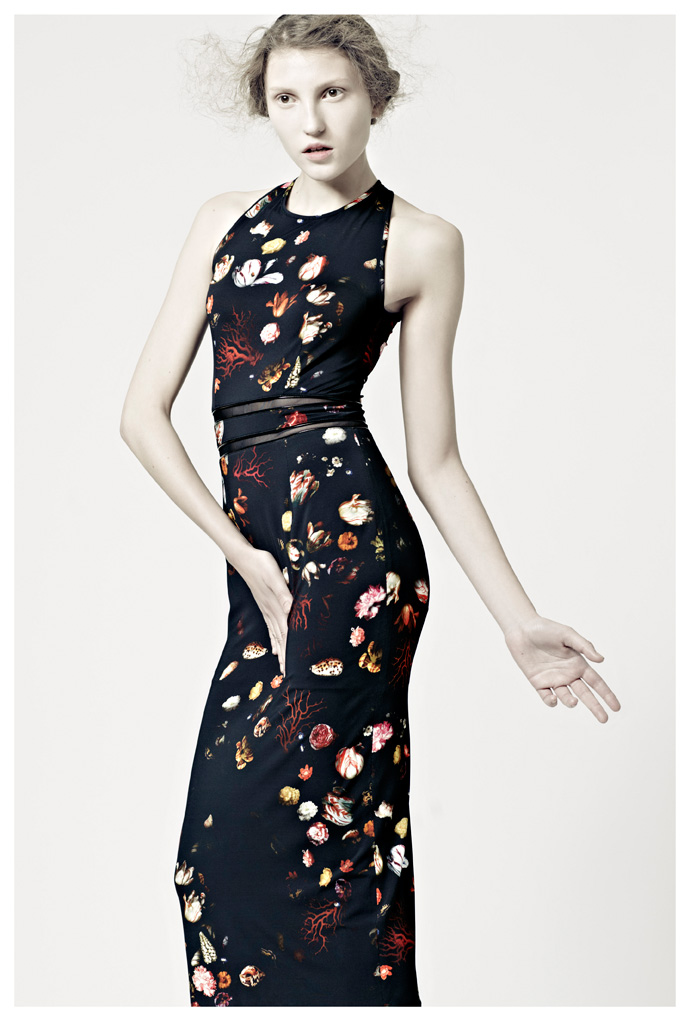 Marios Schwab resort collection 2012. Photography by René Habermacher
Marios Schwab resort collection 2012. Photography by René HabermacherHow has your involvement with Halston help your own brand you think?
I think it is such an interesting thing to work for another brand, with another team, travelling in a different country to produce a collection, which proved to be such a precious part of my Halston commitment. Basically you have a team that works abroad, that you are not very close to most of the time, you have different deadlines than your own. All these made me feel much more strong. You know also since I am the only designer there, I don’t have a team that designs alongside me which is exactly the opposite from what happens at Marios Schwab. It surprised me quite a lot. I always thought that it was going to be hardcore, working for two brands at the same time. It is hard but not as difficult I had in mind it would be.
Crazy in what sense?
Meaning the sense of “switching off”. I was surprised on how I could switch off from my collection, going to Halston do something else and then back again and back again… I felt a little bit scared before taking the job. It’s indeed a huge responsibility but you learn to do it, that’s it. Its pretty much like “you have to get on with it”!
What made Halston such a rarity as a House?
Halston as you know was concentrating on enduring fashion and I’d love to see Marios Schwab doing that,..
Halston encloses a story behind it that you can always see something else if you try looking closer. At his time Halston was creating, he offered something that was a very subtle, a minimal way of looking glamorous by wearing something simple and yet looking beautiful and seductive and expensive and clean. He had a very modern way of making clothes. The principle probably is the attractive one, what it was all about. But it was also attached to Studio 54, a very special place of that era and it was in everyone’s expectations. People just love it and for them Halston is attached to Studio 54.
Do you think your customers understand you better than your critics? Also how do you respond to bad criticism?
I don’t read reviews anymore because it just confuses me. After a show you are very tired and very emotional and personally the last thing I want to do is read criticism, good or bad. One critic can lift you up or drag you down which sometimes its not very relevant to a person that works in a very personal way and in private. I go meet people, the consumer, and the woman who wear what I create. You want to hear both at the same time, it normal but when you are still conquered by the after show adrenaline, you can’t just bother with that.
You belong in the Kane, Katrantzou, Pugh and Pilotto generation. It’s somehow like the “Antwerp’s Six” story. What in your opinion, all of you offered in fashion that was missing at the point you appeared?
I think quality, good fit within something that is very special and still acceptable and wearable. London at the time was about things that were more phantasmagorical..
So you are saying that you guys made the difference?
I’m not speaking about the rest, but yes I think that was what was missing at the time without pointing out someone specific.
Let me do that (laughs) all you have to do is agree or disagree (laughs). You all came at a point where as you said everything was very phantasmagoria and finally we had some wearable clothes coming from London, which was not the case before.
Yes, London started having a good balance. More than anything, the overall look was a little bit overwhelming. But I have to say that London is very special on that and supports all kinds of new developments, new ideas in fashion. It has to be said; you can’t really find that anywhere else’s in the world. Many people wonder, “What’s this thing about London, anyway?” But its true, London within this experimental nonsense or sometimes good sense it creates certain movements and in a way creates the platform for all of us to stand onto tomorrow..
What would be a designer’s weakness you think? What’s your weakness in that case?
Deadlines (laughs), free time. I can never organize myself to have a life. In this business you become very critical about what you do. It’s the mentality of living in your own bubble, creating for somebody else can be quite intimidating at some times, for others as well..
How difficult is for a designer to cross lots of different ages in one collection?
It’s a matter of confidence of the client. If you see a curvaceous person that wears a skin-tight garment, regardless of her age, whether she is a young girl or a woman and she has the confidence and attitude that matches the whole personality and appeal its instantly a success. This equals that the designer must have done something right.
Would you tell a client if she doesn’t look good in your dress?
Yes if she would ask me I would definitely tell her my opinion. If she didn’t, then why I would I tell her if she is happy with it? It’s her choice and one needs to respect that.
How do you see the present of Fashion?
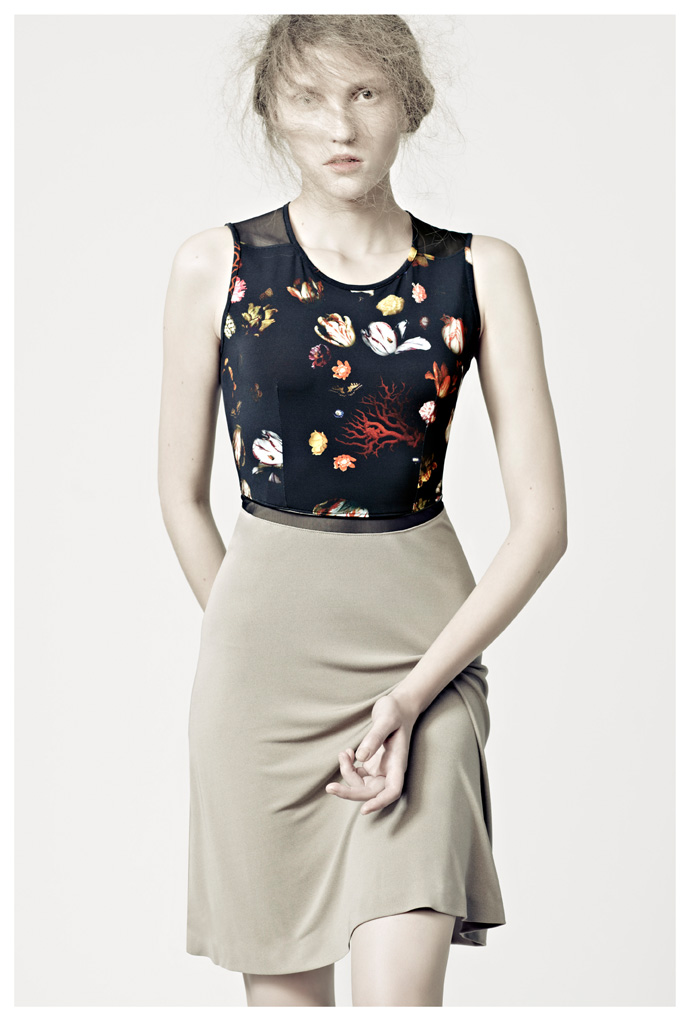
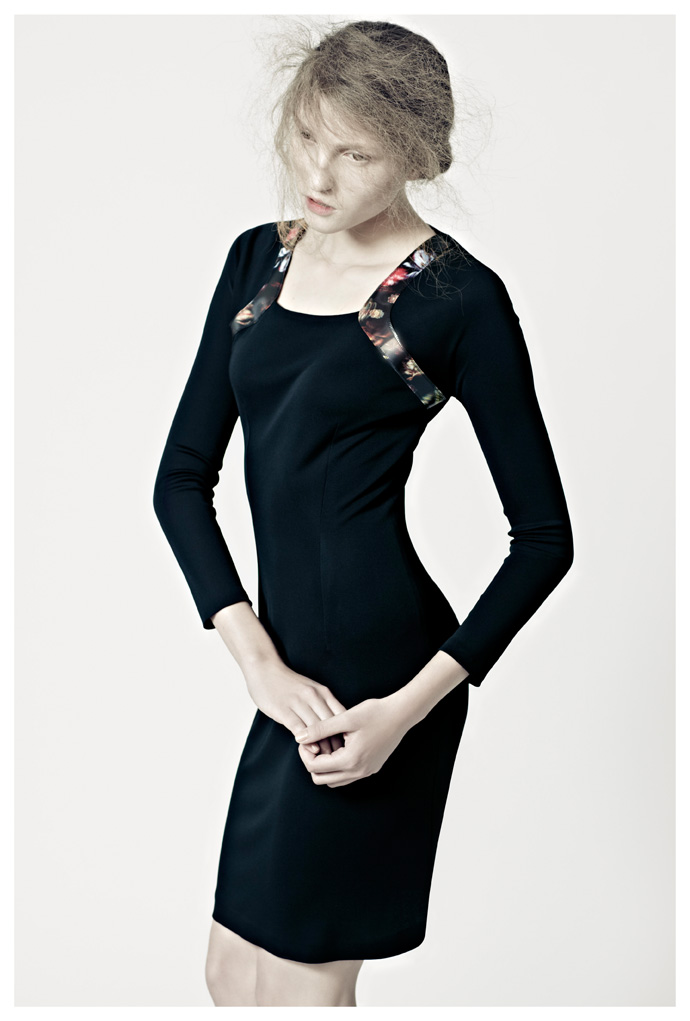 Marios Schwab resort collection 2012. Photography by René Habermacher
Marios Schwab resort collection 2012. Photography by René HabermacherShall we move to the next question? (Laughs). It’s interesting because it’s changing and its not changing at all. I think what changed is the way we get informed, how we advertise, and talk about things, how we buy things.
Everybody has a question mark about what they are doing these days…
The non-interesting part of this global change is throughout this financial downhill, the how quickly we gain information around us can make things very boring and very …
Things are supposed to be fast in fashion and although it seems that way, there is no new development in music and so many other creative sectors; and that is a shame because people stopped thinking unnaturally and they want to get into so many different characters since there are surrounded by so much information and don’t know how to handle it. They don’t have the time to study the new, see it from a distance, observe it, analyse it. It’s not a concrete period, there’s no certain opinion about things. You want to dive into so many different things because you have no other option.
It takes one bad collection to take a designer out of the spotlight you think?
I don’t know how it is but I wouldn’t see it that way I don’t know. You can have a bad collection because you decided to go on extended holydays and have a bit of a life.
Its interesting to mention that fashion can be such a fluff in the air. People think Balenciaga is amazing and next season they think Givenchy is the most interesting thing…sometimes it can become a little…I don’t know how to explain.. Do people have an opinion at the end? In previous decades or centuries this wasn’t much the case. Things were very specific. I’m talking about how people dressed, the way people reacted on fashion, art, their opinion…It was about dressing up your own way, to look pretty your own way and the way they looked upon things. Its not about buying the total look its about buying items from a collection in order to combine them with what you already have and make your look your own.

 Marios at his favorite afternoon stroll and part of his butterfly collection. Photography by René Habermacher
Marios at his favorite afternoon stroll and part of his butterfly collection. Photography by René HabermacherYou own your own company—nobody owns you. How’s that for a responsibility considering the reality of the fashion houses today?
I don’t think it’s necessarily a bad thing, no. The point is that our times as it is, its quite difficult to increase your team members, the structure, to tap into things you always dreamed of, like the way you want your company to spread out…
It’s not easy to do it by yourself without investment, or being helped by another source. It would be a shame to only be able to create clothes and not a whole product, that doesn’t only concentrate on fashion, not being able to communicate it right. Sometimes you don’t have the time or the money or both. But help must be welcomed.
I am curious to know, how many people work for you?
Hold on I need to count…Five full timers, mainly administrative and office work. I have one assistant that concentrates on fabrics and the boards.
Do you give chances to interns?
YES!! Yes!! Interns are so important, I like teamwork and when I refer to the team as always say “we”. It’s confusing for people. Who’s “we”?
I see myself as a craftsman, as I said before, I like to work within like a team that creates something that needs to be educated to us , to find our how its done and how its made and it takes a team of people that are special and committed to do that .
You can drive people crazy when you just give directions and not get involved in the making with them. For us especially, as we make all the samples in-house and it can get a little crazy. Students and the team that is here for years working with me seems like a family, we get emotional and fun and relaxed at the same time.
What I want from a student is to learn something special while running around in all the sections of the company, doing things, the boring jobs even,.. They need to have a complete idea on what it takes to be a designer because their time will come to open their own business.
Fashion is not a fantasy nor a party…
Do you ever let yourself go? Is there anything in your personality that you really have to keep a tight grip on?
The most important thing for me is family. They are part of what I do. My dad and mother enabled me to leave home at 15 to do what I wanted to do, feel free. They are critical about my work, which is very very important for me. Sometimes my mom doesn’t like certain things as she is a woman with style and she was the first who gave me the inside of quality and aesthetics.
In my private life I collect images I find beautiful. I like a variety of things, I love the impactful emotion when I sit on a beach somewhere in Greece, or sitting with old women on an island’s quiet little street, hearing them talk …Easy things and simple like that…
I like creating through emotion and experiences, history, the women I met n my life, their attitude, character. It can be very cinematographic. I build up a whole fictional character, created from my acquaintances with different women throughout my life.
What was the last thing that Stimulated you?
…my boyfriend..
-

-

LIFE AND DEATH OF MARINA ABRAMOVIC – LAST REHEARSAL
-Marina, Willem, Bob, Carlos and the Serbian girls.
Only a few more hours left to marinate, before the feast.The stage doors. The note is to be taken very serious. Photography by René Habermacher.
Today Marina had her shaman coming from Santa Fe, New Mexico, in order to clear any bad spirits in the theater.
Magick is in the air, the mood has eased the morning following the preview.
Some eruptions excluded.Willem Dafoe noting remarks on his text. Photography by René Habermacher.
Preparations in the Make up rooms. Photography by René Habermacher.
After all, the puzzle of endless rehearsed scenes makes sense now, its emotional power in effect to captivate both spectators and cast.
As the premiere nears, the ticket office and press department whirl faster.
During breaks, we hear big names to will attend.
They have to be seated the right way. Tickets are limited and getting sparse.Carlos Soto. Photography by René Habermacher
Marina Abramović and Antony Hegarty. Photography by René Habermacher.
The Serbian girls, that form the chorus with peasant songs, cook and cater everyone with traditional baked beans.
The longer they marinate, the better they are supposed to get. Though the longer you leave the beans to marinate, the higher the risk of having your portion snapped away – perhaps we should put name tags on the glasses in the backstage fridge?
Anyway, it’s all about MARINAting. The effect is, it melts on the tongue….
Marina riding on her wooden horse Bruno. Bruno is a darling, but not too comfortable... Photography by René Habermacher.
Svetlana sings the chorus while the soldiers shout parts of Marinas artist's manifesto. Photography by René Habermacher.
Life And Death Of Marina Abramovic
at Manchester International Festival
July 9 – 16, 2011. -

LIFE AND DEATH OF MARINA ABRAMOVIC – III
-“An artist should not make themselves into an idol”
Marina's commandment III. Photo by Lynsey Peisinger.
MINI-MARINA
Mini-Marina is a doll that wears Marina’s own, real hair.It just flew in from New York City.
The costume department is working on dressing Mini-Marina for the premiere…
Life And Death Of Marina Abramovic
at Manchester International Festival
July 9 – 16, 2011.
